Everything You Should Know about Travel Risk Management

As I wrote this tutorial, I kept thinking about Bilbo’s warning:
“It’s a dangerous business, Frodo, going out your door. You step onto the road, and if you don’t keep your feet, there’s no knowing where you’ll be swept off to.”
This document started off as a simple highlights list for travel risk management (TRM), but during the writing process, it became an in-depth tutorial encompassing most areas within TRM. The document can now be seen as a guide to implementing your first travel risk management program with some interesting anecdotal facts for the more experienced reader.
I would like to send a special thank you and express my deep appreciation to Bruce McIndoe, the founder of iJet/WorldAware, for his valuable input. Bruce is a legend within the industry and one of the most knowledgeable people within Travel Risk Management. This tutorial was greatly improved thanks to his insightful feedback.
Andreas Rodman, Co-founder Safeture


What is Travel Risk Management (TRM)?
The ISO standard 310301 for Travel Risk Management defines travel risk as the “effect of uncertainty on objectives due to travel,” which sounds very clinical. I prefer to say that travel risk management (TRM) is about making work-related travel safe for employees, consultants, contractors, interns, expats, and all other types of personnel. TRM is a big collection of processes and tools that involves many aspects and functions.
In this whitepaper, I will provide a bit of guidance on what I believe are the most important components and how they could be set up, such as travel approval , booking process , travel policies, pre-travel information, education , insurance, locating employees , emergency communication, emergency assistance , security aspects, medical aspects, and more.
TRM itself is part of a broader area of risk management related to personnel and is sometimes referred to as people risk management or employee risk management. With the strong positive trend towards remote work , allowing employees to work from anywhere , the definition of work-related travel becomes fuzzy. However, in this paper I will focus on the classic definition of TRM. I hope to discuss the broader aspects of people risk management in future articles.
I’m New to TRM; Where and How Should I Start?
There is an extensive ISO standard for TRM called ISO 31030 that I will refer to repeatedly in this whitepaper.
However, if you are looking at setting up a TRM program for your organization and you have no previous TRM experience, then I strongly recommend using an external TRM supplier . TRM programs can range from simple to extremely complex depending on your organization’s needs, and the ISO 31030 standard provides poor guidance for non-experts on understanding your specific needs.
On top of that, TRM is a vast field that requires extensive knowledge and many types of functions. Therefore, implementing and maintaining your own TRM solution all by yourself can be very expensive.
Fortunately, there are many TRM suppliers in the market with tons of experience. TRM suppliers often have solutions designed for different types of organizations ranging from small one-office firms whose employees travel a few times per year to large international organizations with thousands of travelers each month.
TRM Framework
Many different frameworks can be used to structure a TRM program. Which framework you select, or whether you select one at all, is not important. What is important is that you include the most crucial parts of a TRM program. Thus, the primary purpose of a TRM framework is to guide you in including these necessary aspects.
For the sake of clarity, in this tutorial I will use the ISO 31030 TRM framework that refers to the ISO 31000 standard because it is part of an official standard, even if other frameworks might be simpler to use.
This tutorial will focus more on setting up a TRM program and less on main-taining the program. Following the ISO 31030 standard framework, this setup focus means primarily looking at “Leadership and Commitment,” “Design,” and “Implementation,” which can be seen in the framework image (Figure 1).

Download the e-book here
A tutorial on Travel Risk Management.
Why Is There a Need for Travel Risk Management?
The need for travel risk management is driven by several factors:
- Legal responsibility (duty of care)
- Moral responsibility and employer ethics
- Retaining and attracting employees
- Other factors
The commonality among all the drivers above is that they begin with the leadership of the organization. This is why “Leadership and Commitment” is at the center of the TRM framework shown in Figure 1.
Legal responsibility (duty of care)
In most countries, the organization as an employer has a responsibility to care for its employees during work. This responsibility extends to work-related travel since travel is part of the work assignment, and the responsibility remains with the employer even if the person is doing their work in a different location.
For non-employees such as consultants and contractors, the responsibility is less clear and varies, but for simplicity’s sake, in this whitepaper, “employees” will mean both employed and non-employed personnel unless stated otherwise. Similarly, “employer” or “organization” will mean the legal party responsible for assigning work tasks to a person, no matter if the agreement with the person is through an employment agreement or a different type of agreement.
Duty of care is a term often associated with travel risk management. Duty of care in TRM has not been clearly defined, but a good description is the employer’s legal and moral responsibilities for employees during work-related trips.
Legal responsibility means employers in many countries may be liable for damages if an employee is injured or killed during a work-related trip . A properly executed TRM program provides a legal defense if that happens.
Moral responsibility and employer ethics
Moral responsibility and employer ethics involve the employer ensuring, as a fundamental decency when sending an employee to a destination, that the destination is safe, the trip is safe, and that if something were to happen at the location, the employer will assist the employee.
Retaining and attracting employees
Retaining and attracting employees is part of employer branding, and it is crucial to be seen as a good and caring employer in order to keep existing employees and recruit new people.
Of these factors, legal resonsibility is the most prominent driver behind companies implementing a TRM program.
Legislation and legal cases
The legal responsibility of employers to care for their employees is old and well-established in most countries. Many countries today have extensive duty of care legislation on how to protect employees, subcontractors, and other types of workers.
The duty of care laws and the formal legal responsibility for business travelers varies depending on the local legislation, but it is a common trait that countries with strong labor laws usually have stricter legal demands regarding travel risk management.
Although it is rare that companies face legal penalties, there are multiple legal cases where employers have been fined or paid damages due to lack of TRM when an employee or worker has been injured or kidnapped, died, or has had some other major incident during work-related travel. By implementing a proper TRM program , the employer can appropriately manage the legal responsibility , and the risk of having to pay damages or fines is mitigated.
For example:
- A French subcontractor named Thierry died in a terrorist attack, and the company, which did not have an adequate duty of care program for expats working abroad, had to pay 129,000 EUR in damages.
- A Norwegian NGO had to pay 420,000 EUR in damages to an employee named Steve Dennis for failing in its duty of care .
- An American student got a tick-borne disease resulting in life-altering neurological damage during a school trip to China. The school then paid 41.5 million USD in damages due to failure in the travel duty of care. This case went up to the U.S. Supreme Court , which ruled in favor of the student, thereby cementing the legal grounds that U.S.-based organizations are liable for damages when failing in the area of travel risk management .
Since legal penalties are rare, albeit steep when they are applied, many organizations unfortunately believe that the legal demands for a safe workplace only apply when the employee is working in the physical facility used by the organization (store, factory, office, etc.). However, workplace laws apply to the location in which the employee needs to perform their work tasks, no matter where that may be.
This means if the work includes travel, then the car, train station, train, airport, airplane, taxi, hotel, and final travel destination, including the restaurant for dinner in the evening, are all part of the employee’s workplace, and it is the employer’s responsibility to make sure the employee has a safe work environment throughout all parts of the trip, including to and from the destination.

Unclear legal responsibility boundaries
Bleisure travel.
In many countries, the employer is responsible for the employee 24/7 from the second they leave their home for work-related travel until they are back at home. This creates a complex situation when the employee is doing leisure activities during their work travel, and the situation is so common that the term “bleisure travel” has been minted for travel that combines business and leisure activities.
Bleisure travel requires clear organizational policies that define the lines of responsibility between work and leisure activities. Travel insurance is also affected by bleisure travel; the organization’s travel insurance company, in many cases, will not cover costs for incidents resulting from leisure activities during work travel.
Managing the entire risk
After an organization has grasped the legal responsibility of work travel, a common mistake is implementing a TRM program that only covers the most common travel risks, thereby still exposing the organization to the risk of legal damages for less common risks. This will be discussed further under the section “Inadequate solutions” below. Even in the U.S., where worker’s compensation insurance is considered ironclad protection, there are, in fact, gaps in the worker’s compensation insurance related specifically to work travel.
Remote worker trend
It is also interesting to note that as the remote worker trend grows , the employer’s legal responsibility for out-of-office work is becoming blurred. For example, in a case in Germany, it was considered a work accident when an employee tripped while walking from his bedroom to his home office in his own home.
Business drivers
Duty of care compliance.
The main business driver for establishing a TRM program is duty of care compliance. Corporate management often decides to establish and maintain a TRM program to mitigate the risk of lawsuits or other damages.
Historical incidents
A common catalyst for implementing or improving a TRM program is having a problematic incident. After the incident, the organization looks at what happened depending on whether there was a TRM program in place or not. If there was no TRM program, then the incident often becomes the starting point for establishing a TRM program.
If there was a TRM program in place, then an evaluation begins to understand what went wrong and what went right, which often results in strengthening the TRM program. These types of incidents often involve a single employee who was severely injured, exposed to a major risk, or kidnapped abroad.
Some organizations operate in high-risk areas, resulting in frequent incidents. These organizations often have extensive TRM solutions since they have a long history of incidents and know that the probability of having new incidents in the future is high.
For example, companies providing infrastructure solutions such as power supply and mobile communication need to operate all the time, in all areas, including conflict zones and natural disaster areas . The irony is that these types of companies often bring employees into these high-risk areas to rebuild infrastructure as other organizations evacuate employees from the same area.
Employer ethics
Some TRM programs are driven more by ethics and organizational culture than by compliance. Organizational ethics originate from top management. This means that top management believes that protecting its people is part of the organization’s core values, and the organization is prepared to invest resources into providing that protection.
This is often combined with other employee policies that allow the organization to be seen as a good and caring employer. Ethics-driven TRM programs tend to be better implemented since they are often provided with more resources than required to fulfill the minimum demands for a TRM program.

Chapter 2 coming soon!
Want to read it all today? Download the full e-book here:
Also available as a physical copy. Order it here!

TRM Solutions
The ISO 31030 TRM framework shown above in Figure 1 begins in the center with Leadership and Commitment. When top management is committed, it results in understanding how to integrate a TRM program with the organization’s daily needs, which is then followed by designing and implementing the TRM program.
Looking specifically at design and implementation, there are a vast number of ways to design and implement a TRM program that results in many different solutions to fulfill the needs of your organization.
To give you an overview, I have listed some common solutions and categorized them into two groups:
- Inadequate solutions are solutions that provide some level of TRM but, in many experts’ opinion, will not fulfill your duty of care and leave you open to lawsuits and other financial risks. These are also solutions that are poorly aligned with good employer ethics.
- Adequate solutions are solutions that provide good protection for your traveling employees and align well with strong employer branding and good employer ethics.
Inadequate solutions
Only insurance.
The most common TRM solution today is to have only insurance, such as travel insurance, which is the standard solution for smaller organizations.
Even though insurance is a good start and a necessity in a TRM program, it is unfortunately not enough. Smaller organizations usually do not realize that they need more because having few employees means the probability of something happening is low, and when it does, small organizations are often flexible enough to manage the problem ad-hoc. However, even if you can manage things ad-hoc using only travel insurance, you will not fulfill your duty of care, and a major employee incident abroad might have a severe financial impact on a small organization.
Travel insurance, or similar, offers good coverage of medical emergencies and provides employees with a number to call in case of a medical emergency. However, for non-medical incidents, such as natural disasters , kidnappings, physical threats, hotel burglaries, robberies, civil unrest, political conflicts, chemical accidents, etc., standard travel insurance does not provide any help unless the employee is injured in the incident.
Additionally, some types of medical incidents, such as pre-existing medical conditions, alcohol-related accidents, or injuries from risk-prone activities (riding a motorbike, extreme sports accidents, being injured when traveling to destinations against government recommendations, etc.), are often excluded from travel insurance.
The fact that travel insurance does not cover many types of frequently occurring incidents is the main reason why it is not enough to only have insurance and why organizations need to add more to their TRM solution to provide proper risk coverage.
If an organization only has travel insurance, then the organization is at high risk of paying damages and other related high costs for work-related travel. Adding to the issue is employer branding; the organization carries the risk of becoming known as having poor protection for employees who travel for their work.
Basic managed solution without assistance
Basic managed solutions without assistance are commonly found within mid-size companies where a manager or a small group of managers are equipped with only a travel tracker and travel insurance.
The key component in creating a managed solution is to keep track of all work travel. Common solutions include assigning a designated travel management company (TMC) to book all travel or having an internal travel manager arrange all travel. A travel tracker is added to the solution that enables the management to search and list all booked travel to help the workflow.
This setup allows the people responsible for TRM to look up who has traveled or will travel to a destination in case something happens, such as a natural disaster , conflict, or similar. The travel tracker allows the organization to answer the question, “Who do we have traveling there?” The setup should specify who is responsible for managing the situation when an incident occurs, which means that there will be a designated contact person for the employee.
A common problem with the setup of basic managed solutions without assistance is that the managers responsible for travel risk often have many other responsibilities, which means they are not available 24/7. Thus, they lack the resources and local contacts to assist employees on the ground in faraway countries. The result is, therefore, that it can take days for an employee to reach somebody to assist them, and when they do, the organization has difficulties helping them.
Since this setup often results in a poor and slow response that is ad-hoc or, in the worst case, no response at all, it is considered by many experts to be a solution that does not fulfill your duty of care and thereby has less protection for your employees and your organization.
Organizations that have selected a basic managed solution without assistance understand that travel insurance is not enough but have unfortunately invested too few resources to implement a proper TRM program. As shown in the ISO 31030 TRM framework above, it all begins with Leadership and Commitment in the center, which then translates into the integration and design of the TRM program.
Please note there are TRM implementations that may look like an inadequate solution on the surface but are, in fact, proper comprehensive solutions. The difference is that such solutions are implemented by organizations that have invested a lot into building a fully working 24/7 internal TRM assistance team with all the necessary associated processes. We will touch upon several of those processes in the section “Comprehensive managed solutions.”
Adequate solutions
Managed solution with only reactive assistance.
When an organization wishes to establish a good and adequate TRM program, a common approach is to buy a complete TRM solution from an external assistance provider .
Large organizations have the resources to build the entire solution internally, but TRM is complex and expensive, which results in most organizations selecting a fully or partially outsourced solution. It is also common to use multiple outsourced suppliers and combine them into an improved solution.
When selecting an outsourced solution, consider that the assistance provider must be able to manage both medical emergencies as well as security emergencies to properly fulfill your organization’s duty of care. Most assistance providers focus on medical or security, which is why some use multiple assistance providers. When combining assistance providers, clear processes need to be established, such as who is responsible for a case and how to migrate or coordinate cases between the assistance providers.
Outsourced managed solutions are popular since the organization can push much of the TRM responsibility to a sub-supplier, which minimizes the amount of work and knowledge required within the organization.
Below are some important checkpoints to verify the compliance of an external assistance provider offering a TRM solution. The provider(s) should be able to provide the following:
- 24/7 medical emergency assistance
- 24/7 security emergency assistance
- Established processes between all the active parties
- The medical assistance provider should be able to cover medical costs directly for medical assistance abroad and then manage the cost claims later with the insurance company or whatever the situation requires.
A managed solution with only reactive assistance is considered adequate from a duty-of-care perspective . However, its main disadvantage is that actions are taken after employees request assistance. This means that these solutions focus on managing incidents after the incidents have occurred. In other words, these TRM solutions are only activated if an employee reaches out to the assistance provider.
More comprehensive solutions, described below, focus on preemptive work by preventing employees from being exposed to risks or acting proactively when the risk changes due to some unforeseen event.
Comprehensive managed solutions
Comprehensive managed solutions look at all risks and create risk mitigation solutions for all travel phases ranging from travel planning to returning home.
The ISO 31030 standard provides a good complete list of everything you could want from a comprehensive solution. However, that list is very long and expensive to implement. In this section, I will highlight some of the key features I believe to be the most important and should be the foundation for a comprehensive solution. In my opinion, managed comprehensive solutions need to be automated as much as possible. Automation will keep the cost down and increase the quality since manual TRM tasks tend to result in human errors or be down-prioritized due to the high workload.
A work-related trip can be divided into three phases:
- Before travel, commonly called pre-travel
- During travel
- After travel
Comprehensive solutions often focus on the pre-travel processes with the rationale that the best solution is to not be exposed to risks at all and prevent incidents from happening in the first place through good planning and preparation. By focusing on the pre-travel, incidents can be avoided, for example, by planning a secure travel route and itinerary, adding secure travel services, education , vaccinations, accommodation selection, or even canceling the entire trip.
Comprehensive solutions are common for large international organizations or organizations with operations in high-risk areas. To quote a large international provider of essential infrastructure, “We never evacuate, we only relocate”—meaning that they move employees to safe areas within a country before a local conflict expands, thereby avoiding incidents even when they operate in countries with ongoing conflicts.
Pre-travel processes
Pre-travel processes include many different methods of risk avoidance and risk reduction that prevent or minimize the risk of the employee having an incident at all.
The methods below are effective, not too complex to implement and maintain, and often used by large organizations:
- Automated integration between travel bookings and country risk levels to trigger travel approvals
- Pre-travel authorization
- Travelers registering with the TRM platform before departure
- Pre-travel medical approval
- Traveler safety and security e-learning
- Pre-travel and en route alerts
- Informing about country risk and related travel information
- Additional prebooked travel services
Automated integration between travel bookings and country risk levels
In an ideal world, all work-related trips should be reviewed and approved from a security perspective before any bookings are made, which is called pre-travel authorization. The reality is that few organizations have the resources, tools, and discipline to run an approval process before every trip is booked.
To be able to automate the pre-travel authorization process, a common solution is to categorize every country by risk level. The country risk level is then correlated with the travel bookings, so only bookings to high-risk countries trigger a pre-travel authorization process. With this automation, management can automatically filter which bookings should be scrutinized for pre-travel authorization.
For this type of integration to work, the organization needs to use both designated and integrated travel management companies or apply other tools to detect travel bookings. (These tools are discussed in the section “Outside travel policy bookings.”)
- Pre-travel authorization
Pre-travel authorization, commonly called “pre-trip approval,” evaluates the travel plans from a security risk perspective to see whether the plan follows the TRM policy.
The approval process should look at all types of risk aspects, including destination, means of travel, accommodations, medical conditions, etc.
Pre-travel authorization from a travel risk perspective can be difficult to implement because the manager approving the trip from a business perspective is usually a completely different person than the person approving the trip from a travel risk perspective. Managers often approve trips from a business perspective without any understanding or thought of the travel risks. By integrating travel bookings and country risk levels, pre-travel authorization processes can be automated and thereby bridge the gap between the business perspective and travel risk perspective.
When integration is in place between booking and country risk levels:
- Designated travel management companies can block bookings to high-risk countries unless a pre-travel authorization is provided from a travel risk perspective; or
- A notification of the high-risk booking can be sent to the group responsible for pre-travel authorization.
The second option, with notification of all high-risk bookings, is the more common solution since it is easier to implement and requires less discipline, and is, therefore, more reliable. It is also the only solution that can automatically manage pre-travel authorization for out-of-policy bookings (see the section “Outside travel policy bookings” below).
When the group responsible for travel risk approval receives the high-risk booking notification, a process begins that usually includes initiating a dialogue with the traveler and the traveler’s manager to verify that the trip is necessary. The responsible group also starts all preparation required for traveling to the area, such as meet-and-greet , education, medical approvals, etc.
Travelers registering with the TRM platform before departure
Having the traveler register with the TRM platform is often called employee onboarding and is a crucial part of implementing a successful TRM program.
The onboarding is a process that includes many components, and it is work that never ends. New employees need to be onboarded, and old employees might need to be onboarded again because they have forgotten what to do, lost the necessary information, or lost access to the TRM platform.
Some organizations set onboarding as a policy requirement for all work travel; others, unfortunately, treat it only as a recommendation.
Onboarding processes often include tasks like:
- Sending out instructions, information documents, and videos about the TRM solution and how to register with it
- Collecting employee contact information and other data to populate the TRM databases
- Informing employees to use a specific travel management company to guarantee that all bookings are collected by the TRM solution
- Distributing assistance cards for the traveler to have in their wallet
- Installing mobile apps connected to the TRM solution
- Integrating with human resource management systems or identity platforms to automatically collect employee data into the TRM solution
- Integrating a designated travel management company to receive copies of all travel bookings into the TRM solution
A good tip for achieving a successful TRM program is to have a structured onboarding process that is motivated by a clear travel policy demand.
Pre-travel medical approval
The second most common type of travel incident is health-related (travel disruptions being the most common).
A comprehensive solution can therefore assess whether a traveler is fit to travel from a medical perspective before departing to reduce the travel risk. This is especially important when the travel destination is an area or country with poor medical capabilities.
A good medical approval process should block travel if the traveler has medical conditions that are difficult to treat at the destination or could become critical due to the trip. Some work travels take the traveler far from major cities. So, even if good medical treatment exists within the country, the nearest adequate hospital might be very far away.
Medical approvals include challenges related to privacy rights. Employees are often reluctant to share medical information with their employer, and this type of personal data is classified as highly sensitive in many countries, requiring specific forms of collection and storage.
One solution to this problem is to use an external third-party travel approval provider that keeps all patient data confidential and only informs the employer about whether or not the employee is fit to travel to the destination. Pre-travel medical approval will also help mitigate the risk of insurance not covering medical care abroad for pre-existing conditions.
Traveler safety and security e-learning
The best solution for preventing incidents during work-related travel is educating travelers on different risks and how to manage them.
Work-related travel is often complex and involves unique situations, making it impossible to prepare for all types of incidents that can occur. By increasing the traveler’s understanding and knowledge, however, many of these risks can be detected and avoided by the traveler during the trip.
Some organizations do traditional instruction-led education before the trips, but to create efficiency in the TRM program when there are many travelers, an e-learning solution can be used.
E-learning can include a test assessment phase to check if the traveler has understood the information. The results of the assessment can then be tied to approval phases or notifications so a traveler cannot travel to a destination without doing the e-learning courses and fulfilling the assessment criteria.
Pre-travel and en route alerts
It can be very valuable to receive information when something is happening or will probably happen at your planned destination before departure or during your travel to the destination. This is often called “pre-travel,” “pre-trip,” or “en route” alerts.
For example, knowing before departure that a tropical storm will occur, that a curfew has been ordered due to growing civil unrest, or that a disease outbreak is happening at the destination will enable the traveler to reschedule the trip to avoid the risk entirely. Similarly, if there are terrorist attacks at the destination while the traveler is en route to the destination, the itinerary can be changed on the fly to avoid lockdowns and other temporary restrictions due to the attack.
High-risk pre-travel and en route alerts should be sent both to the traveler and to management (e.g., the security manager or travel manager).
Informing about country risk and related travel information
Providing country risk and related travel information to the traveler is a valuable educational tool similar to e-learning.
If it is easy to access and read information about a country, it will enable the traveler to read up on common risks and how to behave in a country to reduce the risk of an incident. Educating the traveler is one of the best tools to avoid incidents.
A common mistake within travel risk management is not understanding the difference between country risk information provided to a security manager and generic country risk information given to an ordinary employee who is traveling. The information to the traveler should include more than just security risks.
Good country risk information also includes environmental risks, medical risks, major legal and cultural differences compared to other countries, and how to behave in that country to minimize the risk of an incident. The information should also be shorter, more generic, and assume less knowledge of the reader than, for example, that provided to a security manager.
Risk intelligence providers commonly provide extensive and detailed risk information on each country, with the target audience being security managers, travel managers, or other roles that are typically part of a travel risk management group.
For a traveler, the level of information given to a security manager is too detailed and too extensive. A traveler needs a very condensed and quick read about the major risks and how to avoid them. If the information is too long, the ordinary traveler will not find the time to read the information and, even if they do read it, will not remember the information.
The country risk information should be so condensed that a traveler has time to read it in the passport line at the airport and should not require any previous knowledge about the situation or country.
Example: Fire in Ghana
- Alert to Security Manager (Web Portal)
- Alert to Traveler (Mobile App)

Additional prebooked travel services
There are many travel services that can be added when planning travel to reduce the risk of incidents. One of the most common and effective services is booking secure ground transportation using known safe suppliers. For example, a simple “meet-and-greet” at the airport will allow the traveler to avoid the risk of getting into an unknown taxi with an unknown driver or ending up in a high-risk area when using public transportation.
A secure meet-and-greet service will remove not only the risk of robbery or kidnapping in that situation, but also the risk of lesser incidents such as scams (e.g., being overcharged for taxi fare).
Proactive assistance
Comprehensive managed solutions often include a proactive process for when an incident occurs.
The assistance center will proactively reach out to the employees in the affected area of a major incident to check if they are OK or need assistance . By using employee location information , the assistance center can compare all employees’ locations with affected areas to find out which employees they need to contact.
The proactive service also includes contacting employees planning to go to or on their way to the affected area. This is why it is important that a comprehensive solution automatically receive copies of all planned travel. Real-time location solutions such as mobile phone location provide detailed location data for finding out who is in the affected area, but real-time location data can’t look into the future.
Travel booking, on the other hand, will provide this insight into the future travel plans of the employee. Therefore, the best comprehensive solutions use a combination of real location systems (such as mobile phone location) and travel booking tracking for planned or ongoing travel.

Traveler alerts at the location
When a traveler is visiting a location for work, it is often difficult to understand what is going on locally from a risk perspective due to differences in language and culture. During work-related travel, the traveler frequently lives in a bubble, seeing only the airport, taxis, the hotel, and the workplace they are visiting. This means that if an incident happens, all travelers at the location need to receive information about the incident in a language they can understand .
To address this, comprehensive solutions often include a traveler alert functionality that pushes relevant information to the traveler based on their location. This is usually generic security and medical alerts about incidents in real time, but it is also common to include other types of relevant travel information, such as major traffic disturbances.
Chapter 3 coming soon!

Roles in a Travel Risk Management Program
Implementing a travel risk management program requires multiple roles and multiple stakeholders from several parts of the organization. In this section, we will describe the usual stakeholders and their roles.
Security role
The person responsible for a TRM program is often the security manager . Top management typically views travel risk management as a security task and therefore places the security manager as the owner of a TRM program.
The security manager’s role encompasses many things, and travel risk is just a small part of it. This can be a problem when creating or maintaining a TRM program, as security is often viewed as a non-revenue-driving cost and is thus frequently under-financed. For commercial organizations, a more suitable security perspective would be to view TRM as securing revenue and profit, like business continuity management.
Travel role
Large organizations often have internal travel managers, even if they are using external travel management companies. If there is an internal travel manager, he or she is most likely deeply involved in the travel risk management program since it is a crucial component of managing employee trips.
Smaller organizations usually do not prioritize resources for a dedicated travel manager, and in such cases, the common solution is that all travel management work is outsourced entirely to an external travel management company. Thus, a TRM program for smaller organizations seldom includes a travel role.
Human Resources
Travel risk management to fulfill a duty of care should be seen as part of employer compliance regulation, which makes HR (Human Resources) a crucial role. HR is most often involved during the integration and design phase of a TRM program or when a major incident happens.
Travel management
Travel management plays a central role in travel risk management. Travel management’s primary purpose is to assist employees in booking trips and is usually implemented using one or several external travel management companies (TMCs) or through a corporate travel department (CTD) within the organization.
One of the most common practices for building a solid travel risk management program is setting a policy stating that all employees should use a designated TMC or CTD. With a designated TMC or CTD, a TRM platform can automatically receive copies of all bookings. Even if there is no integrated TRM platform, it is still possible to retrieve copies of bookings by manually contacting the TMC or CTD.
TMCs and CTDs can also assist in the pre-travel authorization process and implement approval checkpoints and travel restrictions on behalf of the organization. (See the section “Pre-travel authorization” above for more information.)
Having a designated TMC or CTD in the travel policy is an important ground rule for TRM. However, even with a designated TMC or CTD, many bookings will be made by other means, which creates a problem if the TRM program relies entirely on employees booking their trips using the TMC or CTD.
The problem of booking trips via other platforms can be mitigated, and the travel policy still adhered to, by allowing the employee to forward the booking to the TMC or CTD, or even directly to the TRM system.
The real issue occurs when the employee books a trip on some other platform without forwarding the information, thereby breaching the policy.
There are multiple reasons why employees do not follow the travel policy, but these are the most common :
- The employee is not aware of the policy or finds cheaper tickets somewhere else.
- The employee wants to circumvent the travel policy with the purpose of receiving personal loyalty points with an airline or hotel chain.
- Someone outside the organization books the trip , such as a partner or a supplier to the organization.
- The employee travels using their own transportation, such as a personal car.
- The employee buys tickets locally at the departure site, such as a train station or airport.
This is called “out-of-policy bookings” and has been reported in some cases to be as high as 68% of the total bookings for the organization’s employees.
Another issue when using the designated TMC or CTD in a TRM solution is that the data that comes from the travel database often includes errors such as misspellings, missing data, or group bookings with only names . This causes problems during an incident because there might not be enough data in the travel database to identify the employees or their contact information. You can read more about this under the section “Bad travel booking data.”
The result is that even though the TRM or CTD has a crucial role and must be included in a comprehensive TRM solution, the TRM solution cannot exclusively rely on the data coming from the travel booking and must be complemented with other data and solutions, such as mobile tracking (this is described in more detail in the section “Mobile phone locator”).
Medical assistance provider
A medical assistance provider is a crucial supplier in a travel risk management program since health-related issues are the second most common type of incident for work-related travel.
If you have medical insurance coverage for your employees when they are abroad, you most likely have a medical assistance provider included in that insurance policy for employees to contact when they need medical assistance during travel.
The issue with only relying on the medical assistance provider in your insurance is that they are tied to the insurance policy, which means you might not get any assistance for incidents, medical or non-medical, that are not covered by the insurance policy.
In fact, medical assistance providers frequently try to minimize costs for the insurance companies in their agreements. Medical assistance companies use cost savings as a selling point in their marketing to the insurance companies. This is why you need more than just insurance to fulfill your duty of care for your employees, and you cannot solely rely on the medical assistance provider bundled with the insurance.
When implementing a managed TRM solution with assistance, the assistance provider must be able to handle both medical and non-medical incidents outside the limitations set by the insurance policies.
From the employer’s perspective, it is important to provide only one assistance number for employees to call in all types of emergencies. One cannot expect an employee in a stressful situation abroad to be able to sort out which assistance provider to call.

The most common solution here is to make the medical assistance provider the first point of contact for all types of emergencies, and then the medical assistance provider will bring in other suppliers if needed, such as security assistance.
Another solution is to have the assistance provider that acts as the first point of contact, such as a security assistance provider, evaluate the call and connect the employee to the medical assistance provider for medical incidents. (Please see the section “Role relationships between emergency assistance providers, employers, employees, and travel insurance” for illustrations of different medical assistance setups.)
If the medical assistance provider is the first point of contact, the organization needs to have a direct agreement with the assistance provider and cannot rely on any indirect agreement through insurance since the medical assistance provider will be given the task of handling incidents sometimes not covered by the insurance policy.
Optimally, the medical assistance provider should have an agreement with the insurance company to manage insurance claims directly with them, or be able to coordinate with another medical assistance provider that has an agreement with the insurance company.
The reason for this is that during an emergency, the medical assistance provider should always guarantee the medical expenses and then manage the damage claim with the insurance company afterward. Since medical emergencies need to be managed immediately, it would be impossible to start a long bureaucratic process with the insurance company to accept the cost every time somebody calls with the need to go to a hospital in a foreign country.
Therefore, it is best if the medical assistance provider is approved in advance by the insurance company and an agreement is set up between them to take care of the claims after the fact. A useful tip here is to use well-established medical assistance providers because they often already have agreements with insurance companies.
Security assistance provider
Most work travel incidents are travel disturbances or medical-related. However, there are both pre-travel processes and real-time incidents that are security related, and in these cases having a security assistance provider is a necessity for properly implemented managed TRM solutions.
A common pre-travel security service is, for example, booking secure ground transportation. In high-risk areas, it is important to be able to move from one point to another, such as from the airport to the hotel or from the hotel to the meeting, in a secure manner.
When a security-related incident happens, it is also important to have security services like evacuations or access to local security personnel on the ground for assisting on site.

Role relationships between emergency assistance providers, employers, employees, and travel insurance
For a managed solution with assistance, there exist four basic role layouts:
- The first point of contact is both a medical and security emergency assistance provider. (Figure 2.1)
- The first point of contact is a medical assistance provider with a security assistance provider as a sub-supplier. (Figure 2.2)
- The first point of contact is a security assistance provider with a medical assistance provider as a sub-supplier. (Figure 2.3)
- The first point of contact is a 24/7 travel assistance provider, internal or external, that coordinates the appropriate medical, security, or other assistance services. (Figure 2.4)

For reference, below (Figure 3) is a typical inadequate solution that does not fulfill your duty of care since it uses only insurance and the medical emergency assistance provider included in the insurance:

Insurance companies
Although insurance companies ultimately only handle claims and cover costs, the insurance companies and their insurance policies are vital components of a TRM program and managing incidents.
By having an insurance company cover the costs and, more importantly, knowing the insurance company will cover the cost, the organization or employee can act swiftly. Otherwise, the cost question might stall the process or create uncertainty about how to manage an incident. For example, when an employee needs to seek medical care abroad, in the worst case, the employee might need to temporarily cover large expenses out of pocket, which they might not be able to pay.
A common service provided by emergency medical assistance is to guarantee payment to hospitals abroad for expensive emergency care. That is why the CDC (Centers for Disease Control and Prevention) recommends selecting travel insurance that makes payments directly to the hospitals.
To complicate things further, the structure of insurance for work-related travel varies widely between countries and even between insurance companies within a country.
For example, in Europe, it is common to need extra travel insurance to get medical care for employees abroad since domestic medical care is usually covered by the state, while in the U.S., some health insurances might, by default, include medical care abroad. On the other hand, European travel insurances usually include additional coverage such as lost luggage.
A common mistake that many organizations make today is not updating the travel-related insurance when the organization grows. For example, travel insurance is often tied to the country of origin and the number of employees. When an organization expands with more employees or opens an office in a new country, the existing travel insurance often does not cover those employees.
The recommendation is therefore to contact your insurance broker, or get an insurance broker if you don’t have one. Describe the level of insurance protection you want, where you have employees, how many you have, their travel and work patterns, and how the insurance should work with the TRM program. Then let your insurance broker do the heavy lifting by figuring out what type of insurance you need and from which insurance companies.
The complexity of insurance policies creates a high risk of your organization being underinsured in many situations, and it is important to understand the exemptions in the policies. For example, insurance might not cover pre-existing medical conditions that were known before travel, accidents during extreme sports, bleisure travel (mixing work travel with leisure travel), or non-covered high-risk countries.

The employment form of your employees is also a factor to consider. For example, some insurance policies include consultants while others exclude them. If the consultant does not have their own insurance to cover their work-related travel, you might end up in a legal battle over who should carry the cost. If you have consultants in your organization, either your insurance needs to cover your consultants or you need to have checkpoints to ensure the consultant has their own TRM program or travel insurance that is compatible with your TRM program.
Travel insurance policies are commonly sold in packages per trip, per employee, or for the entire organization. It is my strongest recommendation to select travel insurance that covers the entire organization all the time. It is easy to miss buying travel insurance before employees depart on a trip abroad, or to miss that the insurance only covers select employees.
The primary goal of the insurance setup from a TRM perspective is to make sure that incident processes work efficiently. It is important that cost coverage and payment setups be in place, as lack of such setups could delay, block, or otherwise be detrimental to the incident processes in the TRM program.
The recommendation here is to get help from an insurance broker. Inform the broker of what your entire organization looks like and how you plan to design your TRM program, and ask them if there are any insurance gaps that need to be covered with additional insurance.
Sometimes the terms “risk” and “threat” are used interchangeably, even though they are two different things. A threat is something that might become a risk if the employee is exposed to the threat. For example, some areas in Mexico are known for the high threat of being kidnapped, but if no employee ever visits these areas, then there is no risk for the organization from that threat.
Kidnap and ransom insurance
“Kidnap and ransom” is a special type of insurance that is seldom included in travel insurance and needs to be purchased separately.
Kidnap and ransom insurance can be crucial for large organizations operating in countries with high risk of kidnapping. In order to be valid, kidnap and ransom insurance must be kept classified from the employees so that the existence of the policy does not entice kidnapping. It is also important to note that in some countries, kidnap and ransom insurance is not legal; therefore, it might not be possible to purchase such insurance.
Threat intelligence provider
A threat intelligence provider, also called a “risk intelligence provider”, is needed to understand the risk in travel risk management.
The threat intelligence provider makes frequently updated threat assessments of countries and regions. Most providers also offer a real-time 24/7 alert service for time-critical threats. Some of these providers can correlate the organization’s risk exposure and thereby provide the actual risk, such as correlation with facility locations , employee locations , or special types of operations within the organization (e.g., maritime activities). The threat intelligence provider can be purchased as a standalone provider or, in many cases, as an integrated service with other security services or even integrated with the TRM solution.
The threat intelligence provider is a crucial component of the risk assessments that determine which countries or areas employees may travel to and what security preparations need to be done before departure. The 24/7 real-time alert service is also critical for proactive assistance in case a threat develops. If a traveler is in the area or plans to go to the area, then it is important that they receive these real-time alerts to act quickly to mitigate the threat.
The organization’s management has the most important role of all in a TRM program since a TRM program is only as successful as the commitment of the management. The ISO 31030 framework puts “Leadership and Commitment” in the center of the framework connected to everything else since all other work and results depend on these two factors.
Failed implementations of TRM are mostly due to poor commitment from the management. One of the most common issues here is that management decides to implement a TRM program without allocating the required money or resources. This means TRM falls into the same business pit as most other types of security by being seen as a non-revenue-generating cost that should be minimized until the day something goes seriously wrong.
One should see the role of the management as that of the internal buyer; if the buyer (i.e., management) is not ready to pay for good quality, then it will not be possible to deliver good quality. If the TRM program is of poor quality, then the management will not fulfill their duty of care , and the organization might face financial and reputational damages. Such damage will ultimately be the responsibility of the management, caused by their unwillingness to provide proper protection for employees to save costs.
The tip is to focus on buy-in from the management by explaining that a good quality TRM program is required to fulfill the duty of care and that, to build such a program, TRM must be given its own financial budget and clearly marked allocated resource time.
Crisis team
When an incident occurs that affects traveling employees, several tasks need to be managed and coordinated internally within the organization. Different processes are started depending on the severity of the incident and the number of employees affected. If the incident is of very high severity and affects many employees, then the organization’s crisis team is often involved. If the incident only involves a few employees, which is typically the case for TRM, then the TRM response or assistance team usually handles the incident without any involvement from the crisis team.
The crisis team handles much more than just travel-related crises since employee travel is just one small aspect of crisis management work. However, if a major disaster occurs abroad, the crisis team may have the responsibility of locating all employees in the affected area, including travelers, to check if they are OK. This means that the crisis team will sometimes need to work closely with the TRM team and use the TRM solution.

Chapter 4 coming soon!

Common Work Tasks and Processes within TRM
When implementing and operating a TRM solution, many work tasks and processes need to be in place.
Below are some of the more crucial tasks and processes that must be established for a proper TRM solution that fulfills your duty of care. For a complete list, please see the ISO 31030 standard.
Leadership commitment and communication
The success of the TRM program is dependent on the top management’s commitment, and the top management should make it crystal clear that all travelers must follow the TRM program. The best way to achieve this is to set an organization-wide policy that all travelers must join the TRM program, and that refusing to join can result in travel being denied.
The top management must also allocate the necessary funding and resources for the implementation and operation of the TRM program. Otherwise, it will become merely a paper product for rubber stamping compliance. Since TRM is often seen as only a cost from the management’s perspective, it is a common problem that a TRM program is put in place without adding new resources.
The required added resources can be budgeted funds for outsourcing everything to a TRM supplier or adding employees to perform the work internally (or, in the best case, a combination of both). Adding a TRM program without adding resources results in the TRM program becoming minimized and often ends with a poorly functioning TRM program that does not fulfill the duty of care.
The rollout process is about establishing the TRM program with the employees. Employees need to know what number to call in case of emergency, where or how to find insurance policy numbers, which travel management company to use for booking business trips, installing mobile applications , taking e-learning courses , etc.
The rollout process is the key to getting a good adoption rate for a TRM program. A common cause of poor rollout is not having the full commitment of the top management.
The rollout process itself is part of the implementation phase in the ISO 31030 framework and contains many different tasks depending on how the TRM program has been designed and the tools selected. A typical rollout includes:
- Informing all the employees
- Establishing processes within and between travel management companies, assistance providers, crisis teams, organization management, etc.
- Installation of tools, such as mobile applications, integration of the TRM platform, etc.
- Education of employees
A poorly done rollout process is often the reason for a TRM program being poorly implemented.
For a comprehensive solution, the pre-travel processes are the most effective processes to implement in a high-quality TRM program. Pre-travel involves many different processes depending on the TRM program setup, but common processes are:
- Booking processes using designated travel management companies
- Education and e-learning processes
- High-risk booking processes
These processes are explained in detail in an earlier section under “Pre-travel processes.”
If you are using an external emergency assistance provider, which is a common case, the assistance processes are tightly tied to the internal processes of that provider. Processes need to be established for efficient interaction between the emergency assistance provider, your own organization, and other sub-suppliers.
These can include the following processes:
- Proactive assistance reporting
- Reactive assistance reporting
- Assistance processes between medical assistance and security assistance if separate security and medical assistance providers are used.
Read more about the assistance processes.
Common Mistakes and Misunderstandings
The mistake of thinking travel insurance is enough.
It is a common misconception that it is sufficient to only get travel insurance or to use existing insurance that includes work-related travel and provide the employee with the insurance policy details. If the organization only provides standard work-related travel insurance and nothing else, then it will not fulfill your duty of care, and the organization is exposed to legal and financial risks.
The main reason why standard work-related travel insurance is not enough is that insurances have limitations on what is covered, and employees and organizations have no insurance coverage or assistance processes in place for events outside these limitations. Risks that work-related travelers are often exposed to are commonly excluded in the insurance (for example, pre-existing medical conditions, evacuations due to security and health threats , kidnappings, personal threats, cyber security attacks, natural disasters , etc.).
Travel insurance focuses on medical coverage for medical emergencies, followed by travel disturbances, one of the most common types of incidents during work-related travel. Additionally, travel insurance usually only covers the employee during work-related tasks. The effect is that if an employee calls the emergency assistance provided by the insurance for events excluded in the insurance policy, the employee might not get any assistance at all, and if they do receive assistance, it will be the responsibility of the organization or employee to cover the costs in the end.
After the big Fukushima nuclear disaster in Japan, which is the second largest nuclear disaster in the history of mankind, many business travelers were afraid of the radiation risk and wanted to leave Japan as soon as possible by booking very expensive flight tickets. When the travelers were home, many organizations and employees were surprised to find out that their insurance did not cover the evacuation costs. If they covered anything at all, the insurance would only cover the evacuation trip home if a traveler had been afflicted with radiation poisoning, and not for the possible risk of radiation poisoning.
The Fukushima event is a glaring example of how travel insurance is not enough and how chaotic an incident can become when there is no proper TRM program set in place by the organization.
The misunderstanding that mobile phone location tracking is privacy-invasive
It is a common misunderstanding that mobile phone location tracking for a TRM solution must be privacy-invasive. There are solutions to guarantee the employees’ privacy and thus gain their trust. It is done by limiting the organization’s access to the location data to prevent any type of misuse.
Employees usually accept that the organization knows the details of their flight, train, or hotel booking, but are often more reluctant to share their mobile phone location. It is an understandable fear because real-time mobile phone location tracking can be misused by the organization to spy on the employee. It is therefore important to add privacy mechanisms to the mobile phone tracking solutions to guarantee the privacy of the employee.
TRM platforms today contain different types of privacy filters to protect employee privacy. Some examples are:
- Location data can be obfuscated to a grid, like 10×10 km.
- Employees can set an obfuscation area of the location or turn the location off.
- It is also possible to protect privacy through an agreement setup by using an external emergency assistance provider that is the only party that can access the mobile location data.
Common Problems
The culture in the organization and strong personal opinions are common obstacles to a TRM program. Below are some of the more common cultural problems.
Explorer mentality
Many work-related travelers are seasoned travelers that have traveled for many years and have been exposed to high-risk situations without any TRM program. These travelers may view themselves as daring explorers that are used to the risks, accept the risks, and have a history of managing everything by themselves. These experienced travelers might feel that following the TRM program is like having a babysitter and is unnecessary for them due to their experience.
Outside travel policy bookings
A crucial function of any good TRM program is that the TRM solution covers as much work-related travel as possible within the organization. This is mainly achieved by using designated travel management companies.
However, even when such a booking policy is set in place, many do not follow the policy and book using other means. Common reasons are finding a cheaper ticket online, booking on the fly, the traveler wants to select a specific airline to get loyalty points, travel management being unable to make the booking, the travel management company being slow or not having 24/7 service, or the employee simply being unaware of the policy.
Whatever the reason may be, outside travel policy booking is a big problem. The most common solutions for outside policy bookings are:
- Add a mobile location solution so if the employee books outside the designated travel management company, it will still be possible to locate the employee using the mobile phone.
- Have the TRM system read booking confirmation emails. The employee can forward a copy of the booking confirmation email to a designated email address. The TRM system will then automatically look through the booking text and add the booking into the TRM system as if it was booked by the designated travel management company. It is also possible to set up automatic filtering of all incoming emails, so if an email originates from an online booking agency, the TRM system will automatically add it to its travel booking database.
The most common technical problems in TRM solutions are:
Bad travel booking data
Mobile phone location tracking not working.
- Incorrect or missing data on employees, such as name, phone number, email, etc.
The International Air Transport Association (IATA) 13 provides a standard called IATA Resolutions and Recommended Practices Directory . 14 The standard resolution 830d, which is binding for all IATA members, describes the requirement for the PNR data entry. When there are issues with bad travel booking data, it is commonly due to the travel management company violating IATA resolution 830d when entering the booking.
Bad travel booking data is a common problem caused by the underlying computer systems. They are often very old legacy systems, and there are hardly any automated data checks on what is entered into the system.
Booking data is, therefore, usually of low quality and dependent on how meticulously the booking agent at the travel management company enters the booking data.
For example, booking systems may have free-text fields with no proper data checks where it is possible to mix names, emails, and phone numbers without any checks or verification processes on the data entered.
Group bookings are another issue that the underlying booking system is not properly built for.
Mobile phone location tracking might sound simple, but it often stops working because it is very technically complex. The reason is that mobile location tracking operates in the background of the phone system, meaning the employee does not need to manually open the mobile application every time a TRM system needs a mobile location update.
The background functionality feature presents a long series of technical challenges because the manufacturers of mobile operating systems (Apple for iPhones and Google for Android phones) have implemented many ways to block or reduce background functionality. The primary reasons are preserving battery time , which is an important sales factor, as well as reducing cyber security risks and privacy risks.
To make it even more complicated, many big handset manufacturers create their own versions of the Android operating system and often make modifications to background functionality and location functionality.
With the rise of new data protection and privacy laws such as the GDPR in the EU , the legal work around implementing a TRM program has grown significantly.
It is important to note that all existing and emerging data protection and privacy laws still allow a comprehensive implementation of a TRM solution with all the bells and whistles. The issue is getting all the legal paperwork in order and implementing a TRM solution that is legally compliant and in line with the legal paperwork.
The most common legal issues are:
- Cross-border transfer of personal data. Data protection and privacy laws in the EU, Russia, and China, for example, set hard requirements on if and how personal data may be transferred outside a country or region. This requires both a technical solution to fulfill these requirements and legal agreements between the organization and the technical solution provider.
- Who owns and controls the personal data? It is important to establish who is the controller of the personal data or similar depending on local law. Once that is established, agreements must be entered with sub-suppliers of the TRM solution that describe who controls the employee data. Not only is this a legal compliance demand in many countries, but it is also important to have a clear legal responsibility in case of a data breach and to limit the secondary use of the data.
- Cyber security. The cyber security threat grows every day, and personal data such as employee locations, medical conditions, travel plans, etc., are high-risk data in a cyber security data leak. Proper legal documents need to be set in place with technical providers ensuring proper data protection measures are implemented for all systems collecting and storing personal data.
It is common for an organization to miss updating its employee privacy policy when implementing a TRM program. A TRM program often collects personal data on employees that is otherwise not collected, such as next of kin, mobile phone location, and medical conditions. The employee privacy policy needs to be updated to reflect all the personal data collected by the TRM program.
Chapter 5 coming soon!

Technical Tools, Solutions and the future of TRM
When establishing a TRM solution, there are many processes that need to be working smoothly.
As with all types of processes within modern organizations, many technical tools and solutions exist to support these processes. Below is a list of the most common ones used to manage and assist the processes required in a TRM implementation that fulfills your duty of care , such as a TRM program according to ISO 31030 .
Travel tracker
One popular technical tool is a travel tracker that collects travel bookings. This is usually a system that is integrated with the travel management company and automatically receives copies of all flight, hotel, train, boat, and taxi bookings . The travel tracker allows the people responsible for managing an incident to search bookings based on geographic areas or individuals.
The most valuable output from a travel tracker is the ability to see future travel bookings to manage the risk for employees planning to go to an area or en route to an area.
The major limitation of travel trackers is that they only display booked locations and not where employees are in the moment. For example, the tracker can show where an employee landed several days ago and where he or she plans to stay for the night, but the employee could be in a completely different city or even a different country than what the tracker shows. Therefore, travel trackers need to be complemented with other technical tools and solutions, such as mobile phone locators.
Mobile phone locator
A mobile phone locator provides the real-time location of the employee’s mobile phone. Compared to travel trackers, mobile phone locators provide up-to-date and often more detailed location information. The mobile phone locator solves the issue presented by travel trackers and fills the gap in the travel booking information, such as where a business meeting occurs or when an employee deviates from the planned booking due to travel disruption or changes in the travel plans on the go.
To protect the privacy of employees, several technical solutions exist, such as privacy filtering or obfuscation by limiting location tracking to grids instead of exact positions. This ensures that the location information cannot be misused by the employer to spy on the employee. Some organizations only allow an external assistance provider to have access to the mobile location data and thereby block any possible misuse by the employer.
Mass communication
During an incident, many people might be affected, and it would be too slow to communicate manually with each person one on one. Therefore, a mass communication tool is necessary to be able to communicate with all personnel, and not only travelers, in the affected area.
This functionality is similar to the mass communication functionality often found in business continuity and crisis management tools , and there is frequently an overlap between the systems. However, unless the business continuity and crisis management tool contains TRM functionality, it lacks the travel tracker information necessary for mass communication to function in a TRM context. That is the primary reason for the overlap that often exists between the systems.
Integrated TRM platform
Historically, the technical tools listed above were separate standalone platforms. As technology has matured, the most common solutions today for new installations are integrated travel risk management platforms with some or all of the tools described above in one platform. Several of these TRM platforms also have APIs to integrate with other technical systems, such as identity platforms for managing login credentials or HR platforms for employee personal data.
Related Programs, Functions, and Systems
Crisis management.
Crisis management is activated when a major incident occurs that affects many employees or impacts the organization severely in some manner.
Depending on the type of crisis, sometimes TRM comes into play and is part of crisis management. For example, when a major disaster occurs at a facility, TRM has a crucial role in locating travelers that were visiting the facility at that time. TRM can also call upon crisis management for certain types of TRM incidents, such as kidnappings or travel-related incidents that become a public interest and affect the organization’s public relations.
Mass communication tools
This is a key component of a TRM solution because when many travelers are affected at the same time, a mass communication system is required, as it would take too long to reach out to each traveler individually.
It is therefore common for TRM systems to include or integrate with a mass communication tool that can be used for both travel and non-travel situations. Crisis management uses similar mass communication tools, and it can be valuable if the same tool is used for crisis management and TRM.
Business continuity management
Some organizations, like Gartner, place TRM as part of a business continuity management program , even though it is most often designed, implemented, and operated separately from business continuity. However, there is an obvious overlap here because the top management usually travels frequently, and any type of risk that could hinder the top management from operating normally can be considered part of the business continuity program.
Additionally, cyber security, which is today a primary topic in business continuity, has travel-related cyber security risks on its agenda (for example, how to secure devices and internet connections during work-related travel). A good business continuity program should include cyber security training for travelers and add cyber security requirements to the travel policy.
People Mobility
With the growth of remote workers, employee mobility is on the rise and is sometimes called “people mobility.”
As the mobility of employees and the work-from-home trend grow , the boundaries between work-related travel and people mobility become fuzzy. For example, if a tornado hits Florida in the U.S., an organization might have both a work-related traveler in the area and an employee working remotely in the same area. Should the employer help both employees or only the one that has been ordered to travel to the area? Exactly what is the employer’s responsibility for the employee that made their own decision to work remotely from that area?
People mobility and TRM therefore intersect, and many of the tools for mitigating the risks of people mobility are the same as the tools within TRM. Therefore, in a perfect world, TRM should be seen as part of all risks for all employees and not a standalone component for travel alone.
The Future of Travel Risk Management
The mobility trend, which got a real boost from the Covid-19 pandemic , erases the boundaries between work-related travel and working from a remote place. This will make the “travel” part of travel risk management redundant, and other types of organizational risk management will need to add a “travel” consideration since many employees, in fact, are traveling when working remotely.
One could say that travel risk management needs to be merged with organizational risk management into a new area called “people risk management.” So, the future of TRM is looking at risks related to people wherever they are. People risk management.
Another prediction is that we will see a growth of technical support systems with more automation and more integration into other IT systems.
No matter which way travel risk management develops over time, one trend is crystal clear: the world is becoming more global every day, and it is far from safe. This means the need for travel risk management will continue to grow in whatever form it will take or whatever it will be called in the future.

Summary Checklist for Fulfilling Your Duty of Care
TRM is a vast area, and if you want to make sure you have everything covered for your duty of care compliance, the ISO 31030 standard provides an extensive list. However, implementing a TRM program according to ISO 31030 is a daunting task, and the standard provides little guidance on what to prioritize.
Below is my personal checklist of what should be prioritized in order to make great strides on the journey to fulfill the organization’s duty of care. If you contact a TRM solutions supplier, they will be able to assist with several of these items.
- Get commitment from the management to implement a TRM program with budget and resource allocation.
- Make sure you have good travel insurances that have a wide coverage for all the odd situations that can occur during work-related travel.
- Set up an agreement with an emergency assistance supplier that can manage both medical and security incidents. Employees should have one phone number to call, no matter what type of emergency.
- Create a travel policy.
- Designate a travel management company that is mandatory for all employees to use.
- Set up a technical system for employee location, such as a travel tracker, mobile phone locator, or similar.
I wish you success on your journey to create or improve your duty of care for all the people in your organization.
Andreas Rodman, Co-founder, Safeture
Get your physical copy here
Order the e-book on Amazon today! Available in both English and German.

Experience the new way to safeguard your people!
Safeture (founded in 2009) is a Software as a Service (SaaS) company based in Sweden.
The company offers a complete platform designed to handle safety and risks for employees, wherever they are. Through world-leading technology and innovative solutions, Safeture helps risk management- and assistance providers secure their clients, global companies, and organizations to protect what matters most – their people.
The Safeture share is listed on NASDAQ First North Growth Market Stockholm (ticker: SFTR). Redeye is the Certified Adviser.

Safeture is certified according to ISO 27001:2013
About Safeture
Other websites.
Safeture AB Kung Oskars väg 11C 222 35 Lund Sweden
Follow us on LinkedIn
Copyright © 2024 Safeture AB All Rights Reserved
Download the full article as an e-book
Enterprise Services
A new era of travel risk management, the past few years have propelled a need for intelligence and scalable travel risk management programs to protect organizations and their people..

uza studios / E+ via Getty Images
The events of recent years have taught us that risk is not confined to areas of existing conflict. With terrorist attacks, natural disasters and, more recently, the COVID-19 pandemic, companies have become increasingly aware of the growing risks their traveling personnel face.
In a way, the pandemic has helped open the eyes of many enterprises and travelers to the broader implications of travel and risk in general. For organizations, the understandable necessity for greater levels of due diligence before a trip is driving the need for greater levels of information and intelligence — and, likewise, for tools to enable travel risk management programs to be more scalable.
Business travelers themselves are also looking for more information and a deeper understanding of potential travel risks and the impact of COVID-19 in destination locations. Employees want to know about restrictions and any new limitations that may be in place. They also want to know how to keep themselves safe while traveling and in-country and what to do should they require help. They want to feel confident that their organization can, and will, fully prepare and support them with both their physical and mental wellbeing.
With travelers becoming more acutely aware of potential risks relating to travel, their understanding of the need for risk assessments and duty of care compliance is also greater, helping to drive a more positive attitude toward travel risk management in general.
So, as we navigate a return to travel, how can business leaders and organizations expand or develop their travel risk management programs?
Pandemic aside, a sound travel risk management program goes far beyond considering how to deal with an incident should it happen. To be truly effective, it needs to fully encompass proactive and reactive measures and be part of a company-wide approach to risk. It needs to involve numerous internal and external stakeholders working to the same end.
To assess whether a travel risk management program is truly fit for its purpose, organizations should start by asking themselves a few basic questions:
- Do we have clearly defined policies and procedures relating to travel (from a health, safety and security perspective) that are not just documented, but communicated and adhered to by all concerned?
- Do we have access to reliable, real-time health, safety and security information that can be used to support travel decisions and be easily communicated to travelers before they embark on any trip?
- Are all of our travelers provided with the necessary pre-travel training and relevant briefings to empower them as individuals?
- Do we have a process for controlling travel to higher-risk regions?
- In the event of a safety, security or health incident, are we able to locate and communicate with travelers and advise/support them accordingly?
- Do we have a robust incident/crisis management plan for dealing with emergencies? And is the plan this regularly tested?
- Do we have total confidence in all parties in our chain (both internal and external)?
Specialist travel risk management providers can help steer organizations through the critical stages of planning and execution and automate many of the processes to ensure that even organizations without internal resources can effectively navigate a safe return to travel.
In addition, a new International Organization for Standardization (ISO) standard now provides a great framework for organizations to follow. ISO 31030 Travel Risk Management provides guidance on how to manage travel risks to organizations and their employees. Recently published, the standard sets out a structured approach to the development, implementation, evaluation and review of travel risk management policies and programs, as well as the assessment and treatment of travel risks. One of the aims of the standard is to promote a culture where travel-related risk is taken seriously, resourced adequately and managed effectively. ISO 31030 establishes clear guidelines for assessing risks related to travel and how to manage and benchmark those risks. It removes the guesswork and provides clarity in an area that has never been more critical.
The Future of Business Travel
When we look to the future, we need to consider both the long- and short-term view. In the long-term, travel will resume a sense of normalcy and eventually rebuild itself. However, in the short and medium term, organizations will need to think about travel very differently from how they have done in the past.
In the short-term, business leaders and organizations need to put far greater emphasis on the pre-trip due diligence process to understand the various elements of the trip and what risk mitigation looks like at each of the key stages. They will also need to look more closely at the destinations their travelers are visiting. Regions previously deemed ‘safe’ travel zones may now present a potential health risk in a way that they didn’t before, and organizations need to allow the time to understand the situation fully and undertake additional due diligence measures prior to any trip commencing.
With much attention understandably focused on the impact and implications of COVID-19 and how organizations can best navigate a safe return to travel, it would be easy to overlook the pre-existing risks that business travel can, and still does, pose. Organizations and travelers will still find themselves facing the same travel risks as before — from minor disruptions like travel delays to major threats such as conflict, terror attacks, weather events, natural disasters and violent protests and disorder. Those risks haven’t gone away, and it is important for organizations not to lose sight of those risks as they take the next steps to bring their travel risk management programs into the future.
Share This Story

Cal Pratt is Managing Director of Anvil Group, a global travel and operational risk company, where he is responsible for managing operations in North and South America. He has extensive experience in the fields of travel risk management, security operations and operational resilience. Having assisted clients directly during a diverse range of major incidents, Pratt understands the impact of these events on those affected and their wider business operations. Image courtesy of Pratt
Restricted Content
You must have JavaScript enabled to enjoy a limited number of articles over the next 30 days.
Related Articles

The new era of 21st century security risk

Limiting business liabilities through a new era of protective intelligence

Associated Grocers of New England’s Risk Management and Loss Prevention teams step up amid pandemic
Get our new emagazine delivered to your inbox every month., stay in the know on the latest enterprise risk and security industry trends..
Copyright ©2024. All Rights Reserved BNP Media.
Design, CMS, Hosting & Web Development :: ePublishing
+1 (703) 566-9463 | Emergency Support
- Duty of Care Membership
- Air Ambulance - Medical Evacuation
- Travel Guardian Platform
- Kidnap, Ransom, & Extortion Services
- Real-time Video Surveillance
- Digital Infrastructure Protection
- Business Continuity & Training
- Drone Technology
- Emergency Response
- Executive Protection & Transportation
- Emergency Aviation
- Event Security
- Global Intelligence
- K9 Security Solutions
- Family Membership
- Study Abroad
- Air Ambulance Medical Evacuation
- Home Monitoring
- Travel Security
- Executive Protection
- Medical Assistance
- Video Surveillance
Global Digest
- Global Guardian Academy
About Global Guardian
Executive Leadership
Global Coverage

Travel Risk Management: A Guide to Protecting Your People
When your team is on the road, how can you make sure you're doing everything you can to keep them safe? Review travel risk management best practices and how a provider can help you implement them.

In a business landscape increasingly marked by the impact of security risks, from geopolitical tensions to political unrest to natural disasters, ensuring employee safety during business travel is paramount. More than ever, travel risk management is taking center stage as organizations recognize the need to protect their most valuable assets — their people — in unfamiliar environments. This is the cornerstone of an employer’s duty of care responsibilities.
Therefore, travel risk management (TRM) isn't just a buzzword, it's a strategic imperative. But most organizations are focused on what they do best, rather than assessing risks, creating emergency action plans, and trying to self-extract from crises. So, how do you know if you’re meeting your personnel’s needs when they set off for travel on your behalf?
To meet these needs, understanding modern travel risk management — everything from the evolving risk landscape, to the role of your providers, to what it means to meet international standards — is crucial.
WHAT IS TRAVEL RISK MANAGEMENT?
Travel risk management is the process of safeguarding employees during their journeys by anticipating potential threats and uncertainties. A robust TRM plan includes proactive risk identification, assessment, and mitigation.
This is no easy task, because travel risk today goes beyond planning for any singular issue. There are the headline-grabbing threats that are prevalent in certain dangerous countries or regions , but there are also more mundane issues that can lead to complications, such as road closures or environmental conditions. Threats can change depending on the destination, time of year, or even the travelers themselves: women travelers and LGBTQ+ travelers face different threats than their peers, for example.
Travel risk management, therefore, is about building a holistic approach for every traveler, and creating a framework that can meet the needs of that traveler from before the first flight takes off.
The Evolving Landscape of Travel Risks
Navigating the complexities of global landscapes as a business traveler means facing a range of potential challenges. From health issues and unexpected natural disasters to navigating political landscapes, the risks are diverse and ever-changing.
Common examples of the risks and issues travelers often face — and against which travel risk management can help defend — can include:
- Health concerns : Unforeseen illnesses, necessitating proactive health measures and contingency plans, are now top-of-mind after the COVID-19 pandemic highlighted the vulnerability of travelers to infectious diseases. Even commonplace diseases can pose a threat if you are not taking the proper precautions, and treating them can be more difficult in a place where you don’t speak the local language.
- Natural disasters : Whether dealing with wildfires in California or an earthquake in places like Turkey or Indonesia, exposure to unexpected environmental disasters is only expected to become more common.
- Geopolitical instability : Navigating regions dealing with sudden geopolitical shifts or political unrest, requiring awareness and strategic planning, is also becoming more common.
- Security issues : The threat of theft, terrorism, or other security breaches necessitates comprehensive security protocols and vigilance, and can arise in nearly any location across the world, from Paris to Las Vegas.
Understanding the nuances of these risks is essential for crafting effective travel risk management strategies that ensure the safety and resilience of individuals on their journeys.
The Key Components of Travel Risk Management
Travel risk management is about protecting your people from the beginning to the end of a trip. But it’s also a holistic, iterative, and on-going process, especially if you have a larger organization where work travel is constant.
What are the various components that make up this process? Typically, a quality travel risk management provider will bring together the following as they work to keep your personnel safe:
- Identifying risk : The process kicks off with a meticulous examination of potential threats associated with a specific travel destination and the journey it takes to get there. This includes assessing many of the above-mentioned factors, such as health risks, political stability, and environmental conditions .
- Assessing risk : Once identified, risks are subjected to a thorough evaluation to determine their potential impact on travelers. This step involves analyzing the severity of each risk and understanding its implications. It also requires accounting for the fact that there are few, if any, “zero-risk” situations. Even in countries with no immediate threats, having concrete response and evacuation plans are necessary in case an unexpected crisis occurs.
- Mitigating risk : Armed with a clear understanding of potential risks and outcomes, organizations can then form proactive strategies to minimize or eliminate these threats. This may involve adjusting travel itineraries, providing necessary vaccinations, or implementing security measures.
- Pre-travel preparation : Equipping employees with the knowledge and resources they need before embarking on a journey is a critical component. This may include comprehensive pre-travel risk assessments , access to emergency contact information, and guidance on local customs and laws.
- Real-time monitoring and communication : Continuous monitoring of global events ensures that organizations can adapt their strategies in real-time to address emerging risks, allowing for a nimble and responsive
- Real-time response : Robust travel risk management providers will also be the point-of-contact in case of emergency, and can spring into action in real-time to provide support — everything from translation services to helping execute an evacuation.
With a proactive approach, travel risk management doesn't just wait for problems to arise; it anticipates and tackles potential threats head-on to keep travelers safe. This gives organizations the tools they need to confidently navigate the twists and turns of corporate travel — particularly as we face the reality that we need to be ready to respond to an emergency anywhere, at any time.
The Role of a Travel Risk Management Provider
Partnering with a provider offering travel risk management services is a strategic approach to TRM. Entrusting this responsibility to experts brings a range of benefits that can enhance an organization's ability to navigate potential risks associated with travel. This collaborative approach not only bolsters the safety and well-being of travelers but also allows the organization to focus on its core operations. The bandwidth and resources required for a robust TRM policy is typically outside of what most organizations can spend.
Partnering with a specialized travel risk management provider grants access to an arsenal of tools and resources designed to navigate the complexities of travel safety, including:
- Expertise : Specialized knowledge and proficiency in travel risk management.
- Advanced technologies : Utilization of cutting-edge risk assessment tools analyzing real-time data, including geopolitical developments and health advisories.
- Comprehensive alerts : Provision of detailed travel alerts and intelligence reports for proactive decision-making.
- Emergency response : 24/7 emergency response capabilities ensuring immediate assistance for travelers in crisis situations.
By harnessing these tools and resources, organizations can fortify their travel risk management strategies, demonstrating a dedicated commitment to the safety and security of their personnel during travel.
Check for Authentic Travel Risk Services: ISO 31030
Ensuring the legitimacy of a travel risk management provider’s services is paramount for the safety of your team. A key indicator of credibility is compliance with ISO 31030 , a globally recognized standard dedicated to travel risk management.
ISO 31030 sets forth a structured framework, offering guidelines for organizations to establish and enhance processes that identify, assess, and mitigate risks associated with travel. This standard serves as a mark of commitment to industry best practices, assuring clients that the service adheres to a globally recognized set of criteria. TRM providers can help their clients adhere to ISO 31030 and move forward with confidence.
Embracing the expertise and resources offered by specialized travel risk management providers not only enhances an organization's ability to navigate potential hazards but also underscores a commitment to the safety, security, and well-being of travelers.
Request a Consultation
The Global G uardian team is standing by to support your travel security and safety requirements with a comprehensive suite of travel risk management solutions. To learn more about our duty of care services, complete the form below or call us at + 1 (703) 566-9463.
Check Out Our Latest Posts
Chokepoints: 5 global waterways at risk of disruption, how to safeguard your operations with business continuity planning, los zetas cartel: an intel analyst’s guide for travelers today, subscribe here sign up today to receive monthly articles curated by the global guardian team on relevant and important safety and security topics..

Corporate Solutions
Personal Solutions
Government Solutions
Traveler Security
Asset Security
Cyber Security
Customized Security
Case Studies
+1 (703) 566-9463
Request Security
Emergency Support
Travel Agents & Affiliates
STAY CONNECTED
© Copyright 2024 Global Guardian. All Rights Reserved. | Privacy Policy | Do Not Sell or Share My Personal Information | Privacy Rights Request Form | XML Sitemap | HTML Sitemap
Global Guardian needs the contact information you provide to us to contact you about our products and services. You may unsubscribe from these communications at any time. For information on how to unsubscribe, as well as our privacy practices and commitment to protecting your privacy, please review our Privacy Policy.
You are using an outdated browser. Please upgrade your browser or activate Google Chrome Frame to improve your experience.
Travel Risk Management: Why it's important
- 08 Apr 2021
- The business continuity environment
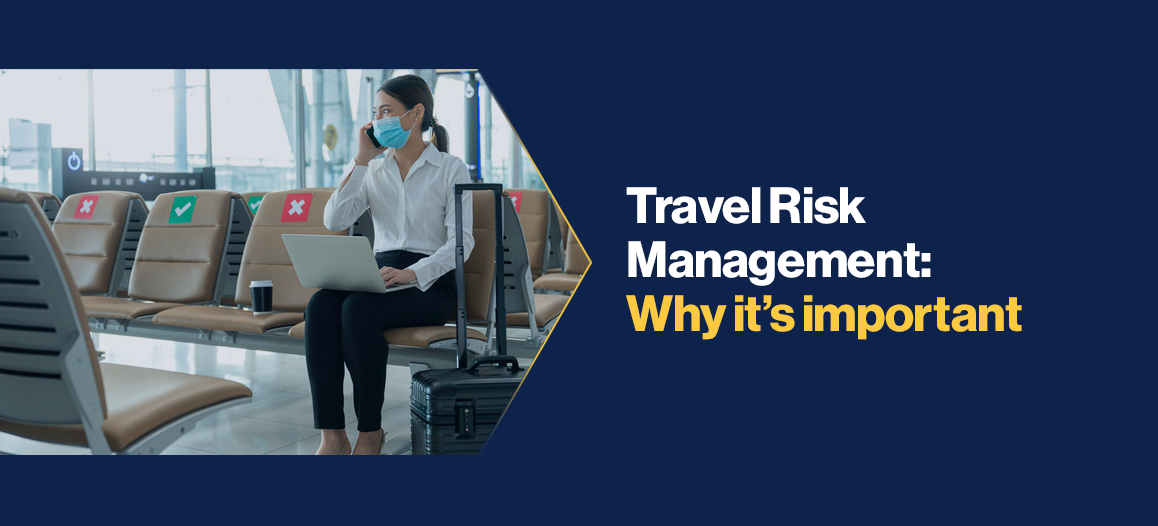
The pandemic has emphasized the importance of health within organizations - especially in those where business involves travel and human contacts.
The International Standard Organization (ISO) is still working on “ISO 31030 – Risk Travel Management – Guidance for Organization” that is scheduled to be released by the end of 2021. The contingent scenario requires a structured approach to travelling and the future standard is intended to assist those managing and participating in business travel.
We must consider that Travel Risk Management is part of travel-related activities of an organization, which also includes stakeholder management. Organizations need to meet their “Duty of Care” responsibilities, comply with any relevant legal and ethical obligations related to travel (across multiple jurisdictions) and have a plan in place to care for their staff.
It is important to show employees that they are supported by their company when travelling on its behalf. Travelers, whether international or national, can be faced with unfamiliar situations and environments that have different risk profiles.. Risks such as road accidents, disease outbreaks, epidemics, natural disasters, as well as conflict, crime (including cyber and information ones), terrorism, political and socially instability and unrest, can threaten the safety, security, and health (both physical and mental health) of travelers and also affect the outcome of their business trip.
Managing travel risks in a country where an organization has no local base, requires more comprehensive controls compared to those locations where mitigations have already been established and risk profiles are well known. Nowadays, a timeliness and accuracy of intelligence, analysis and advice, including travel warnings, has increased in importance and is going to highly influence travel decisions in the future.
Due to the contingent pandemic situation, Travel Risk Management requires organizations to anticipate and assess the potential impact of events, develop mitigations and communicate anticipated risk exposures to their employees. Thus, advising and providing travelling employees with adequate medical, emergency response guidance, security, and information security precautions, has become essential.
Organizations - of any size and industry sector - need to demonstrate that travel decisions are based on the organization’s capacity to treat risk using internal resources or with external assistance. Consequently, Travel Risk Management is set to become strategic and fundamental - both in terms of business continuity and organizational resilience - since it demonstrates an organization’s compliance to Duty of Care.
Travel Risk Assessment
A Travel Risk Assessment is fundamental to comply with obligations of Duty of care . The scope of the Travel Risk Assessment is to identify any threats an employee could face during a trip. Considering the fact that travel risks are constantly evolving and, consequently, the assessment must consider all aspects, i.e., from the loss of a flight to a global pandemic.
Thanks to a Travel Risk Assessment, organizations will be able to set ad hoc policies and procedures to reduce the travel risk wherever possible. In addition, a well-executed and communicated Travel Risk Assessment reassures the employees who are travelling and contribute to safeguard their safety by knowing what to do in case of critical situations, be aware of the potential threats and implement ad hoc policies to mitigate them.
Employee route tracking
Technology has been a powerful lever for change in the business travel industry, providing route tracking programs: location tracking apps are everywhere around us, and besides sharing location with friends and family, some of them are designed to allow employers to monitor their workforce's travel journeys remotely and be able to locate them in case of danger/emergency.
Employee training
After assessing all travel risks, organizations have the obligation to embed travel risk culture among its employees and train them to discern between what is and is not to be considered a risk during a business trip. Therefore, training is focused mainly on prevention and make easier to avoid a dangerous situation than to solve it. Furthermore, by training employees on how to respond and behave in awkward situations when travelling, the organization contributes to safeguard their lives.
Regulations to comply with as an employer
In this contingent scenario, international corporations employing large numbers of workers abroad must demonstrate a proper management of increased crisis and critical situations involving their employees. Therefore, it is important that organizations know:
- how to handle business travels
- how to conduct a thorough Travel Risk Assessment
- how to set a duty of care policy
otherwise, they are only putting themselves at risk.
We must take into consideration that within the context of travel, Duty of care is the legal obligation to research, plan, and implement a strategy to mitigate the risks involved with business travelling.
An organization’s Duty of care contains a statement of its commitment to care for its employees and how far that extends. By implementing a Travel Risk Management System, organizations can put into place an ad hoc strategy to uphold their “duty of care”. In other words, organizations fulfill their Duty of care through the implementation of travel risk management procedures.
The Travel Risk Assessment activity is fundamental and strategic in terms of safety at work and represents an exclusive, personal, and non-delegable obligation, for which the employer is responsible for its employees. Due to the contingent pandemic situation, organizations are urged to put into place a Travel Risk Management System to cope with the multiple threats potentially impacting travelling.
If an organization does not have a crisis unit that can be activated in the event of an emergency, then it will need to rely on specialized international service operators and travel security operation centers that can monitor, analyze and inform travelers or expatriated employees about what is happening around the world and provide them with “ ad hoc ” news and alerts to avoid any areas at risk.
Therefore, any organizations should ensure adequate monitoring of the location/country of destination in terms of:
- Political instability or unrest - this aspect can jeopardize travel or travel plans and endanger travelers since business travel to and within politically unstable areas, requires careful planning based on up-to-date advices and information by monitoring, for example, the website of the relevant governmental institutions which notify, at global level, information in terms of security, protection, and level of terrorist threat.
- Health threats and illnesses : Travelers will need to complete all the vaccination treatments necessary for the country before traveling.
- Availability of healthcare: organizations should make sure their travelers know where they can get medical care in case of need.
- Food and water safety : travelers should always remember that some parts of the world may not have the same hygiene standards of their home Country; therefore, the risk of intestinal disorders should be reduced by eating safe food and avoiding street food and opting for bottled water instead of tap water.
- Know the security measures of the accommodation you are in, i.e., if the reception is open 24 hours a day, examine the surrounding area using, for example, Google Street View, etc.
- Do not book a room on the ground floor: these rooms are more susceptible to burglaries.
- Put the " do not disturb " sign on the door when you are not in the room.
- Know the emergency exit plan: as soon as you arrive in the room, take a few minutes to examine the map of the emergency exits and identify where they are.
- Third-party contractors - A company's service obligations also extend to third-party contractors and other individuals to whom the organization has responsibilities. Therefore, it is advisable to use only trusted third parties by selecting them from an approved and accredited list and carrying out the necessary intelligence investigations especially when operating abroad.
- Female employee safety - Women traveling for work are more likely to face risks than their male colleagues. According to a 2018 report published by the Global Business Travel Association (GBTA) and AIG insurance company , namely 83% of women had safety issues during business trips. Despite this, only 18% of travel policies specifically target women's safety. Therefore, organizations, in order to adequately meet their Duty of Care requirements , should ensure their female employees receive ad hoc training to address the risks they may encounter during their business trips.
Post lockdown business travel
Some lessons learned from the pandemic could be valuable and used to set travel risk management policies and procedures for the near future when the measures to contain the pandemic slowdown. Hereafter some tips to be considered:
- Be prepared for travel requirements and restrictions related to the business travel destination by monitoring institutional governmental websites providing updates of restrictions that may vary from one city to another within the same Country.
- Plan business travel by geographic region, aligning business plans with the reopening of the Country or cities of destination.
- Check whether the automated travel approval systems (where implemented) are sufficiently agile and flexible to expedite, for instance, pre-approvals without any additional bureaucracy.
- Review health and safety policies and procedures with reference to airlines, hotels, and land transport, ensuring that suppliers have clear safety and hygiene practices in place and in possession of related certifications issued by accredited health safety organizations.
- Improve employee’s trust and manage cybersecurity issues by ensuring context-specific, flexible, dynamic, and adaptable travel options within your organization's policy.
- Reassess travel expectations, such as essential travel vs. non-essential ones or the number of employees allowed to travel at any time.
- Up-date traveler’s data and improve data communication methods by considering that the "new normal" - in terms of business travel - will imply more complex issues to deal with, i.e., changing entry/visa requirements. Therefore, it will be strategic and fundamental for companies to be able to communicate required data timely.
Conclusions
Travel risks are very dynamic: they constantly change from county to country, depending on the time of year, the geo-political climate and, nowadays, the pandemic. Therefore, it is important and strategic to monitor and update Travel Risk Assessment and intercept new risks determined by the evolution of different contexts/scenarios. It urges for organizations to implement an integrated Travel Risk Management System to be able to:
- Define operational processes related to traveling.
- Carry out an in-depth risk analysis.
- Set rules and levels of security.
- Provide adequate information and training.
- Adopt specific mitigation measures.
- Guarantee operational management of stay abroad and arrange possible early return.
It will be equally strategic and fundamental to ensure ad hoc internal communication campaign in terms of "Travel Safety & Security " to adequately inform and raise the level of awareness among employees and stakeholders and train them to act proactively during a crisis.
Covid-19 has exerted a profound change in behavior on corporate travel. The safety requirements of travelling employees have increased noticeably and the employer’s Duty of care is much more important than before the pandemic.
Furthermore, prior to sending back employees on travel for business, there are several factors to consider protecting them and the business. Organizations need to evaluate challenges and potential changes while employees are traveling, as well as the threats that these potential challenges and changes can impose on business and business travelers. It is crucial to have a clear plan that identifies what useful actions can be taken to protect the workforce. Therefore, in this evolving scenario, the Duty of care and the implementation of an efficient Travel Risk Management System are set to become more important and strategical than ever to guarantee the protection of travelers and expatriated employees, thus ensuring business continuity and organizational resilience.
- Physical Security, Infrastructure & Terrorism
- Regulations, standards and guidelines
About the author

Federica Livelli
Business Continuity & Risk Management Consultant
She is a Business Continuity & Risk Management consultant and Training Center Director at BeDisruptive Consultant.
She carries out activities aiming at improving awarness and development of resilience culture at various institutions and universities in Italy and abroad (POLIMI-BOCCONI University, University of Cagliari, Environmental Master University of Padua, LIUC University at Castellanza, SUPSI Lugano, University of Genoa).
Member of BCI Italy Chapter and ANRA (Italian Association of Risk Manager& Insurance Manager) board; Scientific Committee of CLUSIT (Italian Association for Cyber Security), CLUSIT HEALTH Committee, CLUSIT Artificial Intelligence Commmittee ; FERMA (Federation of European Risk Management Associations) Digital Committee.
Speaker and moderator in various national and international seminars and conferences.
Author of numerous articles ref. various online magazines and publications in Italy and abroad.
"Organizations - to survive in the increasingly complex and erratic context arising from the pandemic and characterized by geopolitical and economic crises, ongoing conflicts, cyber-attacks and supply chain disruption must treasure the lessons learned. That is, they need to invest more in resilience, at all levels and create a more flexible and secure ecosystem, able to anticipate, resist and recover from adverse and unexpected events that can compromise the organization's operations.
In fact, it is a matter of building a resilient, "antifragile" business model that presupposes the adoption of strategic disciplines such as risk management, business continuity and cyber security in an increasingly data-driven world.
The scenarios in which we find ourselves living require a sudden response and structured resilience. We can no longer wait for the unexpected, it's time to be proactive and anticipate it!"
Advertisment

Fostering resilient teams and leaders, and the organizational challenges of implementing CPS 230
- 6 Jun 2024 , 2 PM (AEST)
BCI Finland Chapter seminar
- 11 Jun 2024 , 1 PM (EET)
BCI World Hybrid 2024
- 30 - 31 Oct 2024
FEMA seeks feedback on National Resilience Guidance
- 26 April 2024
New regulation highlights danger of supply chain disruption in the UK and EU
- 01 February 2024
BCI White Paper Q3: How to measure BCM programme maturity
- 30 November 2023
You may also be interested in
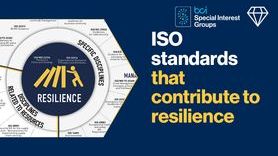
ISO standards that contribute to resilience
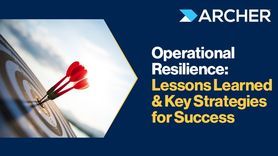
Operational Resilience: Lessons Learned & Key Strategies for Success
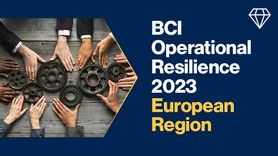
BCI Operational Resilience 2023 Regional Outlook Europe
- Research Report
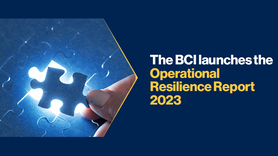
BCI Operational Resilience Report 2023
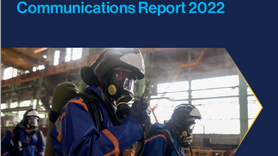
BCI Emergency and Crisis Communications Report 2022
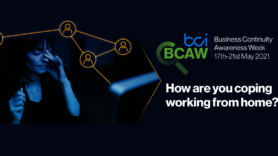
BCAW 2021 Poster - How are you coping working from home?
- Reference and Guides
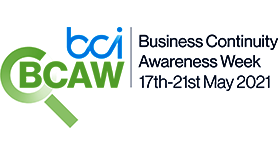
BCAW 2021 - Social Media Toolkit
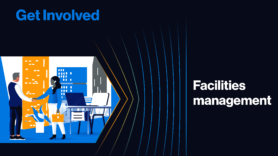
BCAW 2020 Facilities Management Poster
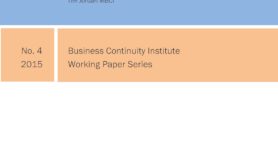
Terrorism as a lasting threat and its implications to practitioners’ view on risk
- Working Paper
Business Travel
- Home Inspiration
- Sustainable Living
- Wellbeing & Wellness
- Area Guides
- Whitepapers

A Complete Guide to Business Travel Risk Management

Business travel is an integral part of many companies’ operations nowadays, providing opportunities for networking, collaboration, and business expansion at large. However, it also comes with some risks that can impact both the safety of employees and the success of business endeavours. Implementing effective business travel risk management is crucial for duty of care ; mitigating potential threats and ensuring the well-being of your employees.
Nevertheless, before diving into risk management strategies, it’s crucial to understand the types of risks associated with business travel and measures such as claiming and filing for a business travel flight delay compensation . These can range from health and safety concerns to geopolitical issues, natural disasters, and even cyber threats. Real-life incidents highlight the unpredictable nature of travel, emphasizing the need for proactive risk management.
What is Travel Risk Management?
Travel Risk Management is a comprehensive strategy aimed at identifying, assessing, and mitigating potential risks associated with travel. It goes beyond merely reacting to crises; it involves proactive planning and execution to safeguard travellers and their interests.
When it comes to businesses it is the strategic approach that organizations employ to navigate the complexities of business-related trips while safeguarding the well-being of their personnel.
Benefits of Implementing Business Travel Risk Management
Here are four main benefits of business travel risk management:
Enhanced Employee Safety
The main advantage of implementing travel risk management is ensuring employee safety. Through pre-travel planning, employees are equipped with the necessary knowledge and resources to navigate potential risks.
This includes understanding local safety protocols, health considerations, and creating contingency plans for unforeseen circumstances.
Consequently, the implementation of a business travel risk management strategy serves as a proactive shield, reducing the likelihood of accidents, injuries, or health-related issues during business trips.
Protection of Company Assets
Beyond safeguarding individuals, a business travel risk management strategy extends its protective umbrella to protect vital company assets. This includes confidential information, technological equipment, and other resources critical to the business.
By integrating measures to secure these assets during travel, organizations will fortify themselves against potential losses, ensuring business continuity and resilience.
Legal and Regulatory Compliance
This implementation not only enhances operational safety but also ensures strict adherence to legal and regulatory requirements. In an era where compliance is paramount, organizations that prioritize risk management strategies align themselves with travel safety standards, reducing the risk of legal complications.
This compliance not only safeguards the organization but serves as a business travel checklist that reinforces commitment to ethical business practices in many forms.
Improved Employee Morale and Productivity
The implementation of these strategies goes beyond only physical safety; it nurtures a positive organizational culture. When employees perceive that their employer prioritizes their well-being, it significantly boosts morale.
This can further heighten their morale, in turn, translates into increased productivity and engagement. Employees who feel secure during their business travels are more likely to perform at their best, fostering a solitary relationship between employee well-being and organizational success.
How to Build a Business Travel Risk Management Program
1. risk assessment and planning.
Conduct a Thorough Risk Assessment : Before any business trip, it’s crucial to conduct a comprehensive risk assessment. This involves evaluating potential risks associated with the destination, considering factors such as political stability, health hazards, natural disasters, and security concerns.
Create a Detailed Travel Itinerary: Develop a detailed travel itinerary for each trip and communicate it to relevant stakeholders. Include information about accommodation, transportation, and planned activities. This ensures everyone is aware of travel plans and can respond effectively in case of an emergency.
Establish a Protocol for Monitoring and Responding: As risk factors can change, establish protocols for real-time monitoring and responses. This includes having communication channels in place for travellers to report changes in the environment and a system for implementing necessary adjustments to travel plans promptly.
2. Travel Policy Development
Developing a Clear and Comprehensive Travel Policy: Craft a travel policy that clearly addresses potential risks. This policy should cover destination selection, accommodation standards, transportation safety, and health precautions. It acts as a guiding document for employees on the corporate travel and expense policy best practices while providing a framework for safe and secure travel.
Communicate the Travel Policy: Once the travel policy is in place, it’s essential to communicate it effectively to all employees. This can be achieved through training sessions, documentation, and regular reminders. Ensure that employees are not only aware of the policy but also understand the importance of adhering to it.
3. Health and Medical Precautions
Make Pre-Travel Health Assessments Mandatory: Require pre-travel health assessments for employees. This ensures that they are fit for travel and allows for necessary precautions to be taken for individuals with specific health considerations.
Ensure Access to Medical Facilities: Identify and communicate the location of medical facilities and emergency services at the destination. This information is vital in case of any health emergencies, enabling quick access to medical assistance.
Encourage Employees to Carry a Fit First Aid Box: Encourage employees to carry necessary medications and medical documentation, especially for pre-existing conditions. This ensures that they have access to essential healthcare resources even in unfamiliar environments.
4. Security Measures
Collaborate with Reputable Travel Agencies : Prioritize collaboration with travel agencies and accommodations that have a strong focus on security. Research and select partners with a proven track record in providing safe and secure experiences for business travellers.
Provide Contact Information for Local Embassies: Equip employees with contact information for local embassies and consulates. In case of emergencies, having access to these resources can be crucial for obtaining assistance and guidance.
Utilize Technology for Real-Time Tracking: Leverage technology for real-time tracking of employees during their travels. This feature is available on the Clooper corporate account to ensure that the whereabouts of employees are known, enhancing overall safety.
5. Crisis Management and Response
Developing a Crisis Management Plan: Create a detailed crisis management plan that covers a range of scenarios, including natural disasters, political unrest, and health emergencies. This plan should outline specific actions to be taken during each type of crisis.
Clearly Define Communication Channels and Protocols : Clearly define communication channels and protocols during a crisis. Establish primary and secondary communication methods, ensuring that information is disseminated efficiently to all relevant parties.

Major Challenges in Business Travel Risk Management
1. dynamic and evolving risks.
Challenge: The landscape of risks is constantly changing due to factors such as geopolitical events, public health crises, and natural disasters.
Solution: Establish a dynamic risk assessment process that allows for real-time monitoring and adaptation of travel plans based on emerging threats. Regularly update risk profiles for destinations to ensure accuracy.
2. Employee Compliance
Challenge: Ensuring that employees adhere to travel policies and safety protocols can be challenging, especially when facing tight schedules or unfamiliar environments.
Solution: Conduct regular training sessions to reinforce the importance of compliance. Make travel policies easily accessible, and use technology to streamline reporting and communication processes, encouraging employee engagement.
3. Data Security and Privacy
Challenge: Gathering and managing sensitive information related to employee travel, health, and emergency contacts raises concerns about data security and privacy.
Solution: Implement robust cybersecurity measures to protect sensitive data. Clearly communicate the purpose and use of collected information to employees, ensuring compliance with data protection regulations.
4. Integration of Technology
Challenge: Integrating and maintaining technology solutions for real-time tracking, communication, and emergency response can be complex.
Solution: Invest in user-friendly and integrated technology platforms such as Clooper. Provide training to employees on how to use these tools effectively, and conduct regular tests to ensure the system’s reliability.
5. Budgetary Constraints
Challenge: Developing and maintaining a robust business travel risk management program requires financial resources that organizations may find challenging to allocate.
Solution: Prioritize risk management as a fundamental aspect of business operations. Allocate the budget specifically for travel risk management and regularly assess the return on investment, emphasizing the potential cost savings from avoided crises.
Is Business Travel Risk Management only relevant for international travel?
Business Travel Risk Management is essential for both domestic and international travel. Risks can arise in any location, and being prepared is crucial.
How can small businesses afford to implement travel risk management measures?
There are scalable risk management solutions that cater to businesses of all sizes. It’s about finding the right balance between cost and effective risk management.
What role do employees play in the success of travel risk management?
Employees are integral to the success of business travel risk management. Their cooperation, awareness, and compliance with the safety protocols significantly contribute to the overall effectiveness of the strategy.
How often should risk management strategies be reviewed and updated?
Regular reviews, at least annually, are recommended to ensure that BTRM strategies are aligned with the latest travel risks and technological advancements.
As we have looked through the importance, benefits, and challenges of ensuring the safety and well-being of employees during their travels, it becomes evident that a proactive and strategic approach is the cornerstone of success in business travel.
From understanding the diverse and dynamic nature of global risks to overcoming challenges such as information overload, legal compliance, and technology integration, organizations must adopt a holistic view. The landscape of business travel risk management demands constant vigilance, adaptability, and a commitment to continuous improvement.
Read more Business Travel articles
International women’s day 2024: how business travel can inspire inclusion.

First Business Travel: 8 Essential Tips for a Successful Trip

What is a Travel Management Company? TMC Explained

Renting a Car for Business Travel: Tips and Benefits

- Travel management Toggle submenu Egencia Overview Travel management solutions Amex GBT Neo1 Amex GBT Select Amex GBT Ovation Amex GBT Lawyers Travel Manage your corporate travel programme Corporate travel policy Travel risk management Travel expense management Reporting Travel management consulting Industry Solutions Transportation & Logistics
Egencia reviews

See how Egencia works

- Customer centre Toggle submenu Travellers Help centre Business traveller centre Download the app Travel arrangers Help centre Travel arranger centre Training resources Travel managers Connect community Product updates Customer training
- Watch a demo
- Request a demo
- About Egencia
Risk management: Effective risk management processes and plans
What is travel risk management and why is it important.

Travel risk management is the process of evaluating and identifying areas of risk, vulnerabilities and threats to all aspects of a business - from revenue streams to stock management and supply chain problems.
Identifying new risks is part of the on-going decision-making process within a business. It's important for a business to carry out risk assessments on a regular basis to be sure that there’s a plan of action in place in case the worst-case scenario occurs.
There are different types of risk management; from the issues a business might face on a day-to-day basis, such as cybersecurity threats and cyber-attacks, to financial trading companies who look to risk avoidance and risk management methodologies when trading in the financial markets.
Risk management is often a concern at board level, which is likely to require the various departmental stakeholders to carry out risk identification so as to ensure that their area of business minimises risk as much as possible.
In large organisations, teams might be dedicated to monitoring risks and dealing with risk mitigation, so it's common to find a risk manager working across the business providing risk management plans for the entire organisation.
Corporate risk management can cover a lot of ground and involve a wide range of management tools and contingency plans to prepare a company for the worst-case scenario. Some companies treat risk as another project management issue and will put a project manager on the case to work with stakeholders.
Risk management is all about the mitigation of adverse effects on the business. Where there's risk, there's potential for both profit and loss. Risk management will look for ways to reduce the likelihood of damage to the business.
Learn more about how Amex GBT Egencia approaches risk management.
Risk treatment methods
There are a number of different ways risk can be handled in the workplace to make sure the company’s risk is reduced and business continuity is maintained.
Risk Avoidance - It's possible to avoid risk all together in certain areas with active risk evaluation. For instance, instigating a policy of working from home is a method of risk avoidance that has been implemented over the past few years.
Risk transference - You can insure against risk. There are many insurance policies out there that can cover you against certain types of risk. This is a form of risk transference, where the risk isn't removed or actioned against, but will cover a company if the worst case happens. Simple insurance policies such as building insurance, to cover against fire and damage, for instance, is a form of risk transference.
Mitigation - A more pragmatic option is to accept elements of possible risk but mitigate it through planning and procedures. Prioritising acceptable risks and those that could be more damaging to the business, for example, is not a complete solution, but it can help prevent major issues arising.
Ignoring it - One method is to simply ignore risk and deal with any negative problems as and when they come up. Business usually involves some form of risk, and it’s possible to not concern yourself with potential issues until they occur. This isn't necessarily the best solution because it can open your business up to significant issues if things don't go to plan!
Employee risk management
Another area of a business where risk management needs to be considered is employee risk management. Sometimes this is an overlooked aspect of a business but can be very costly if problems occur. So, a proper risk analysis needs to be carried out to reduce the potential for financial risk.
Employee risk management initiatives often fall within the remit of Human Resources (HR), but other teams and individuals may be involved if there's something specific that needs to be addressed by other departmental issues and risk.
Employee risk management is often related to the potential impact and overall risk in the workplace itself. However, in the modern world, employees may travel globally on behalf of their employer, so it's common to put in place travel risk management solutions because there are a number of significant issues and risk factors relating to travelling for business.
Risk management in business travel
Issues surrounding employee health when travelling and health crisis in certain locations is nothing new. Issues such as civil unrest, travelling to dangerous locations, and even natural disasters all need to be considered when assessing risk in travel. A business has a duty of care to its employees and to reduce and manage risk as effectively as possible.
You can get insurance policies from your insurance company to cover many elements of risk, but you'll need to check carefully what is and isn't covered.
How Egencia can help with travel risk management
If you're looking to reduce your organisation's risk and want to optimise how your company implements duty of care for employees, then Egencia can help.
Traveller risk management needs to cover duty of care responsibilities across the entire travel cycle of an employee's business trip. From travelling to a location, while they're at the location, and on their return journey to the office or home. If an employee is travelling on your behalf, then their safety is your responsibility. This could even mean stopping them from travelling in the first place if it isn't safe to do so.
Understanding risk - The first step to creating an effective risk management strategy for travel is to understand what the potential risks are and to have a travel policy in place to negate these operational risks. Ultimately, you'll need to go through a process of identifying risks. The risks identified take into account all the project's risks on a large scale and enable accurate planning.
Create a risk management plan - If you don't have a risk management strategy in place, or if it's not effective, your employees may be exposed to risk, leaving your business open to potential legal action. Risk response is also essential for teams - how will departments respond, who will be responsible for the task, and how will the corporate risk register align with day-to-day operations?
A risk management programme must be dynamic and flexible, so that it can be modified when the need arises. It must also involve the employees themselves, who often have an idea of the risks faced. Everyone's understanding of risk is different. The company must therefore understand where the boundaries lie for the employee, comply with statutory regulations and develop a travel policy that suits all parties concerned.
Create effective risk management policies - With Egencia, you can block travellers from booking certain locations, and even limit the number of employees that travel together. For instance, you can set a limit to the number of employees that can book the same flight at any given time.
The process begins as soon as a traveller tries to book travel or accommodation in a location that has an active alert. The Egencia Travel Advisor can inform travellers about any health warnings or updated entry documentation required to guide and educate an employee on the potential risks involved.
Educate employees about risk - There isn't much point in comprehensive risk management practices if your employees aren't aware of them and don’t know what to do if a situation arises. Employee training must be at the forefront of any risk management plan. Risk is a conversation that employees need to have. They need to understand what constitutes a risk and how to deal with a crisis if it occurs.
Locate and contact employees to mitigate risk - The next step is to understand where your employees are when they're travelling and what risks and issues might be encountered in their location. Being able to contact employees in real time is a key advantage of Egencia's Travel Tracker tool . If a natural disaster occurs, or there's a chance of an unexpected problem such as civil unrest, you'll be able to contact your employees quickly, advise them to leave the area and help them to plan alternative means of travel, swiftly and easily.
Traveller communication and travel support - Perhaps, you're not even aware of a potential risk developing. Things can move quickly, and often the traveller themselves identifies a potential risk. With Egencia, travellers in North America can use the AssistMe tool in their app to request a callback from a travel consultant.
Benefits of a risk management plan
Saves the company money - Risk can be an extremely costly issue and, in some cases, might cause problems so severe it could even impact whether a company can trade or not. Employing risk management strategies can avoid these potential eventualities.
Avoids regulatory issues - No company wants to break the rules when conducting business, but many companies have ended up on the wrong side of the law - either through their day-to-day trading, or due to other areas such as employee law. Understanding the risks can mean avoiding fines and penalties.
Reduces litigation and liability issues - One risk a company may face revolves around litigation, liability, and other legal issues. You can protect yourself against these risks by understanding them, planning ahead, and even taking out insurance.
Improves employee relations - Employee retention, improved motivation and higher morale are all benefits a company can enjoy if it has a comprehensive employee risk management plan in place. If an employee is unhappy due to working conditions, and this unhappiness stems from issues of safety, having an effective risk management policy can help alleviate many of these concerns.
It’s better to tackle the issues than ignore them. While many issues relating to risk can be dealt with internally, it's also useful to look to third-party providers for support. It's important to select the right partners who can help your company avoid risk.
When it comes to risk management and duty of care in the corporate travel industry, Egencia is here to help.
Contact Egencia today to learn more and request a demo.
Looking for better business travel solutions? Get in touch with us.
Recommended for you.

Your client portal login provides access to your organization’s preferred pricing and customized features
- About Us CIBTvisas Global Offices Immigration Services CIBTvisas Global Leadership CIBTvisas Careers Contact CIBTvisas In The News
- Travel Visas Do I Need a Visa? Expedited Visa Solutions ETA Travel Visa FAQs Corporate Travel Solutions
- Passports Same Day Passport Passport Renewal First-Time Passport Lost or Stolen Passport Child Passport Name Change Second Passport Passport FAQs
- Document Services
- Resources CIBTvisas Travel Blog Destination Entry Requirements Podcast ETIAS White Papers Research
- Services A1 Compliance Global Immigration Services US Immigration CIBTvisas Service Directory Learn More About Our Services Corporations Cruise Lines Tour Operators Onsite Services All Partner Solutions Learn More About Our Client Solutions
- Your Order Check Order Status View Invoice Upload Documents
What is Travel Risk Management, and Why is it Important?
By: Ray Rackham
February 15, 2024
This article is part of a series of resources focusing on Travel Risk Management, including blogposts, e-books, webinars, and podcasts. These resources have been created by CIBT in association with GBTA, following the publication of a December 2023 study entitled Travel Risk Management (TRM) in a Post-COVID World . Download the full report here .
In the fast-paced world of business, where global connectivity is the norm, organizations frequently find themselves navigating the complexities of international travel. In this context, Travel Risk Management (TRM) emerges as a crucial component to ensure the safety and well-being of employees on the move.
No event in recent history has reinforced the critical importance of TRM more than the COVID-19 pandemic . When the world abruptly implemented travel restrictions, travel managers scrambled to locate and assist employees who were on the road. As business travel slowly resumed, these same travel managers established protocols to balance employee health with critical business needs. Even as COVID-era risk protocols have largely disappeared, TRM remains a priority in the business travel industry. Companies continue to incorporate lessons learned from the pandemic. However, they are not relying exclusively on their own experience for guidance.
CIBT recently partnered with the Global Business Travel Association (GBTA) to undertake a comprehensive study of travel managers worldwide. Several key insights were uncovered from the study, the results of which can be found here . This article is the first in a series of articles for the CIBTvisas blog focussing on TRM. It provides the basis for a shared understanding of what TRM is all about, and why it has come to be of such importance in organizations.
What is Travel Risk Management?
Travel Risk Management can be defined as a comprehensive approach aimed at identifying, assessing, and mitigating potential risks associated with business travel, whether domestic or international. This proactive approach to TRM encompasses various elements such as health and safety, security, legal considerations, and cultural awareness. The goal is to minimize the impact of unforeseen events, ensuring a smooth and secure travel experience for employees.
Health and safety
In terms of health and safety, TRM involves meticulous planning to address medical emergencies that may arise during travel. This includes understanding the healthcare infrastructure at the destination, providing employees with necessary vaccinations, and having access to medical support services. By prioritizing health considerations, organizations not only protect their workforce but also avoid potential legal and operational ramifications.
Security
Security is another critical aspect of TRM, with travel and mobility managers actively monitoring geopolitical situations, local crime rates, and other security threats. By staying informed and implementing robust security measures, organizations can mitigate risks associated with terrorism, civil unrest, or other adverse events, ensuring the safety of their employees in unfamiliar environments.
Legal considerations
Legal considerations play a pivotal role in TRM, especially when it comes to visa and immigration compliance. Navigating the complex web of international regulations requires expertise and diligence to avoid potential legal complications. This aspect of TRM ensures that employees have the necessary documentation to travel and work seamlessly across borders, avoiding disruptions and potential legal consequences.
Cultural awareness
Cultural awareness is a fundamental aspect of TRM, promoting sensitivity to the customs and traditions of different regions. By educating employees about local norms and practices, organizations enhance the travel experience, mitigate cultural misunderstandings, and contribute to positive interactions with clients, partners, and the local community.
For travel and mobility managers working on behalf of organizations with a global footprint, TRM is not merely a checkbox on a compliance list—it is a strategic imperative. The dynamic nature of international travel introduces a myriad of risks, ranging from health emergencies and natural disasters to political instability and security threats. By integrating TRM into their operational framework, organizations can systematically address these challenges, thereby safeguarding their most valuable asset—their people.
What are the essential elements of a good TRM strategy?
The GBTA/CIBT study identifies five overarching functions that, when considered together, make up a comprehensive TRM strategy.
Policy and strategy
At the core of TRM lies the establishment of robust policies and strategies. This involves creating a framework that outlines the organization's approach to risk mitigation, duty of care, and compliance. By aligning TRM with broader business strategies, organizations can proactively address potential risks and set the stage for comprehensive employee safety during travel.
Pre-trip processes
TRM's efficacy begins before employees embark on their journeys. Pre-trip processes involve risk assessments, health checks, and ensuring compliance with legal requirements. Travel and mobility managers must meticulously plan for potential hazards, including health emergencies, security threats, and cultural nuances. Implementing pre-trip processes ensures that employees are well-prepared for their travels, reducing the likelihood of disruptions.
Communication
Effective communication is a linchpin in TRM . Timely and clear communication channels are essential for disseminating information about potential risks, emergency procedures, and destination-specific guidelines. Regular updates and briefings contribute to heightened situational awareness, empowering employees to make informed decisions during their travels. Transparent communication builds trust and enhances the organization's overall risk management strategy.
Passports/Visas
The intricacies of international travel often revolve around passports and visas . TRM involves meticulous management of these documents to ensure compliance with immigration regulations. Travel and mobility managers must stay abreast of visa requirements, processing times, and potential changes in immigration policies. This proactive approach minimizes the risk of travel disruptions due to documentation issues.
Vendor management
Collaborating with vendors is integral to modern business travel, and effective Vendor Management is a key aspect of TRM. From transportation and accommodation to visa and immigration services, organizations must vet and manage vendors diligently. Establishing partnerships with reputable service providers enhances the overall safety and security of employees during their journeys. Regular assessments and reviews contribute to a robust TRM strategy by ensuring that vendors align with the organization's risk management standards.
Individual and organizational safety
TRM empowers travel and mobility managers to make informed decisions based on real-time data and risk assessments. This enables them to pre-emptively respond to potential issues, ranging from visa complications to geopolitical tensions, ensuring that employees are well-prepared and supported throughout their journeys. In turn, this not only enhances the overall safety of employees but also contributes to the resilience and reputation of the organization.
In conclusion, Travel Risk Management is not a luxury but a necessity in today's globalized business landscape. Organizations that prioritize TRM are better positioned to protect their employees, mitigate operational disruptions, and uphold their duty of care. As a trusted partner in the realm of business travel, CIBT recognizes the pivotal role of Travel Risk Management in fostering secure and efficient mobility solutions for organizations worldwide.
Travel well-informed with CIBTvisas
An experienced visa specialist can help you navigate the complexities of border crossing requirements. Contact CIBTvisas for a quote today.
CIBTvisas Monthly Update
Get the CIBTvisas Monthly Update for the most recent information on travel requirements and consular closings.
Sign Up Now
What is Travel Risk Management? | CIBTvisas
About CIBTvisas
- Travel Visas
CIBT Around the World
- netherlands
- switzerland
- United Kingdom
- United States
Top Destinations
- Vietnam Visa
- Brazil Visa
- Australia Visa
- Indonesia Visa
- Saudi Arabia Visa
- 800-929-2428
- Learn More About Our Client Solutions
- Privacy Policy
- Terms & Conditions
- Copyright 2024
- Privacy Shield Compliant
- TRAC Certified
- As Seen in The New York Times
Understanding Travel Risk Management (TRM)
Defining travel risk management (trm), where responsibility for risk is less clear, business drivers.
- TRM solutions and comprehensive programs
- TRM program roles, tasks and processes
- Common mistakes and problems
- TRM tools and solutions
- The future of TRM
About Safeture The Safeture platform is a complete and cloud-based service managing risk, safety and crisis processes involving employees. The solution takes care of all risk and crisis management needs, finding new ways to safeguard employees wherever they are and secure your company. More information on Safeture and the BCD marketplace Travel Risk Management .
ISO standard 31030 defines travel risk management as “ the effects of uncertainty on objectives due to travel .”
Quite simply, what this really adds up to is making work-related travel safe(r) for employees and other people traveling on a company’s behalf. The standard further describes TRM as “coordinated activities to direct and control an organization with regard to travel risk.”*
So, TRM is not just the “why,” it’s also the “how.” You can find out more about ISO 31030 in this short video from BCD Travel’s Global Crisis Management team .
* ISO 31030:2021 Travel risk management – Guidance for organizations
Getting started
For travel managers new to TRM, using an external TRM supplier may be a good starting point. TRM programs can range from simple to highly complex, and ISO 31030 may be an unsuitable guide for those completely new to TRM.
Even before bringing in a third-party, seeking advice from a travel management company (TMC) can also be a useful starting point. Available through Advito, BCD Travel’s Traveler Security Program Assessment (TSPA) can help ensure TRM alignment to ISO 31030
Why travel risk management?
There are three main factors necessitating a TRM program:
- Duty of care – in most countries, employers have a legal responsibility to care for staff when working, and this includes work-related travel. The responsibility is less clear for non-employees traveling on the company’s behalf, but it seems sensible to include them within the wider scope of duty of care. As this is a legal responsibility, employers may be liable for damages (and in some jurisdictions, senior executives may be liable to criminal charges) if an employee is injured or killed on a trip. A properly delivered TRM program may provide some legal defense. And it’s worth remembering that workplace laws apply wherever an employee is active on behalf of an employer, and that includes when traveling for business.
- Moral and ethical duty – employers have a duty to keep employees safe whentraveling on business and support them should something happen on a trip.
- Reputation – being seen as a caring employer will help companies retain staff and attract new employees
Why BCD should be a vital part of your travel risk management strategy
Around the clock monitoring.
Our Global Crisis Management team monitors events 24/7/365 to identify incidents that may impact business travelers.
Once identified, our team conducts an assessment and action plan for each incident.

Prepare and prevent
Our proprietary and interactive security map allows you to visualize a traveler’s current and upcoming locations against known risk events.
The in-depth destination reports and automated risk alerts will keep travel managers and their travelers informed before they ever step on a plane.
Communicate and act
When an incident occurs, we provide multiple ways to communicate with travelers.
Real-time mobile alerts to both travelers and travel managers to keep them informed and aligned. Automated “I’m Safe” check-in functionality for highrisk incidents. Responses sync back to interactive security maps in DecisionSource. Reach out directly to travelers via email or SMS with contact data pulled straight from their itineraries.
There are some aspects of travel where an employer’s responsibility towards employee risk is less clear.
Bleisure travel
Whilst on a business trip, an employer’s responsibility for employee safety and welfare begins the second they leave home (for the airport) until they are back home. Engaging in leisure activities during a trip adds complexity, particularly when leisure and business travel are blended together in a bleisure trip. Clear policies should define the boundaries between work and leisure, while the validity of the company’s travel insurance during leisure time should also be ascertained.
Bleisure travel as an employee benefit
Post-pandemic, blended travel has become more popular than ever and has supported the growth of the “digital nomad.” Many business travel insurance policies will cover employees when they extend their trip to include some leisure time. Companies can promote this as an employee benefit, helping with talent acquisition and staff retention
Managing the entire risk
It’s a mistake simply to ensure a TRM program covers only the most common travel risks, as it leaves companies exposed to the legal consequences of unmanaged risks.
Remote workers
The boundaries between work-related travel and remote working are becoming increasingly blurred. When a natural disaster occurs, should a company look after both business travelers and remote workers in the area? An employer’s legal responsibility for out-of-office work has become less clear. Ideally, TRM should extend to all impacted employees, and not just to those traveling for business. Travel risk management is becoming people risk management.
Don’t just focus on high-profile risks
When it comes to travel, it’s easy to focus on the high-profile risks, such as terrorist attacks or large-scale natural disasters. While it’s important to prepare for such events, particularly since their travel impact could be significant, in reality, they occur only rarely. It’s just as important to prepare for smaller impact risks, which are easily overlooked, but which occur much more frequently. These can be more isolated incidents, impacting a smaller number of or even single travelers. They can include medical emergencies or car accidents – the number one cause of non-natural business traveler deaths*.
* Centers for Disease Control and Prevention, Traffic and Road Safety
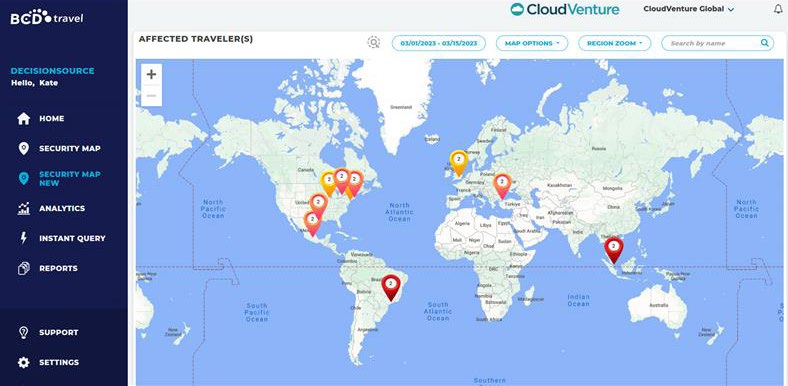
Find out how BCD has supported companies with their travel risk managements needs
Safran’s security team, discount retailer.
- Duty of care
Complying with duty of are is the main driver for establishing a TRM program, as it will help mitigate the risk of lawsuits and other damages.
Past incidents
A post-incident review is often the catalyst for implementing or improving TRM at a company. Where a program is already in place, a review can help identify what’s working and what isn’t and herald the necessary adjustments. Companies experiencing frequent incidents – by the very nature of their travel patterns – can have some of the most developed TRM solutions.
Employer ethics
Organizational culture and ethics can sometimes override compliance as the main motivator for TRM. Protecting staff may be a core value which drives companies to invest the necessary resources. As this may require the TRM program to be aligned with multiple organizational policies, sufficient resourcing will help ensure this implemented effectively.
Travel risk management solutions and comprehensive TRM programs
It’s possible to classify common TRM solutions into two groups: inadequate and adequate.
Duty of care is not a transferrable responsibility
While insurance companies and third-party assistance providers can be critical in providing duty of care solutions, an organization’s duty of care is not a transferrable responsibility.
Employers should always maintain an active role in overseeing supplier relationships and service fulfillment to ensure their employees’ health, safety and security needs are being met.

Inadequate solutions
These provide some level of travel risk management but are unlikely to be sufficient for full duty of care, thereby exposing companies legal and financial penalties. The most common approach is to have insurance only, but it’s not enough on its own. Travel insurance is often insufficient for non-medical incidents, such as natural disasters, kidnapping and civil unrest. And some medical incidents may also be excluded. Relying on travel insurance alone, organizations increase the risk of reputational and financial damage, as many frequentlyoccurring types of incident will not be covered.
As a first step, it would be an improvement to implement a basic managed solution, which does not include assistance. In this instance, companies would appoint a travel manager(s) to look after travel tracking and travel insurance. The manager could also arrange all travel or assign a dedicated travel management company (TMC).
While the travel manager becomes the contact point in event of an incident, they won’t be available 24/7. And they lack the resources to support employees on the ground. Incident responses tend to be poor and slow and may full short of a company’s duty of care requirements.
Adequate solutions
These offer good protection for traveling employees, aligning well with a company’s brand and values. While large organizations have the resources to build their own TRM solution, many companies choose to simply buy a complete one from an external assistance provider. And even those companies creating their own solutions, may decide to outsource certain components.
When selecting an external provider, it’s important for them to be able to offer 24/7 medical and security emergency assistance and be able to cover all costs, following up with insurance claims at a later date.
Such a solution that reacts with assistance is considered to be adequate from a duty of care perspective. But more comprehensive solutions with prevent or reduce employee exposure to risks and act proactively when risks change.
Comprehensive travel risk management programs
Comprehensive managed solutions consider all risks and create risk mitigations for all stages in a business trip, from planning to a traveler’s return home.
Pre-trip processes
The best solution is to not expose travelers to risk in the first place and prevent incidents happening through good planning and preparation. The following methods can be effective:
- Automated integration of travel bookings with country risk levels to trigger the need for travel approval.
- Pre-trip approval to ensure travel plans adhere to TRM policy. For certain high-risk destinations, travel could be blocked with authorization.
- As a policy requirement for work travel, employees must register with the TRM program before departure.
- Pre-trip medical approval to ensure a traveler is fit to travel, thereby reducing the risks of health-related incidents.
- Safety and security training.
- Alerts both pre- and on-trip.
- Prebooked travel services to reduce the risk of incidents. Booking secure ground transportation from known safe suppliers is one of the most commonly used services.
Proactive assistance
Comprehensive solutions may often include a proactive process in responding to an incident. This would include reaching out to all employees in the vicinity of a major incident, to confirm they’re ok or need assistance.
Location information can help identify which employees to contact. Communication should extend to employees planning travel to the affected area too. Travel booking data will be a useful source of whom to contact.

Pre-trip processes should cover all employees
Ensure that pre-trip preparations are inclusive of the needs of all travelers in your workforce.
Companies must look after the safety and well-being of all travelers, but certain diversity dimensions such as travelers’ race and ethnicity, gender, gender identity and expression, age, sexual orientation, neurodiversity and accessibility for travelers with disabilities, to highlight some, may require additional focus to ensure inclusive travel experiences.
Travel risk management program roles
Multiple stakeholders need to be involved in implementing travel risk management programs. Once these are in place, annual table-top exercises should be held to fully test incident management processes from end to end. Such exercises should also include insurance companies and any third party assistance providers to simulate emergency processes and responses as realistically as possible.
In companies where such a role exists, the travel manager should be involved in the TRM program, as it forms a critical part of managing employee trips.
A company’s security manager may often be assigned responsibility for its TRM program.
But travel risk can often be a small part of the role. And security’s status as a cost rather than a source of revenue may make it difficult to secure investment.
Companies need to see TRM as securing revenue and profit and not merely as a cost.
- Human Resources
As TRM programs support a company’s duty of care, it’s crucial to involve HR in their creation and when a major incident occurs.
Travel Management
By mandating their use in the travel policy, a travel management company (TMC) or corporate travel department (CTD) can assist with pre-trip authorization and tracking of travelers via bookings data.
And by requiring employees to book through the TMC or CTD, companies are reducing the risks associated with unmanaged bookings.
Medical Assistance Provider
As health-related issues are the second most common faced by business travelers, including a medical assistance provider in a TRM program is crucial. Medical insurance coverage for traveling employees will most likely include a company to contact for medical assistance. But this may restrict assistance only to those incidents specifically covered by the policy.
Working independently with the medical assistance provider can ensure the TRM Program supports both medical and non-medical incidents. One number (only) to get assistance in an emergency will reduce traveler stress in the event of an incident. And if other specialist providers are required, then the medial assistance provider can get them involved, as and when necessary.
Security Assistance Provider
Some incidents will be specifically security-related, so including a security assistance provider in the TRM program is another necessity. Such providers can book secure ground transportation to reduce risk when travelling between the airport and hotel, for example. And in the event of an incident, they can provide security personnel or assist in evacuations.

Insurance companies
Knowing that an insurance company is on hand to handle claims and cover costs provides extra reassurance when delivering support to traveling employees. Action should not be delayed by concerns about payment. To get the right insurance, it’s important to describe the level of protection required, the number of employees requiring coverage, and what their travel and work patterns are. The insurance company will also need to know how it’s expected to work with the travel risk management program.
For companies with travel to countries with a high risk of kidnapping, it’s important to remember that this requires a special type of insurance, which might not be included in a standard travel insurance package. Separate kidnap and ransom insurance should be investigated.
Threat Intelligence Provider
Threat intelligence is a crucial part of the risk assessment, which can determine to which countries employees may travel and what security preparations they should make. Real-time 24/7 alert services can enable assistance to be provided proactively if a threat develops.
Internal Management
The most important role in a TRM Program is ultimately held by a company’s own management. ISO 31030 has leadership and commitment at its core, connected to all other parts of the TRM framework. Commitment needs to be secured and this can be done simply by pointing out the financial, reputational and possibly criminal damages that might arise if management fails in its duty of care towards employees.
Travel risk management tasks and processes
Leadership commitment and communication.
Senior management support is crucial, more so if they mandate the use of the TRM program by all travelers. Failure to participate should result in denial of travel. But the TRM program needs to be effective, and this requires senior management support in the shape of sufficient resourcing. Absent this, and the program risks functioning poorly and failing to fulfil the company’s duty of care.
Rollout process
Getting the rollout right is key to traveler adoption of a TRM program. Employees need to know the program has been introduced, what it means for them and how they can use it. What number to use in an emergency? How to use the insurance policy? The TMC through which bookings should be made? Any mobile apps that need to be used? These are some of the questions travelers will need answers to.

In a comprehensive TRM solution, pre-trip processes are the best way to ensure a high-quality program. Getting it right on pre-trip authorization, mandating booking through designated TMCs, education and high-risk booking processes is the place to start.
Where an external emergency assistance provider is used, it’s important to establish efficient interaction with their systems, and with those of any subcontractors that might be used.

Common mistakes
Does your company have specialized insurance coverage.
Additional policies may be required for kidnap and ransom and the risks to the company, should the safety of key personnel be compromised.
Travel insurance is enough
By relying solely on travel insurance that includes work-related travel, a company will fail in its duty of care to employees, exposing it to legal and financial risks. This is because insurances normally include restrictions, and that means employees will not be covered in certain circumstances. Pre-existing medical conditions, evacuations due to security and health threats, cyber security attacks, natural disasters may often be excluded from travel insurance, but they’re the sort of risks that many business travelers face.
Should an event or situation be excluded from the policy, the employee may not be assisted or could face paying for assistance themselves.

Misunderstanding mobile phone tracking
It’s a common misunderstanding that mobile phone location tracking conflicts with an individual’s privacy. When used for TRM purposes, it’s possible to limit an employer’s access to location data to prevent its misuse.
To allay fears about real-time tracking by employers, availability of mobile location data could be restricted to a third party emergency assistance provider. And if this isn’t the case, employees could turn off tracking for a specific location or restrict its use to certain areas.
Common problems
Traveler resistance.
Company culture and individual behaviors and preferences are the most common obstacles to a TRM program. Experienced travelers who may in the past have faced high-risk situations without the support of TRM may doubt its value and may be reluctant to comply with any policy requirements.
Even when TRM is mandated in travel programs, they won’t cover bookings made outside of travel policy. Some travelers may simply be unaware of the mandate. Others might believe they can find better deals or may be dissatisfied with the service they’re receiving from their travel manager or TMC. Perhaps the policy prevents them using their preferred airline or hotel chain? Whatever the reason, such bookings could be supported by the TRM program, if employees share a copy of the booking confirmation email with the TRM system.
Technical issues
Even with all employees onboard, technical problems can derail TRM:
- Bad travel booking data – use of free text fields means it’s easy to enter incorrect traveler details
- Location tracking not working – as such systems often operate in the background, they can sometimes be disabled by operating systems looking to preserve mobile phone battery life
- Incorrect employee data
Legal issues
While data protection and privacy laws shouldn’t preventthe operation of successful TRM programs, they still need to be legally compliant. There are often restrictions over the cross-border transfer of personal data. Ownership and control of personal data must also be established, to ensure legal compliance and legal responsibility in the event of a data breach. And there need to be the proper protections in place to secure against cyberattacks and threats.
Employee engagement can reduce traveler resistance
Actively engage with employees to emphasize the importance of the TRM program.
Craft any messaging to highlight how allowing access to location data, personal mobile phone numbers and emergency contacts can help companies protect their employees in the event of an incident.
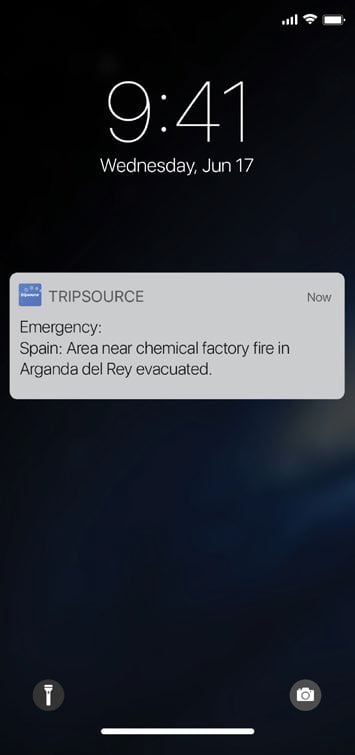
How BCD Travel can help you
Travel risk management tools and solutions.
Communication is key to successful TRM.Communication needs to be enabled both to and from the traveler and there are a number of solutions worth considering.
Destination intelligence
As part of the pre-trip authorization process, companies can provide destination intelligence to employees. This can help them make informed decisions before a trip and can help identify and mitigate risks.
Travel tracker
A system integrated with the travel management company (TMC) automatically receives copies of all flight, hotel, rail and ground transportation bookings. In the event of an incident, travel managers can more easily search active and future bookings within specific geographic areas. Travel trackers can also be used to manage risk for future trips as the situation evolves. But travel trackers can only show the booked and not actual location of traveling employees. For this reason, they should be augmented with other solutions, such as mobile phone locators.
Mobile phone locator
Such devices provide a real-time location of an individual mobile phone, meaning travelers can be located, even if they deviate from their original itinerary. To protect their privacy, location tracking could be restricted to predetermined geographic areas or provide less exact locations. And possibly misuse by an employer could be avoided by only allowing dedicated assistance providers to access location data.
Mass communication
Many travelers could be impacted by the same incident. Mass communication offers an effective way to inform all employees in an affected area, and not just travelers. Such tools are already used for business continuity and crisis management purposes, but they should be enhanced with TRM functionality.
Integrated TRM platforms
The solutions detailed so far may be used in isolation, but they are increasingly being integrated within the same TRM platform. Some include APIs (application program interfaces) to allow them to link with other systems, including HR platforms containing employee personal data.
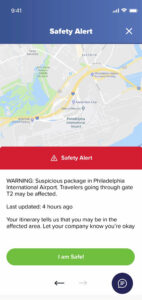
The future of travel risk management
The post-pandemic acceleration in the shift towards an increasingly mobile workforce has blurred the definition between work-related travel and remote working. When it comes to the duty of care towards employees, TRM must apply beyond those traveling purely in the traditional sense. Travel risk management will need to transition into people risk management, addressing the risks faced by employees wherever they are.
As it broadens its focus to people across companies, TRM must also leverage technology to automate and integrate better with other company systems and processes.
In whatever shape or form it takes, one thing is clear: TRM will need to grow to satisfy the needs to travelers in an increasingly global, but far from safe world.
Fulfilling the duty of care
While the ISO 30130 standard can provide a comprehensive take on what travel managers should do to ensure duty of care compliance, it may be hard to decide what actions to prioritize. Safeture has created its own simple checklist as a useful starting point:
- Create a travel policy
- Mandate a travel management company for all employee travel
- Secure management commitment, budget and resources to implement a TRM program
- Ensure comprehensive travel insurance is in place
- Contract with an emergency assistance supplier able to manage both medical and security incidents
- Implement a system for locating travelers
TRM’s expanding scope
Travel risk management is evolving. Agile organizations, which want to attract and keep the best employee talent, are expanding TRM’s scope beyond travel to include employees working from home, hybrid workers and even digital nomads.
In the end, it’s not just about duty of care for travelers, but duty of care for all employees. And this is why travel risk management is evolving into people risk management.
Solutions for every business travel program
Solutions by topic.
- Travel services
- Connect by BCD Travel
- BCD Invite – Guest Traveler Services
- Cost savings
- Hotel savings
- Meetings and event management
- Travel consulting services (Advito)
- Data and intelligence
- DecisionSource
- Travel Risk Management (TRM)
- New Distribution Capability (NDC)
- Payment solutions
- Shopping and booking
- Travel policy compliance
- Travel experience
- Trip authorization
- T&E Spend Management
Solutions by function
- Procurement
- Senior Management
- Travel Arrangers
- Travel Managers
Solutions by industry
- Aerospace & Defense
- Energy, Resources, and Marine
- Life Sciences
- Media & Entertainment
Specific solutions by company size
- GetGoing ↗
- BCD Travel Direct (Europe) ↗
- Small and mid-sized companies (US) ↗
Travel smart. Achieve more.
Get solutions for business travel that help you save time, money and stress.
Why Is Travel Risk Management Solutions Needed By An Organization
Home » B2B » Why Is Travel Risk Management Solutions Needed By An Organization
Corporate organizations are constantly under pressure, especially after COVID-19, to fulfill their duty of care obligations during corporate travel trips. They are taking all measures to ensure the safety and well-being of their employees throughout the journey. The global political situation is quite tense, hence a comprehensive travel risk management policy is much needed. It helps an organization adapt to the regularly changing conditions and ensures employee safety with relevant travel risk management (TRM) solutions.
TRM involves the assessment of the probable impact of unexpected events while seamlessly communicating with traveling employees about emerging situations and existing risks. Additionally, there is a growing need to educate employees about security precautions and emergency response protocols. Hence, travel risk management becomes an indispensable part of the corporate travel management.
Travel risk meaning
In general, travel is prone to unforeseen situations. These situations can result in conditions that may hamper the trip which is known as travel risks. Some of the most common travel risks include pandemic, accidents, flight cancelations and more.
What is business travel risk management?

Travel risk management is rapidly gaining significance across organizations because of the rise in terror attacks, natural calamities, and health safety risks during the pandemic. Corporate travel risk management is a multi-faceted, proactive, and persistent approach to securing the workforce from travel risks.
Strategies of corporate travel risk management during business travel cover three critical aspects:
- Prevention : Real-time travel alerts help prevent travel risks, like natural calamities.
- Monitoring : Security monitoring is necessary to assess business travel destinations for risks.
- Responding : TRM involves responding swiftly to the needs of business travelers. These may include organizing healthcare support and providing contact persons at different locations.
Travel risk management solutions enable organizations to prepare for untoward incidents and also help organizations enhance their potential to respond to an emergency. Effective TRM strategies make employees feel secure because of an employer’s support during business trips.
Why do companies need corporate travel risk management plan?
Business travel is an integral part of any organization preventing the traveling employee from the following risks:
1. Epidemics: Travelers can face several hurdles during epidemic outbreaks
2. Natural Catastrophes: Earthquakes, storms, floods, and tsunamis can impact the safety of business travelers
3. Accidents: Road accidents may cause injuries leading to hospitalization in foreign locations
4. Health Problems: Business travelers face risks of acute or chronic illnesses during business trips
5. Travel Regulatory Issues: Visa and other travel regulatory issues can cause hardships to business travelers
6. Wars: It is a severe risk to employees traveling to countries at war
7. Terrorist Activities: Terrorism is a significant threat to the safety of business travelers
8. Social Unrest: Strikes and riots can hamper the safety of business travelers
9. Political Instability: Closure of airports and airspace in response to political upheaval
A travel risk management plan helps companies protect employees from multiple travel risks. It involves proactive policies to prepare for threats that are beyond our control. It also helps companies prepare for unexpected events by establishing robust communication channels to support employees in faraway places. Companies can use TRM by rerouting or postponing travel to prevent possible risks to particular locations.
Must Read: How To Enhance Business Continuity With Travel Risk Assessment
Benefits of a robust TRM program
A robust and comprehensive travel risk management program focuses on protecting the most vital asset of any organization, the employees. Hence, here are some of the primary benefits of having a sound TRM program:
- The employees can get valuable tips and guidance before traveling to a particular destination.
- The TRM staff is well-equipped to handle unexpected events.
- Touring employees gain seamless access to real-time alerts that help in handling emergencies.
- Travel risk management providers enable business travelers to enjoy stress-free business trips.
- They offer comprehensive risk management support before and during the travel.
- Companies can make their employees feel confident that their employer is supporting and looking after their well-being, even when they are away from the office.
- A robust TRM program helps companies fulfill their duty of care obligations by ensuring the safety of their traveling employees.
Educating employees is a vital part of TRM

Communicating the vital aspects of security strategies to employees and educating them about the steps during an unforeseen event is crucial for successfully implementing travel risk management policies. They must be aware of the likely health and travel risks and trained to use different security protocols and mechanisms. This will improve their preparedness in dealing with unexpected situations while traveling to unfamiliar locations.
Pre-travel meetings are essential to explain travel and staying arrangements apart from country-specific information like government prohibitions and other cultural aspects. Companies must adopt a proactive approach by involving employees in pre-travel instructions to benefit from travel risk management.
Knowledge is vital, and training employees about risk management facilities before proceeding on a business trip is essential. There is no one-size-fits-all travel risk management solution. The involvement of employees in preparing a TRM plan is necessary for a custom risk management strategy.
How does a travel risk management company provide support?

A TRM company helps organizations adopt a comprehensive approach to the travel safety of employees. They educate employees and make them feel confident that they can mitigate and tackle travel-related risks with access to helpful safety resources. TRM company offers the following measures to counter travel risks:
1. Health protection
Creating health safety guides with valuable tips on preventing water-borne diseases or food poisoning. The guidelines may include suggestions to avoid street food and to drink only packaged water to stay away from infections. Employees can also receive health safety alerts specific to their travel destinations.
2. Natural calamities
Travel safety management companies seamlessly monitor global weather and share information about the probability of tornadoes, thunderstorms, and other natural disasters. These help employees avoid travel to the location and consider alternative plans.
3. Real-time travel alerts
Government travel advisories and travel alerts are crucial with ever-changing political and health scenarios. Information about rerouting or rescheduling flights is necessary for employees. Travel safety management solutions providers collect and share information about ongoing and emerging situations to keep the employees updated.
Professional TRM services can help organizations draft custom strategies to manage travel-related risks for their employees. These providers take care of planning and implementation and facilitate automation of several processes to help your employees plan, travel, stay, and return safely from business trips. Further, they use advanced online platforms like Paxes to use best duty of care and device travel policies.
TRM is necessary for the efficient management of business trips and helping the employees conduct safe travel. Corporates should maintain a comprehensive course of action during an emergency on business trip. This will not only help them preserve a sound duty of care but also increase trust of an employee on the organization.
Travel Risk Management FAQs
Why is travel risk management important.
Travel risk management is important as it assesses the risks one can face during a tour. The risks can go from missing a flight to falling sick or getting stuck at a place. TRM helps the employees to be prepared for such circumstances.
Why is educating employees about TRM necessary?
The employees should be well aware of the steps to be taken in a situation of health and travel risks. They should also be well informed about the countries/cities
What are the benefits of the TRM program?
It helps to have a successful and stress-free business tour. The staff of the TRM team is efficiently equipped to handle risky situations. It also helps in maintaining the safety and security of employees.
What does a TRM plan includes?
A TRM plan covers the situations like epidemics, natural catastrophes, health problems, accidents, terrorist activities, social unrest, wars, and travel regulatory issues.
How do you manage risk in the travel industry?
1. Conduct a thorough risk assessment. 2. Develop a comprehensive risk management plan. 3. Implement safety measures and protocols. 4. Train employees on risk management and emergency procedures. 5. Stay up-to-date on travel advisories and warnings. 6. Maintain communication with travelers and provide resources for them to stay safe.
What are some travel risk examples?
Health risks, security threats, natural disasters, transportation delays, and cultural differences.
What are top travel risk management companies?
International SOS, Global Rescue, WorldAware, On Call International, and Drum Cussac are top travel risk management companies.
Pratyush is a traveling enthusiast who always looks for innovations in business travel management. He has 5 years of experience writing content on corporate travel management and working closely with expert business travel facilitators.
Leave a Reply
Related posts.

Travel And Expense Policy: Objectives Of Corporate T&E Policy
Among an organization’s most prominent controllable costs, business travel expense is the second largest after salaries. It impacts the organization’s bottom-line irrespective of the company’s size. While ‘travel and expense’ are unavoidable because of their Read more…

What Is The Meaning Of Open Booking?
Open booking refers to a travel booking approach where employees have the freedom to book their travel arrangements outside of the traditional corporate travel management system. Instead of using a designated platform, employees can book Read more…

Corporate Expense Cards: Types And Benefits
Corporate expense cards for travel ensure easy payment and streamlined management of expenses. These cards can be of any type such as corporate credit cards, prepaid corporate cards, VCC, Airline specific cards, and many more. Read more…
Let's get started!

Thanks for submitting your details.
We'll get back to you shortly.

What Is Travel Risk Management (TRM)?
- Chris Crawford
- July 24, 2020

Travel Risk Management (TRM) is a comprehensive, consistent, and proactive approach to protecting your people and your organization from travel risks. Many companies and organizations are familiar with Duty of Care Planning, the legal obligation to ensure the safety of your international and domestic business travelers, and TRM puts this plan into action. A complete TRM solution will help prevent, protect, and recover employees or volunteers in the event of an incident such as a natural disaster, an accident, or crime situation. In this blog, Riskovery walks you through the three vectors of TRM, Crisis Management Planning, Situational Awareness, and Communication and explains why these are critical for companies and organizations from a liability perspective.
1. Crisis Management Planning
When traveling for work one must plan for the unexpected such as medical emergencies, political terrorism, and natural disasters.. Planning for crisis management should be part of any organization that conducts travel, and everyone in the organization should be involved. The more employees or volunteers are familiar with the proper actions to take during a crisis, the better these employees or volunteers will feel when conducting their work while traveling.
Crisis Management should be visited multiple times a year and discussed with key leaders of the organization so that when the time comes to travel abroad everyone knows the plan and is ready to execute it. Knowing what your strengths and weaknesses are during Crisis Management planning will allow you to maximize your internal response while identifying what stress points need to be addressed by a third party risk management partner.
2. Situational Awareness
Is your organization providing all your members with the best intelligence beforehand? Gathering intelligence can be time consuming as all information needs to be vetted as a credible resource . It is essential to build situational awareness . Situational Awareness is going to keep your organization safe because your employees will have the tools to make informed decisions to either keep them out of a bad situation or to assist them with mitigating and recovering from compromising ones.
3. Communication
All communication should be understandable and to the point. Most importantly, team members need to know how to communicate that they are safe. Whether it be a simple safe word text, established times the member should be checking in, or making sure members are equipped with local numbers to call in case of an emergency, your people must have a method to communicate whether they are safe or in distress while traveling..
Crisis Management Planning , Situational awareness, and Communications make up the three vectors of success when implementing an effective TRM. Every organization must consider each of these when developing a TRM solution to keep their people safe while traveling.
About Riskovery
Riskovery operates the industry’s leading Travel Risk Management mobile app on personnel intelligence and crisis response — a software that goes beyond the ‘GPS-only’ products on the market. The analytics offer user and pattern-recognition unlike anything to date, and best of all it is a preventative option with capability to secure your team anywhere on the globe before, during, and after the dozens of incidents that affect nearly every major corporation and nonprofit while working abroad. In addition to our intel app and crisis response team, we also have a corporate intel and investigation team that offers a full suite of services including plans and assessments, incident prevention and research, and travel advisory reports.
Resources:
https://www.securitymagazine.com/articles/91852-the-key-to-ensuring-employee-awareness-with- business-travel
Like this article?
2022. riskovery llc. all rights reserved., privacy overview.
- English (US)
- Client Login
- Become a Partner
Travel risk management
Manage business travel risk
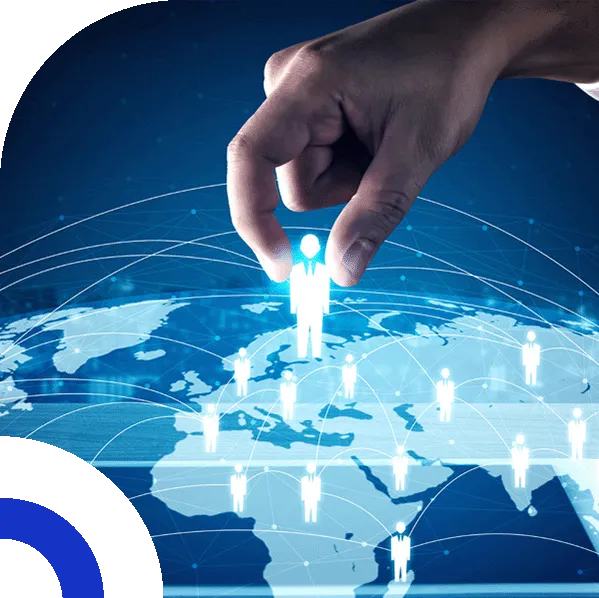
The importance of managing travel risks
Now more than ever, organizations have a duty of care to ensure the well-being, safety, and security of their workforce, no matter where they are. Travel risks are constantly evolving, and your organization needs a travel risk solution that can adapt to changing circumstances and be customized to the specific needs of your business and travelers.
Everbridge travel risk management solutions keep travelers safe by providing important knowledge prior to departure, providing up to date information and location monitoring and incident monitoring during travel, and responding to critical events that can impact travel plans and safety.
Build a successful TRM program
Everbridge Travel Protector
Everbridge Assist, powered by Anvil
Anvil Riskmatics
Benchmarking your TRM program against ISO 31030
Solutions for travel risk management
Organizations looking to implement a successful travel risk management program rely on Everbridge to ensure they can meet industry standards to keep their people safe and secure around the world.
Everbridge Travel Protector TM is a powerful tool that helps organizations care for their employees while they travel. As part of our industry-leading Critical Event Management (CEM) platform, Travel Protector helps companies stay aware of potential threats, provide real-time updates to traveling staff, and use advanced communication technology to keep travelers connected, safe, and informed.
Everbridge Assist, powered by Anvil TM is a one-call comprehensive travel assistance service designed to embrace any event that could impact the health, safety, or wellbeing of a corporate traveler.
Anvil Riskmatics ® provides a comprehensive risk management system that keeps businesses informed and prepared for any potential threats.

Protect your people wherever they are
Facilitate a safe trip.
The Everbridge mobile application travel along with your employees helps to keep them connected and safe, wherever they are. An intuitive interface allows them to receive real-time alerts about emerging threats or live incidents in their locality that could impact them. Should they find themselves at risk or have any concerns about their safety or wellbeing, emergency call and SOS features enable them to request urgent assistance 24/7.
Pre-trip advisory
Information travelers need to know.
Equip travelers with everything they need to know about the country or region they are heading to – from risk intelligence, visa, document and vaccination requirements to advice on security, health, laws and culture.

Monitor and notify travelers
Tools for travel managers.
Access a manager portal with risk monitoring dashboards, including details on employees who are traveling to and from at-risk countries. Locate active and pending traveler destinations based on the most current flight, ground transportation, and hotel itinerary data. Immediately connect with travelers through one- or two- way communication.
Employee and traveler tracking
Track, monitor, and alert.
Virtually travel alongside your employees as they work wherever business takes them, even in unstable and challenging environments. Seamlessly track locations, monitor trip itineraries, and send real-time alerts to employees if they face danger or disruption.
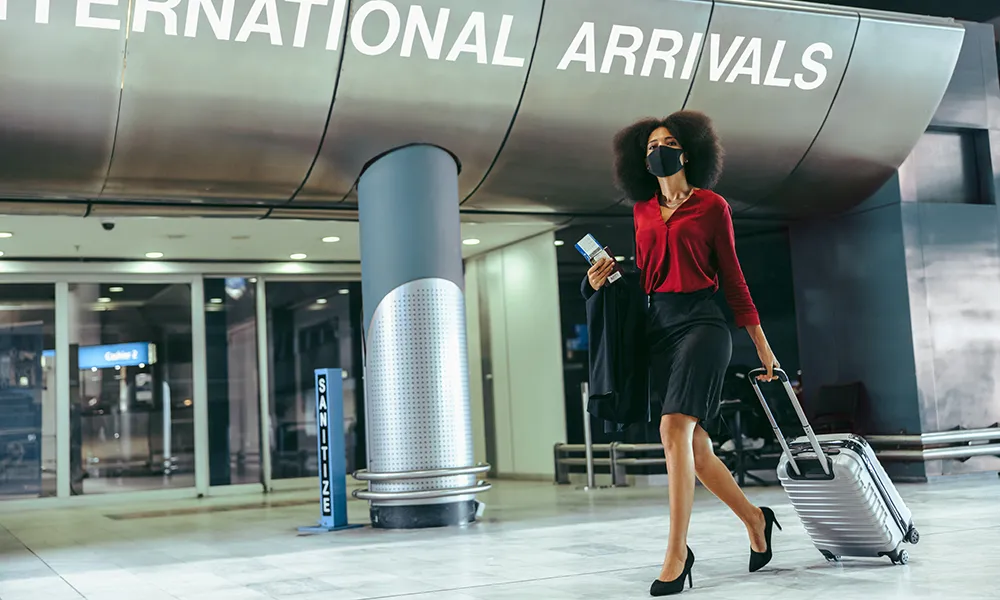
Helping manage critical events for 6,500+ customers globally through billions of interactions every year.
Matthew Judge, VP International – Travel Risk Management
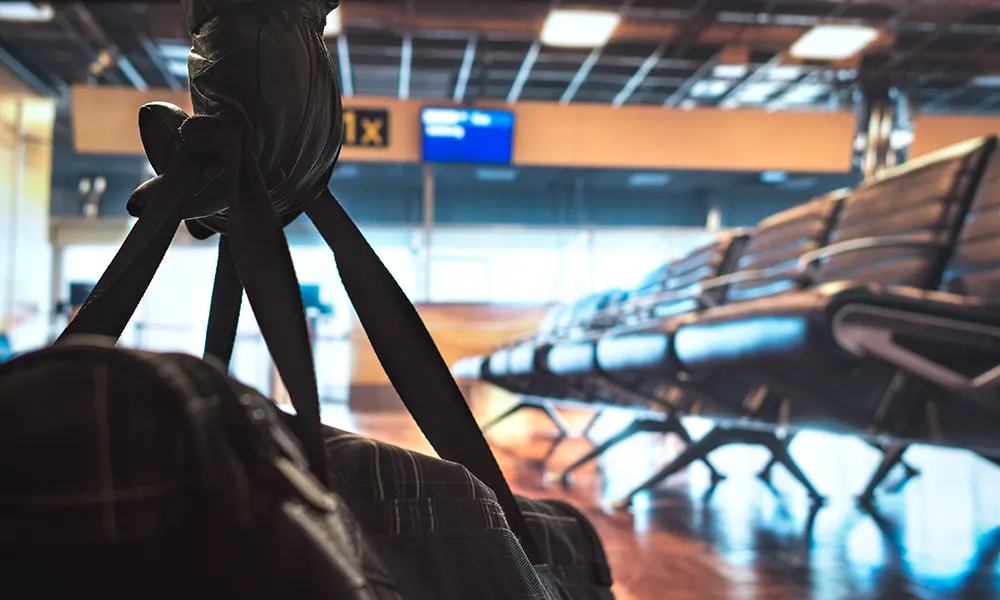
Threat awareness & incident tracking
Heightened situational awareness and response.
Thousands of risk data sources are aggregated non-stop, monitoring emerging threats and live incidents. As threat intelligence related to your employees emerge, a sophisticated alerting system sends real-time notifications with crucial information directly to impacted individuals or those responsible for their safety.
Real-time information
Understand and communicate credible risk information.
Support business travelers and those responsible for their safety with updates by preparing risk assessments to comply with legal obligations. Add your organization’s content, such as your security team’s foreign travel advice, in-country support contacts and approved hotels.

“At Burns & McDonnell, safety is first. With more than 13,500 employees working from 70 offices globally, we are committed to creating safe environments in the office, in the field and while traveling. Everbridge Travel Protector is a robust and reliable solution to unify travel data, pre-trip travel advisories, automated traveler alerting, and dynamic location awareness to help keep our teams safe wherever they go.”
Robert J. “RJ” Hope, CPP, ABCP Principal & Director, Corporate Security & Travel Burns & McDonnell

Emergency communications
Track communication response.
Contact affected personnel during incidents through email, SMS and Text to Voice and confirm people are safe or affected through a response mechanism. Customize the threat parameters that trigger a service. And with a full audit trail of actions taken, Everbridge Travel Protector ™ evidences defendable decision making and provides non-refutable accountability.
Traveler assistance
A higher standard of connected care.
Everbridge Assist ™ is our one-call comprehensive traveler assistance service designed to embrace any event that could impact the health, safety or wellbeing of your corporate travelers or remote workers. Everbridge Assist™ provides multilingual 24/7 medical and security assistance in any difficult situation, wherever it may be around the world. Get an immediate response for your employees, no matter the issue.

Travel can be unpredictable, take control of the unexpected
Effective critical event management (cem) requires a strategy to manage travel risks.
With critical events from demonstrations to severe weather or civil unrest happening every day, anywhere – how do you know your people are safe? Get visibility into travel risks for your employees from the time they book the trip until they return back home.
It is increasingly important to have up-to-date intelligence on global risks to protect your traveling employees. Everbridge Travel Risk Management solutions provide global risk intelligence, employee location data, multi-modal communication, traveler resources and assistance services through one provider. Meet your duty of care standards and ensure your travelers feel safe wherever they go.
The Everbridge advantage
2 billion contacts managed, 5+ billion interactions sent yearly, 200+ supported countries and territories, 200+ thousand sms sent per minute, lvl 3 certified dhs telecom service, 100+ modalities, related resources.

Threats to business travelers on the rise, minimize impact
As these employees continue to be at risk, it is critical that organizations understand that they have a duty of care to protect business travelers domestically and abroad.
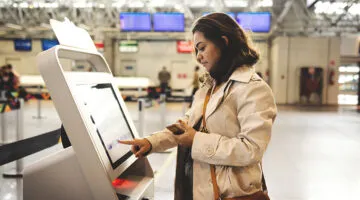
Duty of care
Duty of care is a social contract between employer and employee – the employer agrees to take care of the employee, and the employee agrees to avoid unnecessary risk.
Related products
Travel protector ™.
Obtain 360° threat awareness, dynamic travel intelligence, and advanced communications based on travel data.
Everbridge Assist ™
Multilingual 24/7 medical and security assistance in any difficult situation, wherever it may be around the world .
See us in action
Request a demo or just call us at 888-366-4911
- 24hr Support
- Member Login

What is Travel Risk Management? Top 7 Ways It Will Help Your Organisation
Table of contents, discover how top travel risk management companies go above and beyond traditional travel insurance providers to help support corporate travellers and expatriates..
When it comes to corporate travel, nothing is as straight-forward as it seems.
No matter what your industry or field of study, unforeseen issues can derail even the most well-planned trip. It could be disturbances like cancelled flight or illness, or major situations such as civil unrest, terror attacks or a natural disaster. If this happens, how well equipped is your organisation to handle it and keep your staff safe?
The reality is, organisations with frequent or continuous travelling personnel not only have a duty of care to their employees or students, but they’re also required to manage a 24/7, 365-day a year risk map of activity. Without external support, this can be a daunting task.
What is Travel Risk Management (TRM)?
Travel risk management goes beyond the basic duty of care, providing companies with vital support for their business travellers, expatriates and employees.
While traditional business travel insurance policies may only cover costs should something go wrong, travel risk management companies help take on the responsibility of foreseeing where incidents may occur in addition to providing medical, travel and security assistance in case of an emergency.
Travel risk management companies help reduce stress for both risk managers and travellers by supporting them pre-, during and post-travel. Thanks to their industry expertise, cutting edge risk mitigation technology and 24/7 global support, global travel risk management capabilities and solutions are extensive.
Do you know if your organisation requires travel risk management support? seven key benefits of how it could help:
#1. Access important pre-trip travel advice for your destination
Organisations supported by a travel risk management company can access up-to-date, in-depth information about their destination rather than having to research themselves.
This can include:
- How safe the destination is
- Customs, rules or regulations that may need to be followed
- Current political climate of the country and wider region
- Immunizations required and any current health risks
- Weather risks and natural disasters
- Potential civil unrest or crime levels
“At World Travel Protection, our information and intelligence on a country, city or specific risk at a particular destination plays a huge role in an organisation’s assessment of whether its people should travel to a place, and if they can, what preparation is needed,” says Adrian Leach, World Travel Protection’s CEO.
#2. Receive training to prepare for the unexpected
en the most careful traveller can’t prepare for every potential risk while on the road. However, having the right knowledge and skills to deal with unforeseen situations as they arise could mean the difference between life and death for some.
Top travel risk management companies provide travellers with the relevant intelligence and skills to prepare them for potential incidents or mitigate risks, which helps limit the severity of an emergency.
“Our goal is to enable you and your travelling workforce to make smarter, safer choices,” explains Leach.
“At World Travel Protection, we run various kinds of awareness training so people travel more safely in general, and we can train or brief travellers to handle specific trips and the challenges those journeys might present.”

“Our client’s corporate travellers can also access preventative training tools and materials before departure via our World Travel Protection Travel Assist App.”
#3. Make informed decisions with real-time alerts
If the COVID-19 pandemic has taught us anything, it’s that situations around the world can change drastically in a short amount of time. Receiving up-to-date information about changing conditions around the world is paramount to ensuring traveller safety, and travel risk management companies can provide this intel when it matters most.
“At World Travel Protection, we can help travellers and their risk managers make wise and confident decisions,” says Leach.
“Our 24-hour Command Centres continually assesses international threats and continually assess international threats and alert travellers to potential risks as they arise based on their uploaded itinerary and geo-location feeds. This information helps them make informed decisions about whether to continue with their trip or adjust their itinerary, allowing safer travel.”

#4. Track your team in real-time
It goes without saying that it’s incredibly important for HR staff or risk managers to know where their travelling personnel are at all times. This need increases tenfold if personnel are deployed in regions with identified risks.
Our World Travel Protection geo-location technology is world-class and allows travel risk managers to know exactly where their travellers are at any given time. Using our Travel Assist Portal and Travel Assist App, risk managers and their travelling personnel can communicate with each other as well as our expert team 24/7 to help ensure they receive the support they need.
“We are the first port of call for both travellers and those responsible for them, as we can help ensure duty of care and assistance is provided at speed.”
#5. Travel risk management companies deal with incidents and emergencies for you
When a traveller has travel insurance, it’s often up to them to locate professional help in an emergency situation and/or make emergency alternate travel arrangements. Once the crisis situation is resolved, they then need to get in touch with their insurance company to claim compensation.
Travel risk management companies like World Travel Protection are with business and leisure travellers every step of the way on their journey – not only when they’re home safe and sound.
“For travellers, fatalities, severe illness and critical injuries can be extremely complex to manage, and the efficient communications and information flows are critical,” explains Leach.
When a traveller under the care of our World Travel Protection travel risk management services needs help, our expert medically trained team triage the initial first contact call, using medical best practice – followed by cost avoidance measures – to ensure they experience the right level of care in the right place at the right time.”

#6. Receive efficient, top-level care
Travellers – and their HR managers – can rest easy knowing they’re supported by a top travel risk management company.
During our three decades within the travel risk management industry, our global World Travel Protection teams have built strong relationships with medical leaders around the world, which grants us access to a network of nearly 10,000 providers located on every continent.
If an incident or emergency occurs , our 24/7 emergency assistance Command Centres can work to immediately connect travellers in need with a suitable, quality medical professional near them. Our travel risk management support also includes ensuring there are no financial barriers, language barriers or miscommunication affecting the traveller’s care.”
“We can help manage a traveller’s treatment and understand if they’re in the right hospital,” adds Leach.
“If the traveller is facing a security threat – instead of a medical emergency – our teams can also provide travellers with the immediate advice they need to stay safe as well as assist in the coordination of a plan of action for them to reach a safety point,” says Leach.
#7. Save money
Costs can quickly add up when things go wrong – and expenses can quickly skyrocket if your travelling personnel don’t have the right support or know who to reach out to.
Top travel risk management companies will have international connections and long-standing relationships with medical, security and travel professionals who can provide travellers with the care they need at a reasonable price.
“At World Travel Protection, we continuously strive to challenge, renegotiate and maximise the discounts provided by our global providers’ network,” says Leach
“At World Travel Protection, our 30+ years of experience means we can make well-timed decisions that can help to avoid many costs – and we continuously strive to challenge, renegotiate and maximize the discounts provided by our global providers’ network,” says Leach.
“This results in significant cost savings for our clients, without compromising on their travellers’ level of care.”
Looking for more information on travel risk management
We value the safety of your travellers as much as you do, and we also understand how to support you in providing duty of care for travelling personnel.
To learn more about how our World Travel Protection team can help you manage travel risks and make your employees’ or customers’ safety a priority, contact us today by filling out the form below.
Privacy Overview
Australia command center.
- +1 (800) 826-0777
- Request Demo
Mass Notification
Threat intelligence.
- Employee Safety Monitoring
- Travel Risk Management
- Emergency Preparedness
- Remote Workforce
- Location and Asset Protection
- Business Continuity
- Why AlertMedia
- Who We Serve
- Customer Spotlights
- Resource Library
- Downloads & Guides
TRAVEL RISK MANAGEMENT
- Product Suite
- Request A Demo Product Guide
Keep Your On-the-Go Employees Safe and Informed With Travel Risk Management
Countless factors could impact your employees’ well-being while on the road—from natural disasters to civil unrest. Monitor where your people are traveling, prepare them for potential threats, and respond to any events that pose health and safety concerns or operational liability with AlertMedia’s fully integrated Travel Risk Management (TRM) solution.
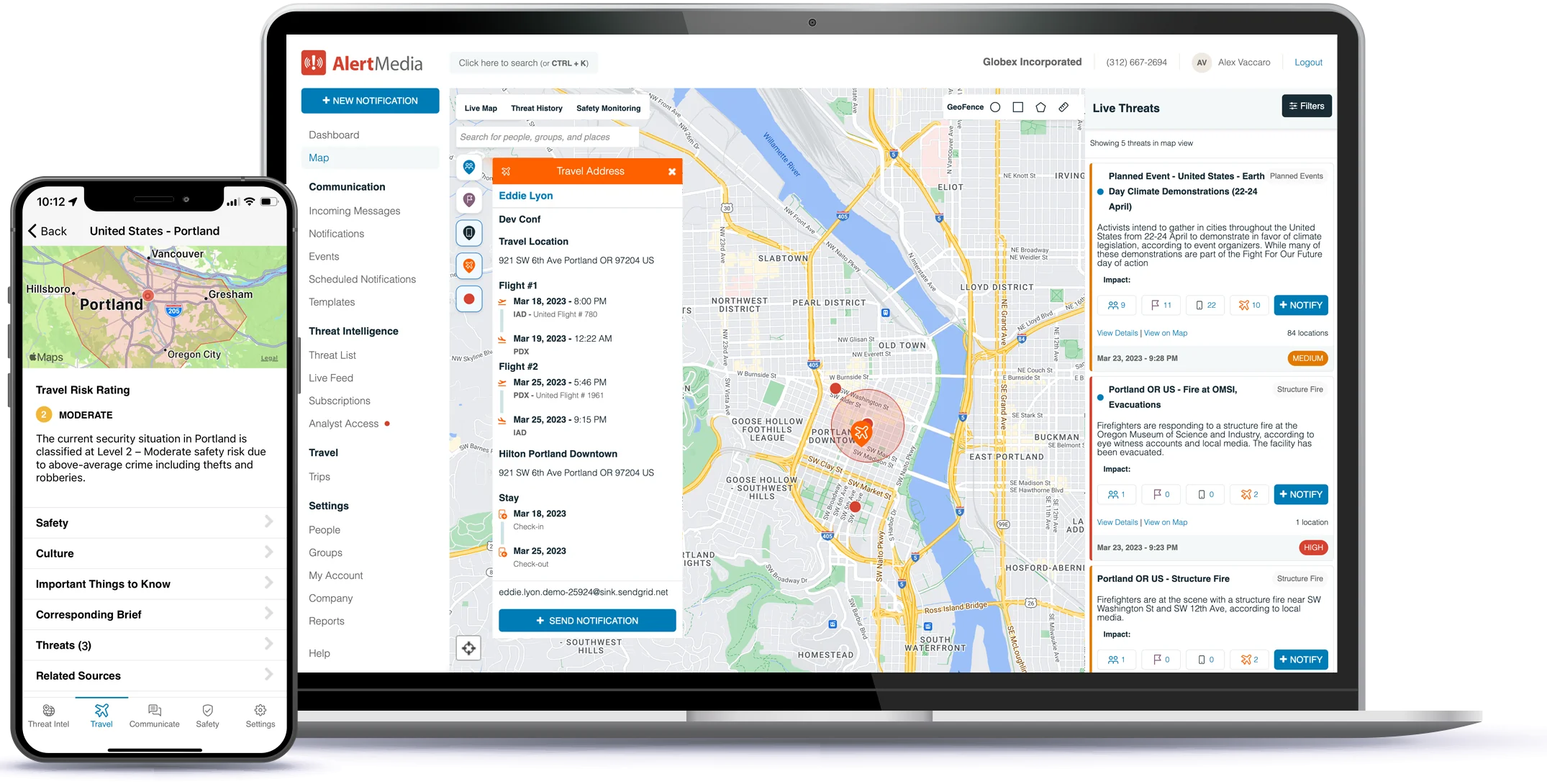
Trusted by Thousands of World-Class Organizations
Safeguard your travelers every step of the journey.
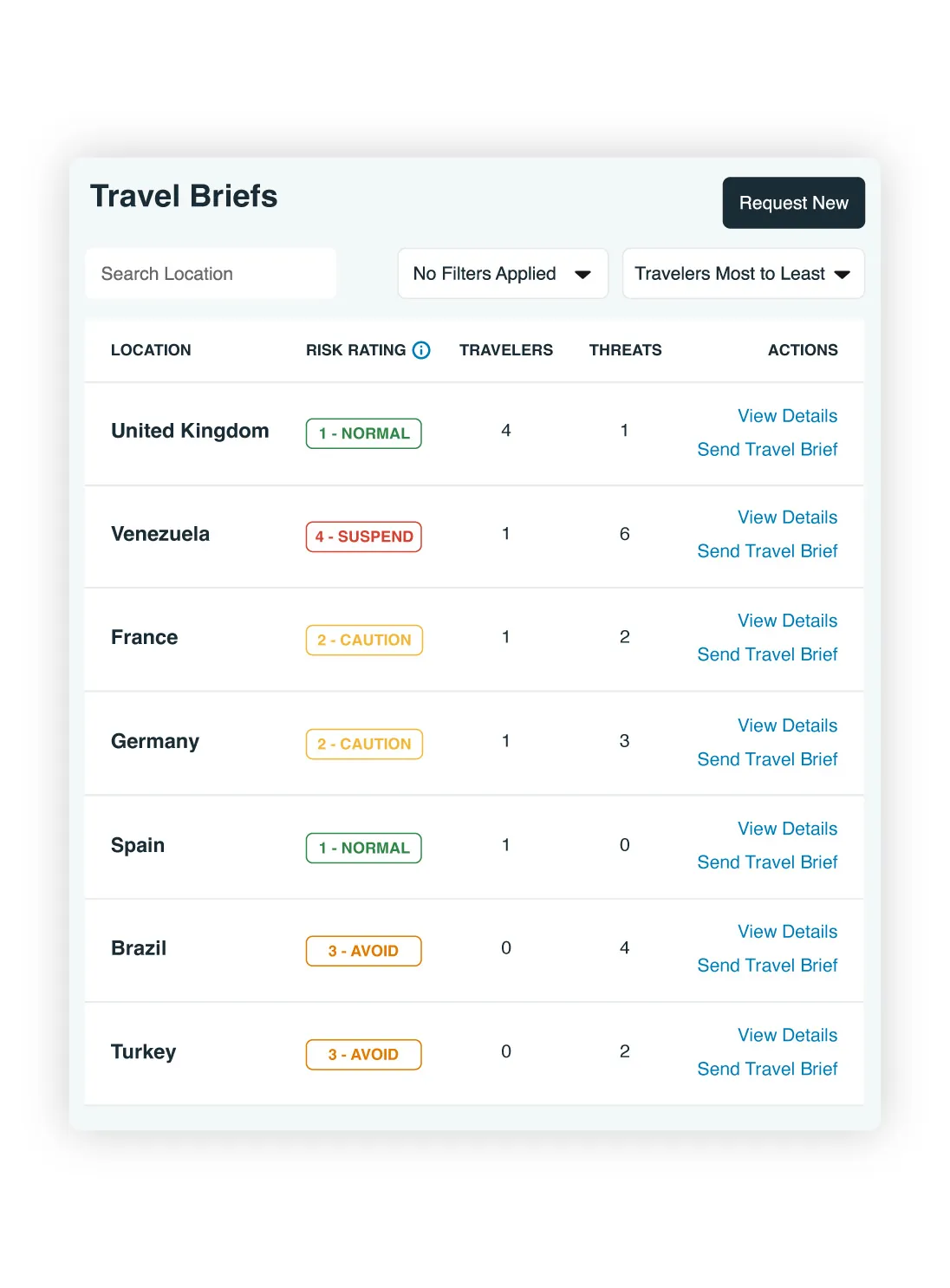
Meeting Your Duty of Care Has Never Been Easier
Real-Time Travel Location Monitoring
Ensure employees are safe throughout their trips with dynamic location monitoring based on itineraries and mobile app tracking.
Expert-Curated Travel Briefs
Deliver pre-trip travel safety briefs ahead of trips to empower employees with situational awareness and critical resources.
Localized Threat Alerts
Receive automatic, localized threat notifications for active and upcoming travel locations and choose how to alert impacted employees.
Integrated Travel Data
Sync itineraries and travel plans automatically from any travel system to stay current on trip details like flights, hotels, and more.
Simple, Robust Reporting
Report on past, active, and upcoming trips to easily keep a pulse on employee travel activity.
Powerful Mobile App for Admins and Business Travelers
Put the power of a real-time travel risk management program in your pocket with a full-featured mobile app.
Discover Everything You Can Accomplish With AlertMedia

Eliminate Unnecessary Stress From Business Travel
What Customers Are Saying

“With over 10,000 travelers a year moving throughout the world, AlertMedia’s Travel Briefs are essential to preparing our employees for safe travel.”

Brandon Spurlock
Head of Security, Oshkosh
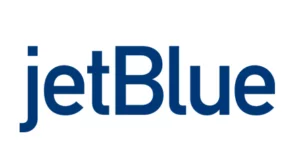
“Finding AlertMedia was like a breath of fresh air. From the start, we were impressed with how the product and people match our core values.”

Penny Neferis
Director of Business Continuity and Emergency Response, JetBlue

“Every company has a baseline responsibility to keep its people safe. But if you want to get and keep the best people, you need to prove you care about them and their well-being. With AlertMedia, we can keep our people safe and secure while also driving positive business outcomes. It’s truly a win-win.”

Mindy Helms
Director of Human Resources, Marquette Management
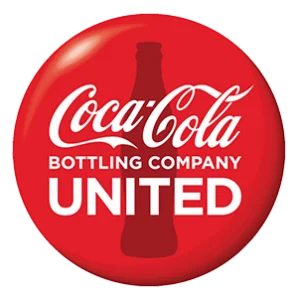
“When you’re separated geographically and there’s so much communication that needs to occur, a tool like AlertMedia helps organizations communicate faster, better, and more clearly.”

Gianetta Jones
Vice President and Chief People Officer, Coca-Cola Bottling
Amplify Corporate Traveler Safety Across Multiple Teams and Functions

See How AlertMedia Customers Keep Their People Safe

Cookies are required to play this video.
Click the blue shield icon on the bottom left of your screen to edit your cookie preferences.

- In-depth research with 127 companies worldwide found that almost all (94%) had embarked on agile initiatives, with two thirds (66%) claiming successful agile transformations.
- But when asked which agile practices they applied and what outcomes they achieved, only about half (53%) said they had realized their transformation targets and created lasting change in their culture, ways of working, and ways of teaming.
- The other half (47%) are operating under the illusion of agility: they adopted the practices and are claiming some success, but they are not reaping the benefits of improved performance.
Subscribe to our Agile at Scale E-Alert.

Agile at Scale
/ article, why companies get agile right—and wrong.
By Michael Grebe , Nicolas Hunke , Nina Kataeva , Erik Lenhard , Jaap Backx , Benjamin Rehberg , and Valerio Gardelli
Key Takeaways
Ask a CEO about agile today, and the response is likely to be, “Been there, done that, moved on.” Many leaders ought to take another, deeper look: our latest research reveals that only about half of the companies that claim high agile maturity have actually achieved their transformation goals and can point to real business impact.
We conducted in-depth research with 127 companies worldwide regarding their experience with agile. Almost all (94%) had embarked on agile initiatives, and two thirds (66%) claimed successful agile transformations . But when we asked which agile practices they applied and what outcomes they achieved, we found that only about half (53%) could be considered truly agile, realizing their transformation targets and creating lasting change in their culture, ways of working, and ways of teaming.
The other half (47%) wrongly believe that they are agile. But in fact, they are operating under the illusion of agility: they have adopted the agile practices and are claiming some success, but they are not reaping the benefits of improved performance in the form of higher productivity (15% to 20% reduction in delivery costs), faster time to market (two to four times faster product delivery), and greater financial benefits (twofold increase in total shareholder return).
Why do companies fail to reach the full potential of agile ways of working? And what can they do to become truly agile and reap the benefits?
Illusory Agile
We took a comprehensive and objective look at what it means to be an agile company and what constitutes success. We examined the changes companies made to their operating models, and we looked at the metrics that define the success of agile transformations. (See the sidebar, “Agile Accounting.”)
Agile Accounting
We then compared the companies that perceive their transformations as successful with those that truly achieved success. Similar percentages of agile companies (91%) and illusory-agile companies (87%) perceive themselves as successful, though some companies in both groups overrate their success. But when you look more closely, by a rate of almost two to one, agile companies realize their goals while illusory-agile companies overestimate their results, according to the eight metrics we tracked. (See Exhibit 1.)

Perhaps the single biggest reason for the difference in perception is that, although illusory-agile companies focus extensively on agile structures and processes, they do not look beyond the surface to implement key agile practices more broadly and achieve real business impact. (See Exhibit 2.) All companies set up agile structures, of course, such as squads and tribes, but illusory-agile companies tend to confine these changes to IT, rather than involving the full business in the reorganization. They overemphasize visible levers (they organize in squads, run sprints, and appoint product owners, for example), which give the illusion of progress. But they do not make the more difficult and substantive changes, such as establishing customer-facing business units fully aligned to value streams, setting up enabling supporting structures that own internal products and platforms, and resetting incentives and rewards. They are much less likely to create a structure with shared capabilities between the business and IT across the organization and involving the business units.

The shortfalls and disconnects do not end there. Illusory-agile companies also fail to make lasting adjustments in four key facets of the operating model, where bringing about real change is often most difficult. (See Exhibit 3.)

Purpose, Strategy, and Priorities. Corporate strategy lies a long distance from most teams’ daily tasks, and many employees have trouble relating what they do each day to what the broader organization is trying to achieve. Agile companies use measureable objectives and key results (OKRs) linked to company objectives to bring purpose and strategy down to the team level.
More than twice as many agile as illusory-agile organizations establish “ an unbroken chain of why ” that connects the business outcomes that the company needs to achieve and the work that individual teams are charged with delivering.
Agile and illusory-agile companies also differ in the goals that they set. For example, 77% of illusory-agile firms make improving time to market their primary goal. Successful agile companies target a broader and more balanced set of transformation objectives, with time to market (66%), productivity (61%), and costs (50%) being at the top. Agile companies don’t need to choose between faster delivery or cost cutting or better products; they can do all at the same time and still be effective.
In our client experience, a big mistake many companies make relates to scope. Businesspeople too often see IT as a bottleneck rather than a partner, so they focus on speeding up IT. If they were instead to collaborate more closely (having product owners from business and not only IT, for example), they would be able to achieve broader goals, including cutting costs or producing better products by streamlining or reinventing end-to-end processes and improving business and IT employees’ collective productivity.
Agile companies also are much better positioned to embrace the latest technological advances. For example, 14% of agile companies report that they use generative AI at scale to create and prioritize business cases, while no illsuory-agile companies do so.
Governance and Funding. Agile and illusory-agile companies also differ in how they handle governance issues, such as decision making, portfolio prioritization, and budgeting mechanisms. While agile companies make significant changes in governance (86%), illusory-agile companies address these factors at a much lower rate (38%). As a result, they do a poor job of adopting iterative governance cycles that allow for frequent performance reviews, reprioritization, and funding reallocation. They do not adapt measurement systems to focus on customer centric metrics. And leadership doesn’t have real-time visibility into the status and outcome of ongoing initiatives so it can intervene when necessary in a timely manner.
Successful agile companies rely on integrated, iterative governance mechanisms (such as annual and quarterly business reviews) and decision-making tools (such as OKRs) to help ensure “real” discussions about their plans and about how to prioritize their work and plan from a joint business and IT perspective. They are also better at deciding—and sticking to—what not to do. The alignment between business and IT, along with strong technology capabilities, gives agile companies the ability to work more efficiently and effectively, reducing waste and friction, lowering costs, and boosting productivity. These companies also learn and adapt more quickly because they monitor progress through annual and quarterly business reviews and can easily adjust delivery pipelines and tools.
Tech Enablers and Data. Modern tech systems and architecture and platform operating models give agile companies real-time transparency into which activities are in the works and where they are spending their time and money. They provide visibility on the results and ROI of these investments. Digital champions have shown that when companies foster data-driven decision making, they gain more immediate visibility and insight into customers and processes. As a result, they can respond faster to evolving situations. “Common tech platforms can make it easier for customer-facing business units to access the data they need to do their jobs. This can lead to faster decision making and improved customer service,” one retail executive told us.
Agile companies are far more likely than illusory-agile companies to have fully applied data platforms, DevOps, and modern technology tools (by margins of 68% to 23%, 80% to 31%, and 59% to 13%, respectively). A cutting-edge tech stack is not a precondition for agile, but companies with modern, modular tech architecture are more likely to reap agile’s full benefits. Among successful agile companies, 79% had a high technology score in our survey.
Performance Measurement. Another difference between agile and other companies is how they measure the performance of individuals, teams, and the organization. A common transformation-related mistake for companies is assuming they can measure success in the same ways that they did before. They need to rethink their metrics to be more (internally and externally) customer focused and to link back to company OKRs.
While more than half of agile companies adjust their performance evaluation and incentive programs, less than 5% of illusory-agile companies do. Agile companies move from measuring progress and outputs to measuring impact and outcomes. They automate measurement and over-index on team versus individual performance metrics. Two thirds of agile companies set up new reward and recognition systems, compared with only 13% of less successful firms.
Full Agile Application
Agile is a means to an end, not the goal itself. Companies need to have the courage to make changes beyond what is easy and visible and address hard changes to the operating model. They must also change behaviors, rethink governance and decision-making practices, and invest in technology. Leadership needs to hold itself and the organization to account and reset the transformation, focusing it on outcomes, not practices.
Change is possible, as the 53% of agile companies in our survey demonstrate. We worked with one large European energy service and metering company that was challenged by conflicting priorities, resource clashes, and operational and organizational silos that were hindering collaboration. The company committed itself to deep structural and procedural change, an extensive revamping of its governance practices and funding logic, and full integration of the business and IT. Key elements of the transformation involved the following:
- Extensive Change in Organization. The company adopted a top-down approach, integrating business and tech in stable squads and tribes, which were oriented by value streams organized around customer journeys and which reported to the CEO.
- Rigorous Prioritization and Commitment. Corporate strategy was translated into prioritized themes for each tribe, which was assigned its own OKRs. Tribe leaders committed to transparent targets and budgets and KPIs.
- Lean Governance Cycles. The company adopted annual and quarterly business review cycles with a focus on outcomes (such as revenue increases and net new customers) and steered by OKRs and KPIs.
- New Technology Design Principles. The company moved from central IT architectural oversight to tribe ownership and to a BizDevOps model, with DevOps and business efforts jointly prioritized.
In about 12 months, the company was able to define, design, and implement the new operating model. Since then, delivery quality and time to market, employee engagement, and attractiveness to outside talent have all improved.
The success of the company’s transformation is evident. But it is not finished. Beyond the initial transition phase, companies need to stress the importance of continuous learning and adapt to evolving circumstances, including the integration of new technologies. Truly agile cultures emphasize continuous execution, follow-through, and improvement.
Companies under the illusion that they are agile have not necessarily failed. But they do need to refocus their efforts. They should start with a candid evaluation of impact metrics, particularly the areas showing scant progress. It’s crucial to reassess the scope and depth of previous changes and to reconsider aspects previously overlooked. A fundamental question is this: Is the business actively participating in the transformation, working hand in hand with IT and other functions? Make sure the answers are honest. Then make a clear plan for action and execute.
Both agile and illusory-agile companies have a common purpose: an unwavering commitment to outcomes and a culture that champions continuous evolution. By instilling an outcome-focused approach that spans all organizational facets, companies can not only navigate the complexities of the digital age but also seize the myriad opportunities it presents.

Managing Director & Senior Partner

Managing Director & Partner

Partner and Director, Enterprise Agility

Lead Knowledge Analyst, Team Lead
ABOUT BOSTON CONSULTING GROUP
Boston Consulting Group partners with leaders in business and society to tackle their most important challenges and capture their greatest opportunities. BCG was the pioneer in business strategy when it was founded in 1963. Today, we work closely with clients to embrace a transformational approach aimed at benefiting all stakeholders—empowering organizations to grow, build sustainable competitive advantage, and drive positive societal impact.
Our diverse, global teams bring deep industry and functional expertise and a range of perspectives that question the status quo and spark change. BCG delivers solutions through leading-edge management consulting, technology and design, and corporate and digital ventures. We work in a uniquely collaborative model across the firm and throughout all levels of the client organization, fueled by the goal of helping our clients thrive and enabling them to make the world a better place.
© Boston Consulting Group 2024. All rights reserved.
For information or permission to reprint, please contact BCG at [email protected] . To find the latest BCG content and register to receive e-alerts on this topic or others, please visit bcg.com . Follow Boston Consulting Group on Facebook and X (formerly Twitter) .

Cyber incidents pose key threat for travel, hospitality sectors, shows survey
The findings of the Allianz Risk Barometer are based on insights from 3,000 risk management professionals and leaders

In the dynamic landscape of risk management, one threat has emerged as the undisputed cause for concern in the hospitality, leisure and tourism sectors: cyber incidents.
According to the latest Allianz Risk Barometer , based on insights from more than 3,000 risk management professionals and business leaders, cyber incidents have surged to the forefront of concerns this year, highlighting the critical need for proactive measures to ensure business continuity and resilience.
With 36 per cent of the respondents expressing concern, cyber incidents have surpassed all other risks to claim the top spot in the sectors.
This shift underscores the growing threat posed by cybercriminals, who are leveraging advanced technologies and tactics to target both IT and physical supply chains.
The recent surge in ransomware attacks has led to a 50 per cent increase in insurance claims activity compared to 2022, further emphasising the urgency of addressing cybersecurity vulnerabilities.
Santho Mohapeloa, cyber insurance expert at Allianz Commercial, sheds light on the evolving nature of cyber threats: “Cyber criminals are leveraging new technologies such as gen AI (generative artificial intelligence) to automate and accelerate attacks, creating more effective malware and phishing schemes.
“The shortage of cybersecurity professionals and the increasing reliance on IT outsourcing among smaller companies further exacerbate the risk landscape.”
Mitigating the impact of cyber incidents
Investment in early detection capabilities, supported by artificial intelligence, is crucial to mitigating the impact of cyber incidents. Without effective detection tools, companies risk facing prolonged downtime, increased costs, and damage to their reputation and bottom line.
While cyber incidents claim the top spot, other risks such as business interruption, changes in legislation and regulation, macroeconomic developments, and natural catastrophes remain significant concerns for the sector.
Business interruption, in particular, has moved down to the number two threat, highlighting the complex web of risks facing businesses in the hospitality, leisure and tourism industry.
Line of defence
To navigate these challenges effectively, the barometer recommends that businesses must prioritise robust business continuity planning, cybersecurity measures, and risk management strategies.
Regular reviews of business continuity plans, robust cyber protection protocols, and leveraging data insights for tailored risk assessments are essential steps in future-proofing operations.
Read: Top 12 tips to keep your business safe from cyber-attacks
You might also like

DET, Emirates partner to jointly promote Dubai’s tourism hub status

Etihad, DCT Abu Dhabi to offer free stopover stays in emirate

Dubai’s Emirates Airline expands retrofit programme to 191 aircraft
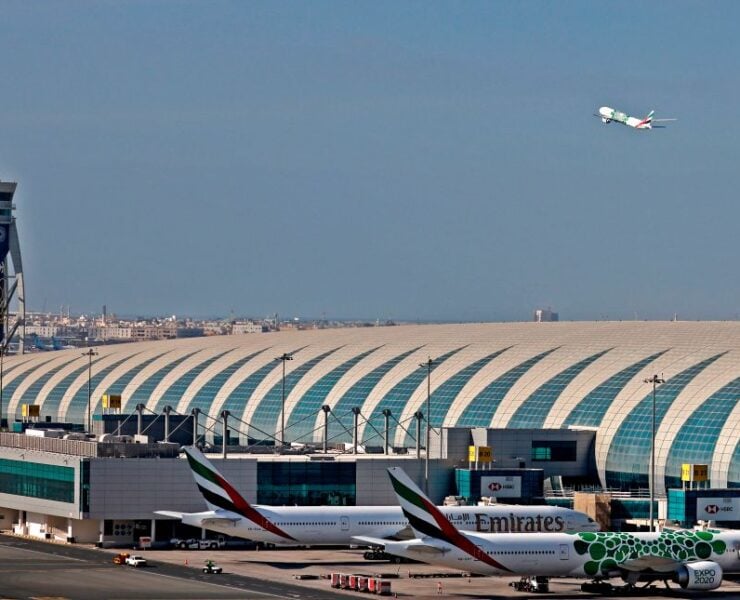
Dubai airport passenger numbers to exceed 90 million in 2024
Every 51st resident in dubai is a millionaire, reveals world’s wealthiest cities report, atm 2024: uae reveals details of gcc’s schengen-styled ‘grand tours’ visa, sheikh ahmed addresses the question of an emirates ipo, latest issue.
- Saudi Arabia
- Real Estate
- Special Report
- Art & Culture
Advertise With Us
Privacy policy.
© 2021 MOTIVATE MEDIA GROUP. ALL RIGHTS RESERVED.
Your Guide to Travel Risk Management

Travel is risky. Travel risk management doesn’t have to be.
Travel is an essential part of any modern business, but it's not without its risks. So, how will your travel risk management programme manage? We’ve compiled the best-in-class knowledge to help you navigate the trials and tribulations of travel risks at every stage, and ensure the safety and well-being of your travellers. We’ll update this page as we develop more resources!
- Introduction - What is travel risk management?
- How do you manage risk in the travel industry?
Be proactive: Risk Assessments
Preventative: informed business travel , preparative: travel briefs , reactive: leveraging travel software .
- FCM - Your travel partner
- Get in touch
What is travel risk management – and what does it mean for you?
Corporate travel risk management (TRM) involves identifying, assessing, and mitigating potential risks associated with business travel. It's not just about keeping your employees safe; it's also about protecting your organisation's reputation and bottom line. In today's world, being proactive about travel risk management is crucial.
Why is it important?
TRM is important for several reasons:
Safety – Ensuring the safety and well-being of your travellers is paramount.
Compliance – Meeting duty of care obligations and legal requirements.
Business Continuity – Minimising disruptions and financial losses.
Reputation – Protecting your company's image and credibility.
Employee Satisfaction – Demonstrating a commitment to employee welfare.
How do you manage risk in the travel industry?
You have a duty of care (DOC) to your travelling employees, but the absence of a unified TRM framework has made it challenging for companies to fulfill this duty effectively. That is until the introduction of the International Organisation for Standardisation’s (ISO) standard 31030 – a document that offers comprehensive guidance for every step of travel.
ISO 31030 presents a comprehensive yet adaptable set of travel safety requirements for any business. It acts as a benchmark for organisations to examine their operations from the ground up, enabling them to establish their own threat assessment process and implement the travel risk solutions that work best for both their travellers and the company.
For the most part, travel risk management is built on four key phases:
- Proactivity
- Prevention
- Preparation
When executed effectively, a thorough pre-travel risk assessment not only fulfills your corporate responsibilities but also instills a sense of security among your travelling employees. This approach ensures that all parties involved are well-informed about potential risks and the corresponding mitigation strategies, eliminating any confusion in the event of unforeseen challenges.
But how do you do a travel risk assessment?
Here is an overview of the risk assessment process:
- Identification of environmental threats.
- Identification of risks associated with individuals travelling.
- Creation of a risk assessment matrix and a comprehensive evaluation of each risk factor.
- Development of a mitigation plan for each identified risk.
- Clear communication of risks and mitigation plans to the travellers, your in-office team, and relevant stakeholders.
- Periodic review and necessary updates to the risk assessment.
The most significant threats to business travellers are those that jeopardise the physical safety of your employees. To proactively address such potential hazards, it is crucial to take preemptive measures even before embarking on the journey.
In certain cases, the most prudent course of action is to avoid specific areas altogether. Utilising highly specific safety ratings from services like threat intelligence systems, which furnish safety assessments down to the neighborhood level worldwide, can be invaluable. Avoiding high-crime-rate areas entirely is the safest option for your travel risk management policy .
For select countries, your organisation should contemplate a categorical decision against creating travel plans to those destinations.
What is the highest level of travel risk?
High-risk – Characterised by war zones, widespread militancy, asymmetric warfare, violent separatist movements, civil wars, major epidemic zones, pervasive violent criminal activity targeting foreigners, or areas devoid of functioning government services, including emergency services, and lacking the rule of law.
Elevated risk – Distinguished by low-level conflicts, including frequent terrorist attacks, high internal tensions (tribal or political), violence often impacting civilians and noncombatants, potentially state-sponsored violence, ineffective rule of law with weak emergency services, and a notable risk of violent crimes against foreigners. Countries may find themselves on this list during periods of uncertainty or volatility.
Watch list – Reserved for countries or regions experiencing trends or impending events that are likely to result in heightened risk in the near future.
In the "Preparative" phase of managing risk, the primary goal is to empower your travellers with information and tools that will enhance their preparedness for their journeys. This phase is all about proactive measures to minimise risks and ensure travellers are well-informed and capable of making sound decisions on the road.
As part of this process, integrating browser extensions that facilitate just-in-time communications during the trip booking stage can be invaluable. These extensions serve as proactive communication channels, providing real-time updates and essential guidance to travellers as they plan their itineraries. By leveraging these extensions, travellers can stay informed about potential risks, safety measures, and any travel advisories specific to their destinations, enabling them to make informed decisions and prioritise their safety while on the road.
See how cutting-edge travel software can bridge the gap between proactive planning and on-the-ground support, helping you respond swiftly and effectively to any travel-related issues.
This advanced travel software provides various features such as push notifications in mobile apps, which keep travellers informed in real-time about any emerging risks or changes in their travel environment. Additionally, predictive reporting is a crucial component, offering insights into potential upcoming challenges, allowing organisations to prepare in advance. Furthermore, live chat functionalities within the software enable immediate, in-the-moment responses to employee concerns and emergencies, facilitating a rapid resolution of issues and the assurance of corporate traveller safety while on the go.
FCM as part of your team
At FCM, we're more than just a service provider. We're your trusted partner in travel risk management. With our expertise and innovative solutions, we can help you build a comprehensive TRM programme that ensures the good health, safety, and well-being of your travellers while supporting your business objectives.
Explore our resources, stay informed, and let us help you navigate the world of travel risk management. Your travellers' safety is our priority, and we're here to support you every step of the way.
Continue reading

Crafting a comprehensive travel risk management policy

Your guide to corporate travel risk assessment

Hitting the ISO 31030 Standard

Building a better corporate travel safety & security programme
Contact us to learn more..
Middle East and Africa
Asia Pacific
- Try for free
- Concur Expense
- Company Bill Statements
- Bank Card Feeds
- Concur Detect
- Concur Benefits Assurance
- Concur Event Management
- Concur Request
- Concur Tax Assurance
- Intelligent Audit
- All products
- Concur Travel
- Concur TripLink
- Concur Invoice
- Payment providers
- Payment solutions
- Purchase Request
- Three-Way Match
- Consultative Intelligence
- Data Delivery Service
- Intelligence
- Concur Advanced Care
- Concur Essential Care
- Concur Select Care
- Concur User Assistant
- Managed Rate Administration
- User Support Desk
- Learn about integrations
- Invoice integrations
- Concur Compleat
- TMC solutions
- Traveler self-service
- TravPay Hotel
- Trip Approval
- Sustainable travel
- Business expansion
- Compliance and risk
- Control company costs
- Duty of care
- Employee experience
- Intelligent Spend Management
- Travel and expense
- Travel in China
- Energy & utilities
- Financial services
- Government contracting
- Legal/professional services
- Life sciences
- Manufacturing
- Non profits
- Oil, mine, and gas
- State & local governments
- Technology companies
- Enterprise finance leader
- Small business finance leader
- Travel manager
- Getting started
- Premium Assistant
- Service Assistant
- All solutions
- Intelligent spend management
- Travel and Expense
- REQUEST PRICING
- About SAP Concur
- CONTACT SALES
- Resource center
- Case studies
- Customer experience
- Mobile apps
- SAP Concur Community
- Expense demo
- Invoice demo
Concur Drupal Menu - Mobile
Compliance with confidence: how sap concur helps organizations spend smarter.

In today’s business world, there are plenty of ups, downs, and sideways turns that come with managing spending and compliance. Your organization needs to be more certain than ever that you’re maintaining your governance, risk, and compliance with internal spending rules, industry regulations, and local laws everywhere you do business. By enabling business leaders and employees to automate travel, expense, and invoice processes, SAP Concur makes it simple to gain more control over spend so you can ensure compliance with sustainability requirements, tax rules, internal budgets, and everything in between.
This free ebook shares six success stories detailing how SAP Concur solutions have helped businesses like yours gain more visibility and control of spending and improve operations. Download it today .
Expense Policy Template
The Travel Manager's Guide to Success
Bring Travel & Expense Together: Adding Options to Your Travel...
- SERVICE STATUS
- REQUEST A QUOTE
- VISIT SAP.COM
- Terms of Use
Six Travel Mistakes to Avoid
No travel medical insurance? Unnecessary luggage and hotel fees? Here are the biggest travel mistakes people make and how you can avoid them.
- Newsletter sign up Newsletter

Even the most seasoned tourists can make travel mistakes when planning a vacation. Some blunders can be minor infractions, but others can cost travelers a lot of money and heartache.
But there are steps you can take to avoid travel mistakes. Here are six slip ups that travelers may make this year, plus tips on how to avoid them.
1. Overlooking travel medical insurance
Christopher Elliott , a consumer advocate and founder of the nonprofit Elliott Advocacy , says many people don’t consider purchasing travel medical insurance . “People often think nothing bad will happen before or on their vacation, but then they get injured overseas and need to go to the hospital, and the next thing they’re looking at is a $10,000 hospital bill.” Indeed, nearly one in four Americans report they’ve experienced a medical issue while traveling abroad, according to a 2023 survey sponsored by GeoBlue, an international health insurance company.
Subscribe to Kiplinger’s Personal Finance
Be a smarter, better informed investor.

Sign up for Kiplinger’s Free E-Newsletters
Profit and prosper with the best of expert advice on investing, taxes, retirement, personal finance and more - straight to your e-mail.
Profit and prosper with the best of expert advice - straight to your e-mail.
Unfortunately, most U.S. healthcare plans — including employer group plans, Medicare and Affordable Care Act plans — offer limited or no medical coverage outside the U.S.
How to avoid: One solution is to purchase a travel medical insurance policy, a type of insurance that provides coverage for a range of medical emergencies while traveling abroad, from minor injuries to major events like heart attacks and strokes, to medical evacuation and emergency transport in the case of severe emergencies.
The average travel medical insurance plan costs $89, according to Squaremouth , a travel insurance comparison website. Squaremouth advises international travelers to obtain a policy that provides a minimum of $50,000 in emergency medical coverage and at least $100,000 in medical evacuation coverage.
Note: Some travel insurance policies include emergency medical coverage and medical evacuation coverage up to certain limits.
2. Getting hit with unnecessary luggage fees
You may have heard that a number of airlines — including American Airlines , Delta , and JetBlue Airways — recently raised their prices for checked bags. But one thing a lot of travelers aren’t aware of, Elliott says, is that some are now charging customers more if they check a bag at the airport versus paying to check a bag in advance. For instance, JetBlue customers flying within the U.S., Latin America, the Caribbean and Canada can save up to $20 on their first two checked bags ($10 savings per bag) when they add them to their flight reservation at least 24 hours before departure.
How to avoid: Make sure to pay ahead of time for any bags that you plan to check.
3. Incurring hidden hotel fees
Wi-Fi fees, early check-in fees, gym fees—hotels today charge guests no shortage of extra fees and surcharges . It’s a widespread problem: In an April 2023 survey by Consumer Reports , nearly four out of 10 (37%) U.S. adults said they had experienced a hidden or unexpected hotel fee in the previous two years.
How to avoid: Many hotels offer to reduce or, in some cases, waive certain fees to guests who join their loyalty program, which is free in most cases. Also, sometimes simply asking an employee at check-in to waive certain fees could do the trick.
4. Not utilizing a key search feature on Airbnb
Like hotels, Airbnb rental property owners often tack on extra fees, such as cleaning fees, fees for additional guests beyond a certain number, and service fees. These additional costs can add hundreds of dollars to your bill.
How to avoid: Elliott praised Airbnb for introducing a feature in December 2022 that allows guests to view a stay’s total costs, before taxes, when searching for rental properties. But he says there’s a caveat: “If you’re in the U.S., you need to change a setting in order to see the full rate when you search for rentals.”
To enable the feature, click the slider on the upper right of the search page that says, “Display total before taxes.”
5. Paying full price for a rental car
First, the good news: “The rental vehicle shortage has improved,” Elliott says. That’s resulted in a stabilization of rates, with rental car prices recently averaging $42 a day, up only 3% from last year, according to a report from the travel search company Hopper. The bad news? Renting a car is still more expensive than it was before the pandemic, especially for travelers who pay full freight.
How to avoid: There are several ways you can avoid paying full price. Big-box stores such as Costco , BJ’s and Sam’s Club provide their members discounts on certain rental cars. AARP and AAA also offer their members discounted rates. ( AARP members save up to 30% on base rates at Avis and Budget Rent A Car; AAA members save up to 20% on Hertz rentals). In addition, a number of credit card companies offer certain cardholders rental car discounts when they book a vehicle from specific rental car companies.
You may also be able to nab a lower rate by prepaying when you book a reservation. And, some rental car companies offer limited-mileage plans at a lower cost, which could be a good option if you’re planning to take just a short trip.
Tip: See if your credit card offers rental car insurance before you pay for insurance from a rental car company.
6. Encountering sky-high hotel rates because of Taylor Swift’s European tour
When Taylor Swift performs a concert, sometimes tens of thousands of out-of-town fans descend on the city, causing hotel prices to spike. Consider: the median rate for a standard hotel room during an Eras Tour date in Europe this year is projected to jump by 44%, with average hotel room prices in Warsaw surging a staggering 154% during her tour date there, according to a recent study by Lighthouse , a travel and hospitality research company.
How to avoid: The simplest approach for Europe-bound travelers in 2024, Elliott says, is to avoid traveling to a destination during a Taylor Swift tour date in that city. “When Taylor Swift comes to town all of the hotels sell out, and it becomes very difficult to find a reasonably priced hotel,” he says.
Related Content
- 24 Best Travel Websites to Find Deals and Save You Money
- Five Ways to a Cheap Last-Minute Vacation
- Best Travel Rewards Cards May 2024
To continue reading this article please register for free
This is different from signing in to your print subscription
Why am I seeing this? Find out more here
Daniel Bortz is a freelance writer based in Arlington, Va. His work has been published by The New York Times, The Washington Post, Consumer Reports, Newsweek, and Money magazine, among others.

The Justice Department is investigating Tesla for potential securities and wire fraud, according to media reports.
By Joey Solitro Published 8 May 24

Uber Technologies reported an unexpected first-quarter loss, sending shares lower Wednesday. Here's what you need to know.

A new Gallup poll shows Americans are still concerned about having enough money for retirement, but there are some changes from last year.
By Alexandra Svokos Last updated 6 May 24

Jobs Report Slower jobs growth and easing wage pressures are good news for rate cuts.
By Dan Burrows Published 3 May 24

Federal Reserve The Federal Reserve struck a dovish pose even as it kept interest rates unchanged for a sixth straight meeting.
By Dan Burrows Published 1 May 24

Investors of all kinds are eagerly awaiting news from the Federal Reserve meeting. Here is live updates and commentary from Kiplinger experts.

Philips agreed to a $1.1 billion settlement over CPAP and ventilator machines.
By Alexandra Svokos Published 30 April 24

A proposed bill could change how the Social Security COLA is calculated, resulting in higher benefits for retirees.
By Erin Bendig Published 30 April 24

Many of the tactics used to increase longevity in "blue zones" are attainable, and as people age longer, habits and financial planning need to adapt accordingly.
By Quincy Williamson Published 24 April 24

Want to keep working, just not as hard? A phased retirement may just be the answer.
By Kimberly Lankford Published 23 April 24
- Contact Future's experts
- Terms and Conditions
- Privacy Policy
- Cookie Policy
- Advertise with us
Kiplinger is part of Future plc, an international media group and leading digital publisher. Visit our corporate site . © Future US, Inc. Full 7th Floor, 130 West 42nd Street, New York, NY 10036.

What Happens If Both Of A Flight's Pilots Fall Asleep?
- Pilots on a recent flight fell asleep unintentionally, which caused air traffic control to have a communication breakdown for 12 minutes.
- ICAO recommends fatigue management practices based on scientific principles for pilots to restore normal functions through rest.
- Safeguards for potential pilots nodding off include pilot rest regulations, cockpit crew scheduling, and controlled and bunk rest options.
Flying can be tiring enough for passengers, but pilots must be alert while at the helm. Recently, there have been several flights where pilots have been caught nodding off. A recent flight on Batik Air is a prime example of this. On a domestic flight in Indonesia, an unscheduled nap resulted in 12 minutes of silence between the aircraft and the Jakarta Area Control Centre.
The International Civil Aviation Organisation (ICAO) has recommended practices and global standards that pilots expect on flight duty. Fatigue management is a critical risk that airlines must comply with to ensure that duty times are complied with depending on the state and country.
Batik Air Warned By Indonesian Transport Ministry After Both Pilots Fall Asleep During Flight
Performance-based approaches allow airlines to implement their fatigue risk systems. The information should be based on scientific principles and operational experience to ensure that it takes into account that pilots have time for adequate sleep to restore normal functions such as alertness, physical and mental performance, and mood.
What happens if the pilot nods off?
Modern aircraft have an autopilot system. If the pilot does not interfere, the aircraft can continue its programmed flight plan until it runs low on fuel. However, the aircraft can still veer off course and have catastrophic consequences.
Get all the latest aviation news right here on Simple Flying!
Pilots are trained professionals who undergo intensive training and are carefully monitored in both psychological and physiological states to ensure they manage all sorts of situations. However, cabin attendants are usually encouraged to check on their captain and the rest of the flight crew every half an hour to ensure everything is ok at the front. Air Traffic Control also plays an integral part in ensuring the flight deck is awake, making contact at regular intervals to ensure that if communication is lost, military aircraft can intercept the aircraft and establish visual contact if required.
While it can always depend on how quickly you can fall asleep, most commercial operators have safeguards in place to mitigate these risks if they were to occur. Let's outline some of these below:
In the United States, the Federal Aviation Administration and the European Union Aviation Safety Agency have established regulations that govern pilot duty and rest periods, stating maximum flight hours and minimum required rest periods to mitigate fatigue.
Cockpit Crew Scheduling
Dedicated airline staff in their scheduling departments are delegated to plan pilot duty schedules. These departments ensure all pilots are scheduled with adequate rest breaks between flights.
Two Person Rule
For long-haul services, it is common for multiple pilots to be onboard. This allows for the duos to swap and take rest breaks while maintaining a flight crew in the cockpit at all times.
Emergency Procedures
Pilots are well-trained to handle emergencies, which could include another crew member's incapacitation. Flight attendants can also be called into the cockpit to help with first aid should the situation escalate.
Get all the latest aviation news for North America here
Two types of rest in the air
As outlined by the ICAO, there are commonly two types of rest a pilot can take in flight. It is important to note that these rules vary from country to country.
Controlled rest
This is where the pilot is allowed to nap in the cockpit unplanned before take-off. This should be no longer than 40 minutes, with 20 minutes following recovery time, and only be permitted during the cruise period up to 20 minutes before the aircraft's planned descent.
Studies by NASA have inferred that controlled rest does improve pilot alertness and performance. This type of rest is a countermeasure to sleepiness on the flight deck. NASA also suggested that 'requiring early report times makes it more difficult for crew members to obtain adequate sleep.'
This is where pilots and flight attendants have their own designated sleeping area on a long-haul flight , on bunk beds built especially for them, usually in an upper or lower compartment on the main flight deck. Pilots have separate areas from the rest of the crew onboard. Usually, pilots or crew have a minimum of four hours of rest time in this space.
How Often Do Pilots Fall Asleep Inflight?
Falling asleep and missing your destination.
While reports of this happening are now less common, on February 13, 2008, the now-defunct Hawaiian carrier Go! Airlines was operating a flight from Daniel K. Inouye International Airport (HNL) in Honolulu to Hilo International Airport (ITO). The captain fell asleep and overflew the airport by 30 miles.
A report by the National Transportation Safety Board showed that a contributing factor was an undiagnosed obstructive sleep apnea disorder, which led the captain to experience chronic fatigue and resulted in him falling asleep at the helm. The day on which it occurred happened to be the third day in a row on which both pilots onboard had started duty at 05:40, with the NTSB report stating:
"This likely caused the pilots to receive less daily sleep than is needed to sustain optimal alertness and resulted in an accumulation of sleep debt and increased levels of daytime fatigue."
VY1002, operated by Go!, had 43 people onboard at the time of the incident. It continued past Hilo at 21,000 feet, heading straight over the open ocean before the pilots woke up. Both were subsequently fired from the carrier, and the captain's license was suspended for 60 days and the co-pilot's for 45 days.


COMMENTS
Travel risk management is a comprehensive, strategic approach that identifies, assesses, and mitigates any potential risks your employees may encounter when traveling — anything from political instability and health concerns to weather extremes and security threats. It's a proactive solution that includes pre-travel training, real-time ...
Abstract. This document gives guidance to organizations on how to manage the risk (s), to the organization and its travellers, as a result of undertaking travel. This document provides a structured approach to the development, implementation, evaluation and review of: prevention and mitigation strategies. This document is applicable to any type ...
The ISO standard 310301 for Travel Risk Management defines travel risk as the "effect of uncertainty on objectives due to travel," which sounds very clinical. I prefer to say that travel risk management (TRM) is about making work-related travel safe for employees, consultants, contractors, interns, expats, and all other types of personnel.
Pandemic aside, a sound travel risk management program goes far beyond considering how to deal with an incident should it happen. To be truly effective, it needs to fully encompass proactive and reactive measures and be part of a company-wide approach to risk. It needs to involve numerous internal and external stakeholders working to the same end.
Travel risk management is the process of safeguarding employees during their journeys by anticipating potential threats and uncertainties. A robust TRM plan includes proactive risk identification, assessment, and mitigation. This is no easy task, because travel risk today goes beyond planning for any singular issue.
Understanding Travel Risk Management (TRM) There are three good reasons to implement an effective TRM program: duty of care, moral and ethical duty, and company reputation. This report summarizes everything you should know about travel risk management. The report has been compiled in collaboration with our Marketplace partner Safeture, a global ...
By implementing a Travel Risk Management System, organizations can put into place an ad hoc strategy to uphold their "duty of care". In other words, organizations fulfill their Duty of care through the implementation of travel risk management procedures. The Travel Risk Assessment activity is fundamental and strategic in terms of safety at ...
Travel risk management (TRM) requires that organizations anticipate and assess the potential for events, develop treatments and communicate anticipated risk exposures to their travellers. Advising and providing travellers with adequate medical and emergency response guidance, security and information security precautions, including challenges ...
Travel Risk Management is a comprehensive strategy aimed at identifying, assessing, and mitigating potential risks associated with travel. It goes beyond merely reacting to crises; it involves proactive planning and execution to safeguard travellers and their interests.
Travel risk management is the process of evaluating and identifying areas of risk, vulnerabilities and threats to all aspects of a business - from revenue streams to stock management and supply chain problems. Identifying new risks is part of the on-going decision-making process within a business. It's important for a business to carry out risk ...
Corporate travel risk management (TRM) involves identifying, assessing, and mitigating potential risks associated with business travel. It's not just about keeping your employees safe; it's also about protecting your organization's reputation and bottom line. In today's world, being proactive about travel risk management is crucial.
Travel risk management (TRM) is a comprehensive, consistent and proactive approach to protecting your people and your organization from travel risks. The broader notion of travel risk management and duty of care is not just linked to how well your organization can respond to a crisis—but rather, how well equipped it is to actually help ...
Travel Risk Management can be defined as a comprehensive approach aimed at identifying, assessing, and mitigating potential risks associated with business travel, whether domestic or international. This proactive approach to TRM encompasses various elements such as health and safety, security, legal considerations, and cultural awareness. ...
Defining travel risk management (TRM) ISO standard 31030 defines travel risk management as " the effects of uncertainty on objectives due to travel .". Quite simply, what this really adds up to is making work-related travel safe (r) for employees and other people traveling on a company's behalf. The standard further describes TRM as ...
Corporate travel risk management is a multi-faceted, proactive, and persistent approach to securing the workforce from travel risks. Strategies of corporate travel risk management during business travel cover three critical aspects: Prevention: Real-time travel alerts help prevent travel risks, like natural calamities.
Whether you're looking to bring on a travel risk management provider for the first time or have partnered with one for years, it's important to make sure you bring in a team with the right resources for your organisation. When reviewing providers, it can be hard to know what questions to ask. You might be comparing two or three that seem ...
Travel Risk Management (TRM) is a comprehensive, consistent, and proactive approach to protecting your people and your organization from travel risks. Many companies and organizations are familiar with Duty of Care Planning, the legal obligation to ensure the safety of your international and domestic business travelers, and TRM puts this plan ...
Everbridge travel risk management solutions keep travelers safe by providing important knowledge prior to departure, providing up to date information and location monitoring and incident monitoring during travel, and responding to critical events that can impact travel plans and safety. Build a successful TRM program.
Travel Risk Management is the practice of anticipating, preventing and reacting to unplanned risks that travellers may face on their journeys. This can include extreme weather events, social unrest, terrorism, natural disasters, public health events like pandemics, and much more.
Travel risk management helps you address potential issues and respond quickly and efficiently if an incident occurs. When you put the framework in place to prevent travel-related incidents, you can avoid unexpected costs, legal issues, and potential damage to your company's hard-won reputation. Business travel can be filled with surprises.
Travel risk management companies help reduce stress for both risk managers and travellers by supporting them pre-, during and post-travel. Thanks to their industry expertise, cutting edge risk mitigation technology and 24/7 global support, global travel risk management capabilities and solutions are extensive.
Countless factors could impact your employees' well-being while on the road—from natural disasters to civil unrest. Monitor where your people are traveling, prepare them for potential threats, and respond to any events that pose health and safety concerns or operational liability with AlertMedia's fully integrated Travel Risk Management (TRM) solution.
Travel and Tourism. Travel and Tourism. Travel and Tourism The industry has suffered an unprecedented shock. BCG collaborates with travel and tourism providers as they navigate this turbulence and build resilience for the future. ... Risk Management and Compliance BCG's Risk and Compliance consulting supports their client's growth ambition with ...
In the dynamic landscape of risk management, one threat has emerged as the undisputed cause for concern in the hospitality, leisure and tourism sectors: cyber incidents. According to the latest ...
Corporate travel risk management (TRM) involves identifying, assessing, and mitigating potential risks associated with business travel. It's not just about keeping your employees safe; it's also about protecting your organisation's reputation and bottom line. In today's world, being proactive about travel risk management is crucial.
In today's business world, there are plenty of ups, downs, and sideways turns that come with managing spending and compliance. Your organization needs to be more certain than ever that you're maintaining your governance, risk, and compliance with internal spending rules, industry regulations, and local laws everywhere you do business.
The average travel medical insurance plan costs $89, according to Squaremouth, a travel insurance comparison website. Squaremouth advises international travelers to obtain a policy that provides a ...
Fatigue management is a critical risk that airlines must comply with to ensure that duty times are complied with depending on the state and country. Related
Gateway is the online platform for BBC staff to access various systems and resources, such as email, password reset, editorial guidelines and safety information. Gateway also allows staff to manage their personal details, payslips, benefits and learning opportunities. Log in to Gateway to explore the BBC staff portal.